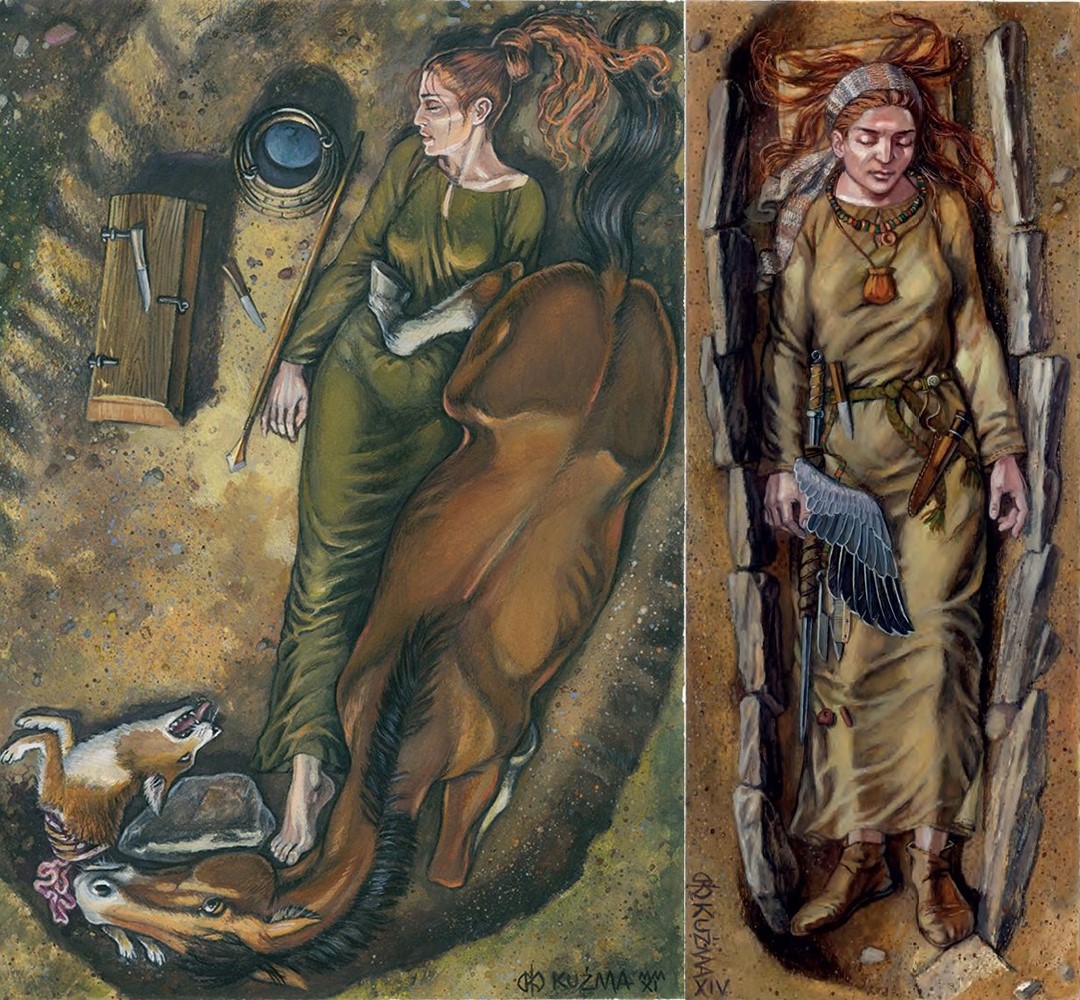
A NEW APPROACH TO INTERPRETING THE PURPOSE & FUNCTION OF
VOLUR STAFFS CARRIED BY SEIDR PRACTITIONERS

For over 100-years archaeologists and those interpreting the artefacts they find, have been mystified by the occurrence of staffs/rods/wands found in the elaborate graves of, for the most part, women and situated in, predominantly, Scandinavia.
A few similar finds of these enigmatic objects, composed of both iron & bronze parts, have been located in Russia & Poland and all the way to Ireland. At least two of the so-called wands are wood, one preserved within a chest of the Oseberg Viking ship burial and another, adorned with scale-like carved features, found to be well-preserved within a bog.
But what could these objects have been used for?
An article in the Staten’s Historika Museum website states:
The Old Norse word for seeress, völva, was probably related to the word vǫlur, meaning staff. A völva is a staff-bearer, and the staff was the tool she would use to prophesise. A few staffs have been found in the graves of women. These finds confirm that seeresses did exist. But what their position and function in society was is unclear.
Researchers disagree as to whether the völva wielded influence from a central position in society, or whether she lived as an outsider. The written sources and archaeological finds paint conflicting pictures.
Theories related to the question of what the Volva staffs were used for range from:
1. “Roasting spits” for cooking meat and other foodstuffs over an open fire. This would, of course, not include the wooden ones.
2. “Staffs of Sorcery” related to “Seidr” occult practices (mostly considered as a dark art of magic, spells & curses, divination and prophecy).
3. "Spinning tools", used to create wool threads from raw fleece, for the knitting or weaving of garments. Somewhat similar designs to the burial staffs are used to this day in re-enactments of traditional spinning crafts.
4. "Measuring rods", although proving such a function has remained elusive or, seemingly, nigh-on impossible to decipher.
The most academically neglected choice for serious study in the above line-up is that of “Measuring rods” and there seems to be little or nothing in the scholarly literature that attempts to broach that line of investigation. Failure to do so has, thus, limited the parameters of interpretation for possible roles played by these “wise women” and their male counterparts.
With nothing to suggest a more practical or benevolent role-function being imparted by these travelling advisors to society, less prestigious roles, often associated with a degree of malevolence, mind control, manipulation for self-gain, or using tactics of superstition and fear, have become the sole choice for scholarly interpretation.
But what if the Volva-Seidr practitioners were just “wise women” after all, acting in fully positive roles as learned, highly-trained advisors on how to avert such things as famines or other set-backs to agricultural abundance? What if they understood the conjoined cycles of the Sun, Earth and Moon over the 18.613-year lunar nutation period, where these celestial bodies spin out of synchronised coordination with each other, then drift back into unison to repeat the whole, tri-body, cycle-dance anew?
The foremost determining factor in weather conditions is the gravitational attraction shared between the Earth and Moon. Added to that, the Earth & Moon seasonal position around the Sun, in either cold, wintery or hot summer conditions significantly affects the weather.
Longstanding experience, handed down for millennia from forebears, could give a reasonably fair estimation as to when the droughts or heavy snowstorms, etc., would occur during the 6804-day cycle’s duration and how long adverse conditions would endure; what seas were too dangerous to venture onto at certain times or whether the Moon was going to be a good (benevolent) one or a bad (dangerous) one in a particular season, place or time.
Is it possible that the so-called magic staffs or wands, carried by the Volva women, were, more simply, “memory-devices” for recall of special numbers, related to astronomical cycles, navigation, the lunisolar calendar and what the coming season might bring? Did these wise women possess a profound knowledge of customary weights, measures & volumes, essential for market-place transactions and public assurances that volumes paid for were true?
Were special, memorised numbers built into the staffs - wands … numbers that a functioning society needed to religiously maintain if the concept of regulated, peaceful and abundant civilisation be preserved?
Before attempting to identify what measurements a wandering Volva seeress / savant would need to encode within segments or sections of her staff/rod/wand, we have to know the base increment being used to generate the sought-after, scientific, number values.
As it turns out, this is less of a mystery than most people realise, as the highly-developed metrology systems of the great civilisations living, from remote antiquity, around the Mediterranean Sea Basin, across the vastness of Continental Europe, the British Isles and elsewhere are reasonably well-known and well-documented ... although, through neglect and declining knowledge over the past thousand years, many standards “drifted” slightly off the mark resulting in the very significant, original numbers being only half remembered.
The old measures, instead of being corrected to the original core values, were then unceremoniously dumped out the door with the introduction of metrification and the ages-old sciences, encoded by numbers, were lost from memory or obscured.
IT'S ALL ABOUT NUMBERS.

The Great Pyramid of Egypt and other pyramids of the Gizeh Plateau acted as a Bureau of Standards from which the civilisations of antiquity, extending to modern eras, based their Weights, Measures and Volume Standards.
It was obviously realised in remote antiquity that if one is to enjoy the abundance and benefits of "CIVILISATION", then there is a body of essential, prerequisite, scientific knowledge that must first be gained. Once a civilisation has that knowledge, then its “wise-ones” (the few set aside to bless the many) must religiously preserve it and hand it on intact to each ensuing generation. Failure to do so means that one has just cursed one's children and, to whatever degree the knowledge is lost, so too is lost one's grasp on civilisation.
One truth that will come as a surprise to some is that the "so-called" British Standard "inch" and "foot" are very ancient and all of the cubits or feet of the great civilisations of recorded history in the Mediterranean-Continental European-British Isles theatres were based upon the self-same inch. Moreover, all of the measurement standards of one civilisation were either the same, or precise ratio expressions to the standards of the surrounding confederation of cousin civilisations.
Everyone used the same integrated parcel of factorable numbers to describe their cyclic or astronomical sciences and the way they eternally recorded those sciences was by incorporating those special numbers, by code-bearing lengths and angles, into public buildings/ edifices or portable memory devices.
Even much earlier in history, extending from the Neolithic Age, the sprawling marker-mound complexes and multitude of standing-stone circles were eternal repositories of the special numbers, (extractible by length and angle calculations from a hubstone to an outlier stone). Added to that, specialist teachers carried mnemonic devices into which the numbers were encoded and this, as it turns out, included the carefully fabricated “Volva staffs” of the travelling, wise women of Europe.
In the 19th century J Ralston Skinner, American archaeologist, did extensive investigations and measurements of Ohio's expansive, ancient, geometric earth-embankments. Skinner's conclusion was that the mound builders of the Ohio Valley had positively used the increment that today is known as the British standard inch in the design and construction of the geometric complexes. See: Skinner, J. Ralston. "Identification of the British Inch as the Unit of Measure of the Mounds of the Ohio Valley Builders." Journal of the Cincinnati Society of Natural History Vol. 9 (July 1886), pp. 51-63.
This journal could formerly be accessed online by going to: Cincinnati Historical Society Digital Journals.
Likewise, Sir William Flinders Petrie deduced that the "inch" used on the Great Pyramid was within 1/100th of an inch (visually undetectable) to the British Imperial Inch. Other researchers had come to similar conclusions, one of which (Taylor) put the Pyramid Inch to within 1/1000th of the Imperial Inch.
The finalised, big numbers that had to be remembered by ancient civilised society might look reasonably unfriendly. This is because nature has a bad habit of running cycles to its own schedule, without consulting accountants. A solar year is 365.2422-days and a lunar year is 354.3643519-days. The lunar nutation cycle, where the Moon goes to a position called major standstill, returns to minor standstill, then returns to major standstill again, takes 6798.36-days or 18.61329277 solar years. The Earth is 24902.44523-miles in equatorial circumference. The polar circumference is 24816.55084-miles. The cycle of the Precession of the Equinoxes takes 25776-years to complete.
So, with these cumbersome, non-factorable numbers to contend with, how did ancient scientists turn this chaotic set of difficult values into an ordered, integrated and functional mathematical system?
A wonderful little window of opportunity arises when a straight-line diameter, using an "11" number is converted to a "6" based circle using PI @ 314 & 2/11th ÷ 100 (1728/550th). Therefore 550 X this rendition of PI = 1728, which is fluidly divisible by 360°.
A wonderful little window of opportunity arises when a straight-line diameter, using a "6&7" number is converted to an "11" based circle, using PI @ 22/7. Therefore 525 X 22/7ths = 1650, which is divisible by 330, 660 or 360°.
A wonderful little window of opportunity arises when 1/7th of a 360° circle (51 & 3/7ths°) is multiplied by 1.75 = 90. A 630° compass will work very well using "7" series values.
If the cycle of the Precession of the Equinoxes is described as 25920-years, then that's 72 X 360.
If the lunar nutation cycle is described as 6804-days, then that's 19 & 1/5th lunar years, which is nicely divisible by "6&7".
On the basis of these "big" numbers, which had been "factored" to be in very close tolerance to the true size of the Earth or duration of cycles, the ancient civilisations then produced their "Weights, Measures & Volume" standards in direct compliance to the highly factorable numbers generated.
Therefore:
What (much later) became known as a "Greek" foot has an overall length of 12 & 3/5ths British standard inches (one tenth of 126"). A Greek foot is simply half of an Assyrian cubit or a tenth of a Hebrew Reed (10 & 1/2 British standard feet). Babylonian-Sumerian or Egyptian standards, as well as ancient Swedish, Germanic or many others preceding the fledgling Greek & Roman civilisations, comply to this same integrated system. All are in direct ratio to the standards of their cousin nations or more distant forebears of remote antiquity.
It is this (above) scientific information that the highly trained Volva seeresses/savants encoded into their memory device wands, for recall as needed when imparting agricultural, navigational, calendar-related knowledge or weights-measures-volumes advice & tutorials.
This was the “magic” to be found within the wands and nothing else, which will come as a disappointment to the “Harry Potter” Appreciation Society.
Here below is an example of a typical Volva wand. This one is more complete than many of the other few surviving wands found amongst the, over, 1000-year-old grave goods. In many cases the important positional marks, at intervals along the rods, are destroyed by rust, rendering original measurement codes difficult or impossible to extract. However, distances between surviving brass knobs still carry all-important measurements.
This Volva wand shown, is a mix of both iron and bronze components and it would have been difficult, labour-intensive and undoubtedly expensive to produce. The quality of the workmanship and materials would suggest strongly that it was a prized possession and not to be used for something as mundane or susceptible to destruction as a cooking-spit or fireplace-poker.

Artefact SHM9060, housed in the collection of the Statens Historika Museum, Stockholm, Sweden.
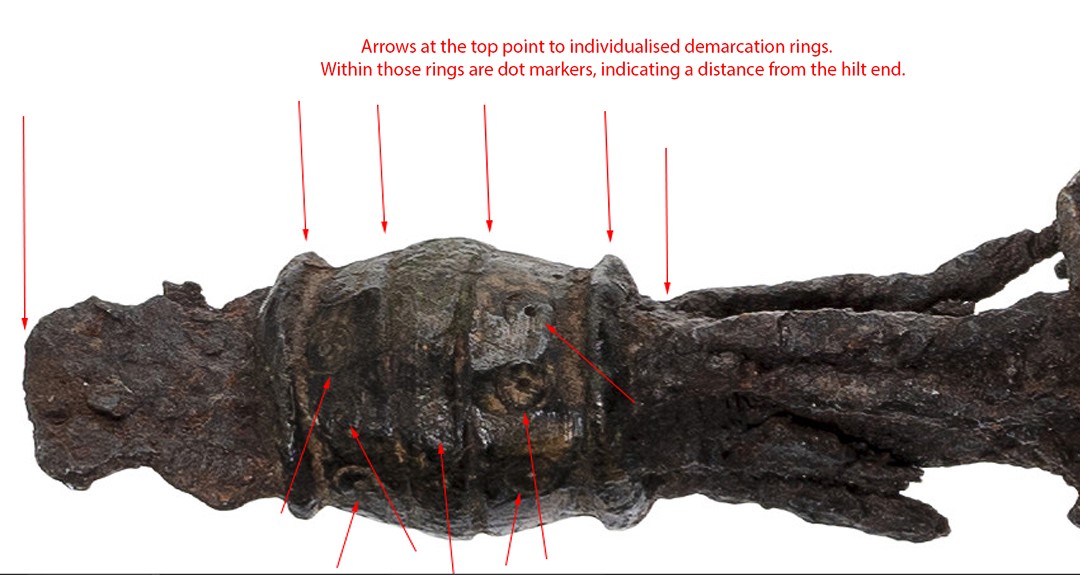
So, despite over 1000-years of degradation, loss of features due to rust and crush damage, rimmed sections and small, centrally dotted, bullseye features have survived intact. The sides and top of the circumnavigating rim rings provide design-encoded distance readings from the hilt end, as do the dot makers within their boundaries.
So, let’s begin an analysis of encoded measurements along the length of a Seidr mnemonic device, rendered in inches and fractions thereof, as used and understood by the staff bearer, then explain the significance of the numbers generated.

Iron staff with fragmented cage handle in the upper part. The handle was kept in place by two polyhedral bronze knobs. A third, with ring and dot decoration, is positioned approximately in the middle of the staff. The actual cage consists of a number of twisted rods which are held together in the middle by a circular bronze disc decorated with crosses. Grave find, Birka, Bj 834, Adelsö Parish, Uppland.
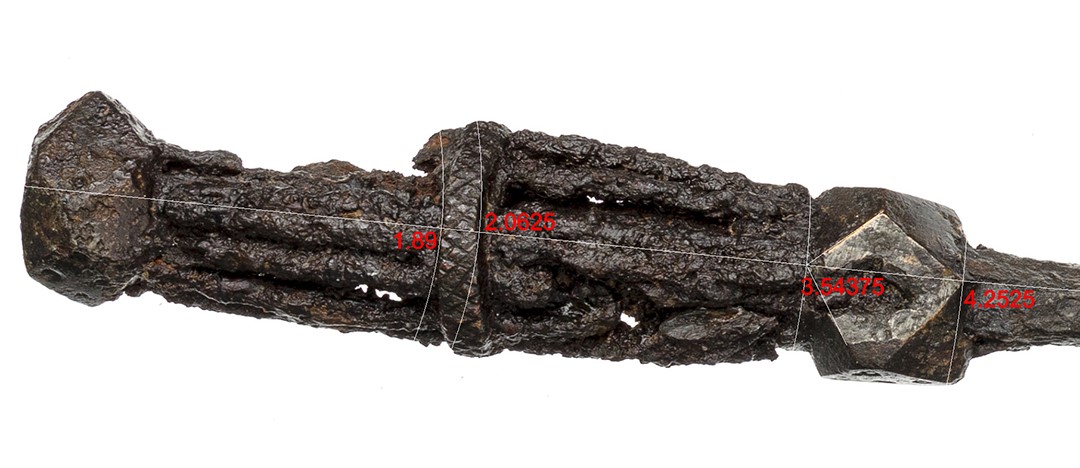
A very high-resolution photograph of the staff was taken into AutoCAD and scaled precisely using the adjacent scale bar supplied with the museum photograph. Measurements were then made from the hilt end or pommel-cap (Station1) to stations along the length of the entire staff. Four geometric-face bronze knobs and a knurled ring below the handle divided the staff into 5 sections and the design features gave the distinct impression of a rule-device, encoding important measurements.
In the above line-up of code-bearing sections of the handle, the distances from the hilt face are:
Station1 to Station 2 (knurled bronze ring), extending to station 3 (bronze knob).
1.89”, 2.0625”, 3.54375” and 4.2525”.
Although the numbers, with their long strings of decimals might look quite intimidating, they are simply whole numbers and simple fractions that were in wide usage within the great civilisations of the Mediterranean Basin, Continental Europe and the British Isles from remote antiquity, up until more modern times. Generally, these values were rendered as full numbers like 189 or a whole number and simple fraction like 354.375 (354 & 3/8ths), etc.
So, what did the numbers mean to the wandering wise women (sagesse-savants) who owned the wands/ staffs and, as advisors to their countrymen, what needful, scientific information were these women dispensing to the agrarian or maritime communities?
The numbers themselves are the beginning values one uses when building a mathematical progression. The mathematical progression, in turn, divulges scientific information related to the cycle of the Moon, the equatorial circumference of the Earth, how to have a lunisolar calendar system and monitor the Earth’s position around the Sun, as well as the Moon’s position in relation to the Earth, for every day throughout a long enduring, but repetitive cycle (6804-days).
The mathematical progressions, of which there were many, were widely used for navigation and positional plotting at sea by the Scandinavian Vikings, as well as all the other cousin, maritime civilisations contemporary-to or before the Viking Age. The special parcel of numbers had been handed down to ensuing generations for thousands of years.
All of the ancient Weights, Measures & Volumes standards, essential to trade in the marketplaces or the grain-weight of coins in circulation for payment of goods received, were fashioned upon this parcel of special numbers.
1.89
Here are the 189 value’s attributes in a mathematical progression, accompanied by the dynamic encoded information it contains:
1.89, 3.78, 5.67, 7.56, 9.45, 11.34 … 15.12 … 17.01… 18.9 … 22.68 … 24.57… 28.35 … 30.24 … 60.48 …6804 … 130636800
All of the above values are encoded into the base length of the Great Pyramid of Gizeh, which, in conjunction with the other pyramids on the Gizeh Plateau, once represented a central, very anciently built, Bureau of Standards. For many thousands of years other cousin civilisations, in satellite countries, or far-flung colonies on other continents, used the in-built numerical codes of these pyramids in all of their Weights, Measures & Volume standards.
For these cousin civilisations, every weight, measure or volume used had to contain and preserve scientific information essential to the preservation of CIVILISATION itself. This means that every “weight” had to be based upon a specific number of “grains” (mostly of healthy wheat … over long ages … but, in much later, Mediaeval eras or in colder climes, barley-corns were substituted in).
Every “measure” capacity needed to represent, say, an incremental division of the equatorial circumference of the Earth, or period of the Moon, etc. Every “volume” needed to be in cubic inches and precisely encode a number representing, say, the lunar cycle, the Precession of the Equinoxes cycle or an incremental value related to the equatorial circumference of the Earth, etc.
Note: The many ancient coins circulating around Mediterranean Basin countries, Continental Europe or the British Isles, etc., used these special numbers in the grain-weights of the coinage.
In the above line-up, 189’ is 1/4th of the base design length of the Great Pyramid, 378’ is ½, 567 is 3/4ths and 756’ a full side length. The number 3024’ was ½ a minute of equatorial arc for the Earth and 6048’was 1-minute of arc … building to 130636800’ for the full equatorial circumference under the Great Pyramid’s literal navigational system … 12 X 12 X 12 X 12 X 1.2 miles of 5250’ (later adopted by the Greeks as their mile @ 5000 Greek feet of 12.6 inches each).
In the above line-up, the values 189, 567, 1701 … extending to 3402, 5103 & 6804 are intervals, in days, within the lunar nutation cycle and there would be 360 X 18.9-days (453.6 hours) in the 6804-day cycle.
Note: The Great Pyramid has always had a flat top floor, set at 453.6’ above ground level. In all recorded history it was never observed to have a pointed top or capstone, but was a truncated pyramid.
Although we’ll not comment in any great detail upon traditional Swedish volume measures at this juncture, the value 1890 occurred in relation to the Fjärding wet volume, which, beyond the Viking Age, “drifted” ever-so-slightly off the original value and was only half-remembered … possibly due to the predations of Christian influences and dissolution of the old, so-called, Pagan ways.
|
Swedish dry volumes (Light) |
Swedish wet volumes (Light) |
Small Tunna = 8960 cubic inches. |
Fjärding = 1890 cubic inches. |
Fjärding = 1120 cubic inches. |
Kanna =157.5 cubic inches. |
Kappe = 280 cubic inches. |
Stop = 78.75 cubic inches. |
Kanna = 160 cubic inches. |
Kvarter = 19.6875 cubic inches. (19 & 11/16ths). |
Skäppa (Bohuslän) = 2240 cubic inches. |
Jungfru = 4.921875 cubic inches. (4 & 59/64ths). |
Skäppa (Västergötland) = 1792 cubic inches. |
|
Skäppa (Småland) = 149.3333 cubic inches. |
|
Note: King John of England (monarch from 1166 AD until his death in 1216 AD) introduced a barleycorn grain weight standard, of which his largest weight, called a “Pile” was 189000 grains.
THE EQUATORIAL CIRCUMFERENCE OF THE EARTH CODES
2.0625
The second position on this (circa 800 AD) Scandinavian Volva, Seidr rod shown is 2.0625”.
There were three known Egyptian Royal Cubits at slightly different lengths, one @ 20.61818182” (20 & 34/55th), 20.625” (20 & 5/8th) and 20.736” (20 & 92/125ths).
Each of these was solely for mnemonic recall of the equatorial circumference of the Earth under three navigational systems and the method employed to do the reading was to take the length of the cubit and multiply it by 1200 then read the result in miles of 5280’.
The formula for finding the shortest of the Egyptian Royal Cubits is to take the inch length of the Great Pyramid (9072") and divide it by 440. Therefore: 9072 ÷ 440 = 20.61818182” (An example of this size ERC is found at the Turin Museum). This value X 1200 = 24,741.8181814-miles of 5280’ or 24883.2- miles of 5250’ (which became known as Greek miles). A whole navigational system, based upon the numbers 6&7, was used by the Greeks and many others, including the Scandinavian nations.
The same trough segmentation to the side of the knurled ring of the Birka BJ 834 Seidr rod artefact also represented the Egyptian Royal Cubit of 20.625” (1.71875’ or 1 & 23/32nds).
If the Great Pyramid was considered to be 3” longer for a base length (756.25’or 9075”), then a second system for world navigation would come into play.
The formula for finding this cubit length was 9075” ÷ 440 = 20.625”. Again, one multiplies this value by 1200 and reads the result in miles of 5280’. Therefore: 20.625 X 1200 = 24750-miles.
The existence of this Royal Cubit is confirmed by the careful measurements of Sir William Flinders Petrie in the King's Chamber of the Great Pyramid. Petrie concluded that the room was built according to a cubit of 20.620 inches, plus or minus .005 of an inch. The upper scale of his estimate is, therefore, 20.625 inches (see The Pyramids and Temples of Gizeh, by Sir William Flinders Petrie).
The trough beside the knurled ring of artefact BJ 834 would also have been used for mnemonic recall of the largest of the Egyptian Royal Cubits (20.736” or 20 & 92/125ths). This one encoded the value for the TRUE size of the Earth @ 24883.2-miles of 5280’ … only 18.8-miles short of the figure we use today to describe the equatorial circumference.
So, again, 20.736 X 1200 = 24883.2-miles. The paving stones at the base of the Great Pyramid were measured by Petrie as 1.728’ or 20.736”.
Note: A cubic foot is 12” X 12” X 12” = 1728 cu inches.
Station 3.
3.54375
POSITION 3 & THE OSEBERG BURIAL SHIP.
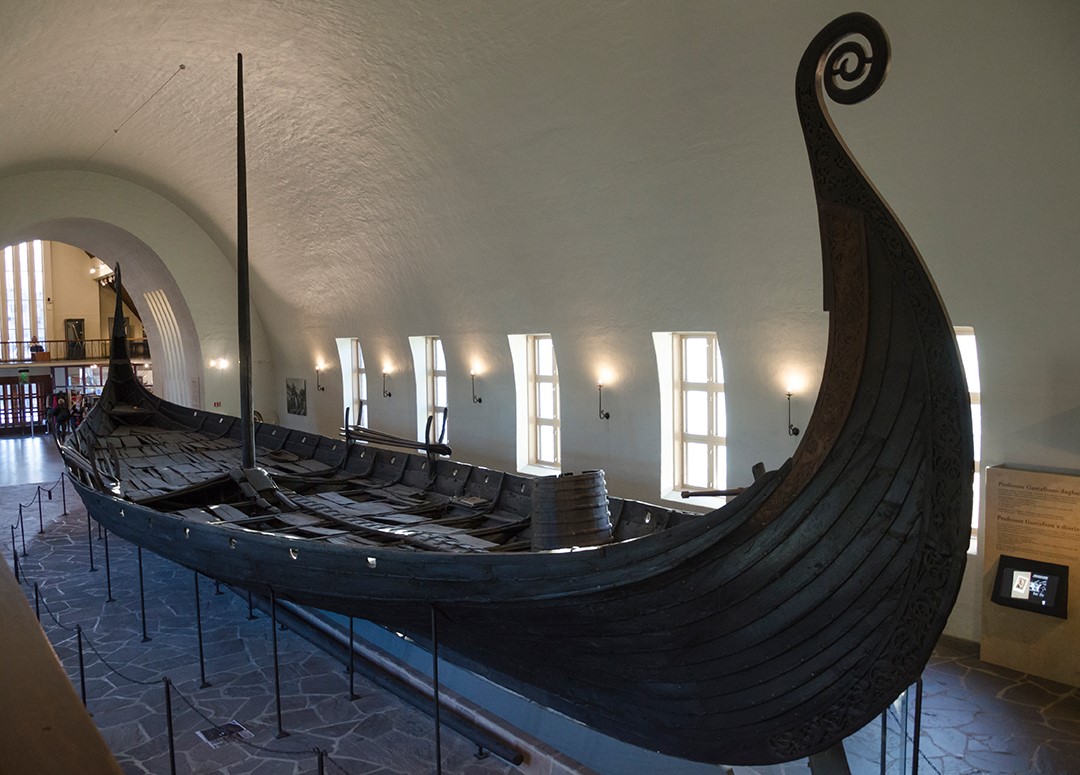
The ship is a Karve, clinker built, almost entirely of oak. It is 21.58 metres (70.8 ft) in length and 5.10 metres (16.7 ft) broad, with a mast of approximately 9–10 metres (30–33 ft) in height. With a likely sail area of 90 square metres (970 sq. ft).
The Oseberg ship (Norwegian: Osebergskipet) is a well-preserved Viking ship discovered in a large burial mound at the Oseberg farm near Tønsberg in Vestfold og Telemark county, Norway. This ship is commonly acknowledged to be among the finer artifacts to have survived from the Viking Era. The ship and some of its contents are displayed at the Viking Ship Museum at Bygdøy on the western side of Oslo, Norway.[1]
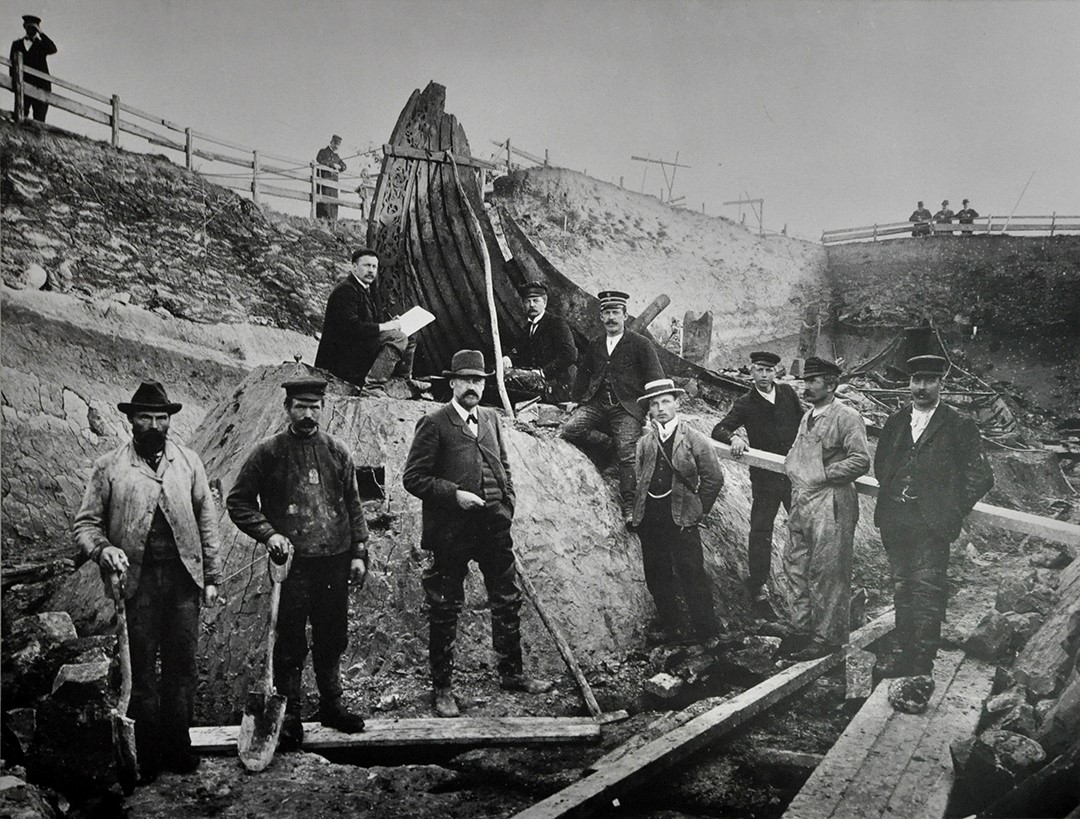
Excavation of the ship from the Oseberg burial mound (Norwegian: Oseberghaugen ved Slagen from the Old Norse word haugr meaning kurgan mound or barrow) was undertaken by Swedish archaeologist Gabriel Gustafson and Norwegian archaeologist Haakon Shetelig in 1904–1905. The grave also contained two female human skeletons as well as a considerable number of grave goods. Scientific dating of the ship suggests it was buried no earlier than 834, although certain parts of its structure date from as early as 800, while other parts may be even older. See: https://en.wikipedia.org/wiki/Oseberg_Ship
Position 3 of the Birka BJ 834 Seidr rod (3.54375”) is an ages-old measurement code that is taken from the base dimensions of the Khafre Pyramid of Egypt (a pyramid of the Moon). That pyramid is 15/16ths of the base measurement of the Great Pyramid (756’) so, 756’ ÷ 16 = 47.25’ X 15 = 708.75’.
But the Khafre Pyramid is also made to code the 3,4,5 triangle and half the base length is 354.375’ (the 3 aspect); its vertical design height was intended to be 472.5’ (the 4 aspect) and its hypotenuse sloping face 590.625’ (the 5 aspect). All of these numbers relate to the lunar year and also as divisions within the 6804-day lunar nutation cycle.
The sum of 354.375-days is the length of the lunar year.
With the Oseberg burial ship having an “official” or “rounded” length of 21.58 metres, that equates to 70.800522884’. However, it’s clear that the builders of the ship wished to encode 70.875’ (70 & 7/8ths) or 1/45th of a metre longer or a little over 2 centimetres (less than 3/4ths of an inch). By so doing, they were encoding 2 X 35.4375’ (35 & 7/16ths) and thus preserving knowledge of the duration of the lunar year (354.375-days or 12-months of 29.53125-days (29 & 17/32nds).
This is further corroborated by the official length given for the Seidr staff in the collection of the British Museum.
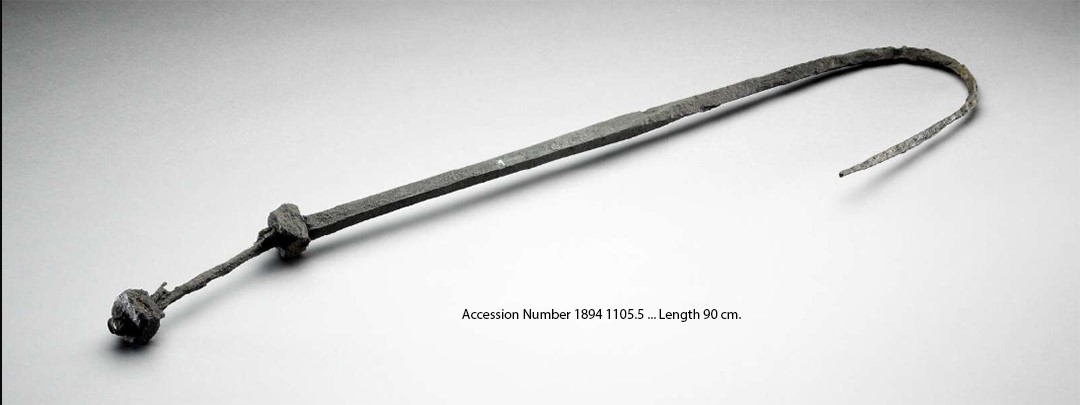
A long iron rod in the British Museum’s Viking collection (accession number 1894,1105.5).
This Seidr staff appears to be at its original design length, although it was deliberately bent before being placed in the grave of its Volva owner. This custom of bending swords or breaking off corner edges of coded-length, memory-device, stone pendants (sometimes erroneously referred to as “wrist-guards” for bowmen) was very common, as individuals were given their send-off into the journey of the afterlife with their prized possessions.
At 90 centimetres, the British Museum Seidr staff equates to 2.95275582’or 35.43306984”. Obviously, the staff was fabricated to represent exactly 35.4375” or 2.953125’, thus coding the 354.375-day lunar year and the 29.53125-day lunar month (accurate to within 1-minute of the lunar month duration). The degree of error in this measurement of 90 centimetres, against the real number intended, is about 1/226th of a centimetre.
Note: The Druidic Calendar of Coligny, bronze parapegma plaque was 29.53125” high.
Apart from the length of the Oseberg burial ship being coded, so also its beam width would carry a code, pertinent to navigation.
The waxing and waning Moon was essential to working out what day it was, if buffeting storms and cloud cover, for days on end, assailed a ship at sea. The Moon’s nocturnal position also represented a major navigational aid on the vast, featureless ocean.
As for the beam measurement of the Oseberg ship, set at 5.10 metres (16.73228298’), that should read 16.8’ or 1/15th of a foot (4/5ths of an inch) longer. The beam width @ 16.8’ would represent 1/6th of 1-second of arc (100.8’) in the equatorial circumference of the Earth.
Note: The ancient Swedish heavy Tunna dry volume was 10080 cubic inches.
| Swedish dry volumes (Heavy) | Swedish wet volumes (Heavy) |
Large Tunna = 10080 cubic inches. |
Fat (Barrel) = 9600 cubic inches. |
Large Fjärding = 1260 cubic inches. |
Tunna = 7680 cubic inches. |
Large Kappe = 315 cubic inches. |
Ankare = 2400 cubic inches.* |
Large Kanna = 180 cubic inches. |
Fjärding = 1920 cubic inches. |
Large Skäppa (Bohuslän) = 2520 cubic inches. |
Kannor = 160 cubic inches. |
Large Skäppa (Västergötland) = 2016 cubic inches. |
|
Large Skäppa (Småland) = 168 cubic inches. |
|
Note: The beam width (16.8’) of the Oseberg burial ship would equate to twelve “Hebrew Cubits of a Man” (16.8” each) and the Large Skäppa (Småland) = 168 cubic inches.

The overall length of the Volva-Seidr wand, found at Gnezdovo, Russia is 16.8-inches or 1 Hebrew Cubit of a Man.
THE HOLLOW SEIDR-WAND FOUND IN THE OSEBERG SHIP BURIAL.

The Osberg hollow staff is officially 106.5 cm in length, which translates to 42-inches with a shortfall of 1/15th of an inch.
The circumnavigating calibration marks at intervals down the staff relate, for the most part, to navigation under two well-known ancient systems ... one based on a combination of the numbers 6 X 7 (thus 42" for the overall length of the staff) and the other system based upon the number 11. The 6 X 7 system led on to the mile of 5250' (Greek) and the 11 system to the mile of 5280' (English) or 5940' (Scottish).
(1). An incised calibration mark a short distance in from the hilt end indicates .625" to the centre of the bas-relief recess. A mathematical progression based upon .625" (5/8ths) goes:
.625, 1.25, 1.875, 2.5, 3.125, 3.75, 4.375, 5, 5.625, 6.25, 6.875, 7.5, 8.125, 8.75, 9.375, 10, 10.625, 11.25 ... 13.125 ... 16.875 ... 20.625 ... 22.5 ... 45 ... 90 ... 180 ... 270 ... 360 ... 35000 ...131250000.
The progression provides very useful numbers for navigation and divisions of the Earth, like 68.75 miles of 5280' for 1-degree of arc under the Great Pyramid's second, 11-based system for encoding the equatorial circumference of the Earth (@ 24750-miles). '
The Swedish Mil was 35000’of 12-inches and 42” is 3.5’. The sum of 35000’ is 18000 Swedish Rydaholmsalm of 1.944444' each, which is also 36000 Roman feet.
Also, under the Roman navigation system, their value for the Earth's equatorial circumference was 131250000 feet or 125000000 Greek feet or 135000000 Roman feet or 67500000 Swedish Rydaholmsalm or 27000 Roman miles or 3750 Swedish Mil or 25000 Greek miles.
(2). The 10.08" mark is for mnemonic recall of 100.8', which is 1-second of equatorial arc under the Great Pyramid's literal navigational system.
(3). The value 17.1875 relates to navigation using the 2nd Egyptian Royal Cubit of 20.625" and the mile of 5280'. A mathematical progression based on this goes:
17.1875, 34.375, 51.5625, 68.75 ... 206.25 ... 275 ... 550 ... 12375 ...24750.
An interesting side note is that "Noah's Ark" was described as 300 cubits in length. If those cubits were 20.625" each then the boat would have been 515.625-feet long.
(4). At this position (23.76") the surface of the shaft has been carved to form a point. The sum of 2376' X 2.5 = 5940' ... a Scottish mile (660' or 1-furlong larger than the 5280'mile).
(5). A length of 2640' would be half a mile of 5280'.
(6). The value 324 is very versatile and multi-functional in a progression. It would relate simultaneously to divisions within the equatorial circumference of the Earth, the Precession of the Equinoxes and the duration of the 6804-day lunar nutation cycle, Certain values occurring in the progression were used for positional plotting at sea (turning straight-line legs of travel into circles on the plotting table, using the value 51840' for angle division readings within 360-degrees) ... i.e. 16500' (an English league) X PI @ 1728/550ths (3.1418181818) = 51840'... or 144' per degree of arc.
(7). 37.125" is for mnemonic reference to divisions within the 5940' Scottish mile.
(8). 37.8". On a high-resolution image of the hollow staff there appears to be a distinctive mark at 37.8" and that would relate to the literal navigational system encoded into the base dimensions of the Great Pyramid (length: 756' or 378' X 2). A progression based on this would provide all the essential numbers for world navigation using the Greek mile of 5250'. Note: This "mile"existed for thousands of years before the Greek golden age and is clearly marked into Megalithic-Neolithic standing stone or mound complexes of remote antiquity.
(9). The value 39.6 is navigational coding, as well as a division of the 5940' Scottish mile (5940 ÷ 396 = 15).
(10). The incised calibration mark near the end tip of the hollow shaft is quite wide and appears to have accommodated yet another code beyond 39.6 ... this time 40" ... or 3 & 2/3rds feet.
(11). 42" or 3.5' (this is 1.8 Swedish Rydaholmsalm of 1.944444').
THE SEIDR-WAND FOUND IN THE KAUPANG, VESTFOLD, NORWAY BURIAL SHIP.

For the length of the ship, ref. Frans Arne Stylegar, The Kaupang Cemeteries Revisited, pg. 95. Illustration by Porthallur Prainson.
Beyond the famous Oseberg ship burial at Vestfold, Norway there were yet others, including the above one at Kaupang, Vestfold. Within the 9-metre long ship were the bodies of three people. A man and woman of obvious rank or importance lay fully recumbent and stretched out on their backs towards the front of the SW-NW aligned ship. At the stern was a woman sitting at the tiller, as if guiding the boat to its destination. Both women were lavishly adorned with or surrounded by high quality grave goods, but the woman at the stern also seems to have been the owner and bearer of a Volva-Seidr staff. It was found under a large stone at the bottom of the boat.
The boat itself, if achieving 9 metres of length, was built to encode 29.53125-feet (coding the lunar month) or 354.375-inches (coding the lunar year).

For refined analysis, a scale bar would need to accompany the above, moderate-resolution photo, which is scaled to the official length of 65.5 cm. At that length it is easy to detect that the iron rod in front of the handle section is 1-Egyptian Royal Cubit of 20.625". This was the cubit that related to navigation by the mile of 5280-feet. The one that related to navigation by the 5250-feet mile was 20.61818182" (an example of which is found in the Turin Museum).
The segment of the staff to the rear of the iron rod measures 5.15625" (5 & 5/32nds). The sum of 515.625-feet would be 300 Royal Cubits of 20.625".
The combined segments give an overall length of 25.78125-inches (25 & 25/32nds), which is half of 51.5625 ... very clever coding and an amazing memory-triggering tool for recalling, then teaching, the principles of navigation using the cubit of 20.625".
THE SUTTON HOO BURIAL SHIP & THE LUNAR YEAR.


The official length of the Sutton Hoo burial ship is 27-metres and its beam width is given as 4.4 metres.
The 27-metre length converts to 88.5826746’and the beam width converts to 14.43569512’.
The intended length of the ship in old measure was assuredly 88.59375’ or 1/91st of a foot longer. A mathematical progression based upon 88.59375 (88 & 19/32nds) goes:
88.59375, 177.1875, 265.78125, 354.375.
So, the Sutton Hoo ship was built on the measurement code indicating 3-lunar months of 29.53125-days each (29 & 17/32nds).
The beam width was assuredly intended to convey 14.4’, for a shortfall of 1/28th of a foot against the official value.
A mathematical progression for 14.4 goes:
14.4, 28.8, 43.2, 57.6, 72, 86.4, 100.8, 115.2, 129.6, 144, 158.4, 172.8, 187.2, 201.6, 216, 230.4, … 259.2 … 345.6 … 518.4, etc.
This progression provides a string that relates to the equatorial size of the Earth (seconds, minutes and degrees of arc), the Precession of the Equinoxes and numbers used in cubic inch volumes like the English Bushel (2160 cu”.), etc.
THOSE BUILDING A SUTTON HOO REPLICA SHIP ADMIT IT WAS BUILT ACCORDING TO IMPERIAL MEASUREMENTS
‘Measurements of the frame positions taken from the plans showed that the average frame spacing, ignoring irregular spacing at the ends of the boat, was very close to 3 feet (2.994 ft average). This 3-foot frame spacing may be coincidental, but a review of measurements used in Saxon times for land buildings indicated that it was likely that there were two measurement systems in use at the time. One was based on a ‘rod’, which was 15 German feet long with each German foot 13.2 inches long, so the German rod was 16.5 modern feet long. The other was based on Roman units where a ‘rod’ was 15 feet long with each foot 12 inches long, these feet and inches being the same size as modern imperial units. It therefore seems a reasonable assumption that the Roman/current imperial measurement system was used for the Sutton Hoo ship, particularly when further noting that the overall distance between the end-most frames is 75 feet or 5 ‘rods’. Also, that the average planking thickness is 1 inch based on measurements taken from plank scarf join rivets. And while it could be coincidental, it was noted that the average width of the hull planks in the mid sections is approximately 1ft.’
(See: Historic Ships, 7-8 December 2016, London, UK © 2016: The Royal Institution of Naval Architects. THE SUTTON HOO SAXON SHIP – DEVELOPMENT AND ANALYSIS OF A COMPUTER HULL MODEL PRIOR TO FULL SCALE RECONSTRUCTION, P Handley, Paul Handley Design, UK,
Station 3 continued.
4.2525
The scaled measurement from the hilt end of Seidr staff BJ 834 is 4.2525” ... a more friendly fraction is 42.525 (42 & 21/40ths). This could/would also be used for mnemonic recall of 4.2”, although it would fall short of the mark by 1/20th of an inch in the above measurement.
A mathematical progression based upon 4.2525” runs:
4.2525, 8.505, 12.7575, 17.01, 21.2625, 25.515, 29.7675, 34.02, 38.2725, 42.525, 46.7775, 51.03, 55.2825, 59.535, 63.7875, 68.04.
Again, these numbers were generally used as far more inflated values to indicate stages, intervals or milestones reached during the 6804-day long lunar nutation cycle. The sum of 1701-days would be 1/4th, 3402-days would be ½ , 5103-days 3/4th , and 6804-days the full duration.
In the line-up the value 2551.5-days was 7.2 lunar years and this was a milestone within the 7-solar year (2556.25-days) count of the ancient, lunisolar Sabbatical Calendar, tracking the progress of both the Sun & Moon (generally on a parapegma plaque like the Druidic bronze Calendar of Coligny).

Moving down the much-rusted staff, we come to a kink area at a distance of 5.184”. This measurement is from the right-hand point of the diamond feature on the bronze knob to a mid-section of the shaft. It occurs at the precise spot where there is a slight downwards kink in the shaft. Although the 5.184 number is one of the most important in the ancient parcel of special numbers, there is nothing now in evidence to indicate that the shaft was marked at that point, but it seems plausible that it might have been.

Station 4.
From the right-hand point of the diamond feature on the bronze knob (station 3) to the left-hand point of the diamond feature (station 4), the distance is 7.776”. Also measuring from the same point on station 3 a distance of 8.064” is achieved to the top point of the diamond at station 4 (and dissecting its circle beneath). Likewise, a distance of 8.4” is achieved, coinciding with the right-hand point of the station 4 diamond and the circle underlying the point.
Here’s a close-up view:

All of the numbers coloured green represent measurements extending from the hilt-end extremity of the staff.
7.776
A mathematical progression based upon 7.776” goes:
7.776, 15.552, 23.328, 31.104, 38.88, 46.656, 54.432, 62.208, 69.984, 77.76 …93.312 …116.64 … 3110.4 ... 777.6 ... 124.416 … 248.832 …
These values are for navigation and are divisions within the equatorial circumference of the Earth (24883.2-miles). The sum of 777. 6-miles would be 1/32nd of the equatorial circumference or 11.25° of arc.
In the line-up we have 93312 and the Sumerian/ Babylonian Talent weight was 933120 grains. Also, the value 11.664-inches was the Roman foot, although for overland marching the foot used was 11.66666” or simply 11 & 2/3rds. The 11.664 value was used in weights & volume measures & lunar cycle calculations. The simpler 11.66666” foot was ½ of a Swedish Rydaholmsalm.
In an older article (circa 2000), expert in Swedish Weights, Measures and Volumes, Hans Hogman stated:
'The first unit of length to all parts of Sweden was the Rydaholmsalm (the length of a prototype kept in the church of Rydaholm, Smaland, now lost. It is thought to have been 0.593 m.' See: Old Swedish Units of Measurement, by Hans Hogman, http://www.hhogman.se/old-units-of-measurement-sweden.htm
At exactly .593 m., the Rydaholmsalm would translate to 1.945 feet or 23.34-inches. We can safely call this a very slightly "drifted" estimate of an increment known elsewhere as the "Aln", which was ratio-related to both the Swedish Famn and the Roman Pace (5 Roman feet or 58.33333”). The degree of error at the estimated .593 m is so negligible that 1.944444 feet (23 & 1/3rd inches) proves to be the intended value of the ancient Swedish Rydaholmsalm (2 Roman overland feet). There would be 2.5 Rydaholmsalm in a Roman overland Pace.

This rod, which was exhumed from the grave of a Volva-Seidr practitioner at Fyrtak, Hobro, Denmark is categorised as a "roasting-spit" for cooking meat or other foods over a fire. According to the National Museum of Denmark, it had an original length of 99 centimetres, before the deliberate bending of the rod-end for placement into the grave. That "rounded" centimetre length would convert to 38.88888-inches to a tolerance of 1/12th of an inch (2.12 mm shortfall) for an overall length of 1 & 2/3rds Rydaholmsalm. If a high-resolution image & scale-bar can be sourced for precise measurements of the handle & rod segments, perhaps this "spit" can be reclassified as an authentic Volva-Seidr rod.
12.15” (12 & 3/20ths)
The second position of station 4 is 12.15” from the hilt-end of the staff and a circle feature within the left side of the diamond clearly marks this measurement.
12.15, 24.3, 36.45, 48.6, 60.75, 72.9, 85.05, 97.2, 109.35, 121.5 … 1701… 194.4 … 255.15 … 303.75 …3110.4 ... 340.2 … 583.2 … 680.4 … 777.6 … 1,166.4 … 1,360.8 … 1,555.2, etc.
Note: The bronze Calendar of Coligny parapegma plaque, made by the Druids of France, was 4.86 feet of 12-inches in width, or 58.32” – 58.3333” (Roman Pace).
There would be 21 periods of 121.5 -days in 7.2 lunar years (2551.5-days) & 56 periods in 6804-days (lunar nutation cycle).
This specialised, lunar Greek foot of 12.15 inches was used as a calculation increment for tracking the progress of the Moon during the 2551.5-day period (7.2 lunar years) of the lunisolar Sabbatical Calendar system. The lunisolar Sabbatical Calendar system was based upon 7-solar years (2556.75-days) beside 7.2 lunar years (2551.5-days) and the difference between the Sun and Moon periods, within the calendar count, was 5.25-days.
A mistletoe culling ceremony on the sixth day (5.25) after the full Moon/ Summer solstice conjunction put the 2-periods in synchronisation for the next 7-years. The 12.15-inch Greek foot was also for following the progress of the Moon during this 18.613-year (considered to be 6804-days for calculation purposes) lunar nutation cycle.
There would be 56 periods of 121.5-days in the 6804-day cycle, which would go a long way toward explaining why there were 56 posts on the Aubrey Circle at Stonehenge (lunar counts).
Lenzen states that there is general acceptance that the Roman measurements were 24/25ths of the Greek measures. This appears to be sustainable in consideration of the Roman lunar foot at 11.664 inches and a Greek foot at 12.15 inches. (See: Ancient Metrology, by Donald Lee Lenzen, published in 1989 … highly recommended for those engaged in comparative analysis of ancient standards).

Staff 3456-Kvale, Sogndal, Norway is officially 79 cm. This translates to 2.592' or 31.104" in overall length. The "foot" value is coding the 25920-year duration of the Precession of the Equinoxes and the "ïnch" value is coding 1/8th division of the Earth's equatorial circumference under its 24883.2-mile assignment (3110.4-miles or 45-degrees of equatorial arc ... occurring in both the 7776 & 1215 progressions readings above).
8.064” (8 & 8/135ths)
The distance from the right-hand point of the station 3 diamond to the indented circle below the centre top of the diamond point on station 4 is 8.064”.
This sets up a mathematical progression that goes”
8.064, 16.128, 24.192, 32.256, 40.32, 48.384 … 120.96 … 201.6 … 362.88 … 604.8 … 130636800.
The increment of 12.096” (12 & 12/125th) was the Greek Samos foot and was used for producing incremental values related to the equatorial circumference of the Earth (130,636,800-feet of 12-inches or 129, 600,000 Greek Samos feet or 124,416,000 Greek feet of 12.6”).
The value 6048’ (of 12-inches) was 1-minute of equatorial arc (6000 Samos feet) and 362880’ was 1-degree of arc (360,000 Samos feet).
12.360672
This is (6.180339 X 2 … which can be rounded to 6.18034 X 2) … 12.360672”.
This measurement is from the hilt-end to the indented circle at the bottom point of the triangle at station 4.
This value is based upon a PHI reciprocal (10” ÷ 1.618034) and was central to creating a very accurate Tunna volume of exactly 10080 cubic inches dry measure in a circular marketplace tub.
BUILDING A "TUNNA" ROUND BARREL OF PERFECT INTERNAL CAPACITY.
Up until the middle of the 19th century, one could face the death penalty in Sweden for falsifying weights and measures or conspiring to deliberately defraud the buying public. This meant that merchants in the market place had to have perfect capacity vessels, such that anyone purchasing a "Tunna" of grain received exactly what they had paid for.
Market place inspectors periodically checked the accuracy of the merchant's volume tubs. So, how did the ancient Swedes produce round barrels or tubs that they knew, with certainty, were of perfect, internal cubic inch capacity?
The answer to that question lies in the fact that the ancient people of Scandinavia had yet another measurement rule of just over 1.030 British Standard feet, and it’s recognisable as being related to the PHI-reciprocal value, allowing it to be used for creating all of the various volume vessels or tubs used in the market-places of the cousin civilisations.
Gary Anderson, who has researched Viking measurements for several decades, concluded in a circa 2005 article, that there was a very old "Fot" (foot) that would equate very closely to .314 metres. This would translate to 1.03018 feet of 12-inches. He stated:’
'Fot*: In doing the research for this I found that there were actually two measurements for the Fot. One was very early and ran at exactly 11 inches, the other was almost 1.03 feet.' See: https://www.vikingage.com/HTML/measuringsystems.html
The manner in which the ancient scientists configured highly specialised rules for constructing round volume vessels, was to base them on the PHI ratio of 1.6180339 to 1. The same ratio exists between the area covered by the base of the Great Pyramid in comparison to the area of its 4 side faces, including a symbolic capstone on top.
If one uses simple trigonometry to work out the side length of the full pyramid, including the theoretical, non-existent capstone, the length to the centre apex would be (Adj. ÷ 51.84 Cos.) = 611.7894615 feet.
Alternatively, if one used a PHI method of Adj. (378 feet) X PHI (1.6180339) = 611.6168142 feet.
It will be observed that the calculated PHI length is only about 2 inches less than the length achieved by straight trigonometry. The ancient astronomer/ mathematicians were coding a PHI related angle for the Great Pyramid simultaneously to the standard angle of 51.84-degrees. The whole edifice was designed to clearly code PHI relationships. For example:
Let's consider the Great Pyramid on the basis of PHI and the ratio relationship (in pyramid acres) between the 4 faces, compared to the ground area that the Great Pyramid covers.
The surface area of each face of the theoretical full pyramid, complete with a (symbolic) pointed capstone, = 611.6168142 feet of side length X 378 feet (1/2 the base length) = 231191.11558 square feet.
Because there are 4 faces, their combined square footage amounts to 924764.6231 square feet. This translates to 32.10988275 Egyptian pyramid acres (identified by Herodotus) of 28800 square feet each.
The base area measured 756 feet X 756 feet or 571536 square feet, which equated to 19.845 pyramid acres of 28800 sq. ft each. A perfect PHI relationship exists between this (symbolic capstone included) total side acreage and that of the base area that the Great Pyramid covers: 32.10988275 ÷ 19.845 = 1.6180339 (PHI).
Because the Great Pyramid was an eternal "Bureau of Standards" for scattered, cousin nations and civilisations, it was absolutely essential that it strongly encode the PHI ratio, as this was central to fabricating very accurate, circular "volume vessels" or market-place tubs with ease.
Evidence shows that all standard, ancient volume vessels for the cousin civilisations were made by this simple method of increases of 6.1804” (based upon the PHI reciprocal of 10” ÷ 1.618034. The use of the PHI formula persisted for “squaring the circle” through the epoch of the Druids and beyond.
All volume vessels had to contain profound codes in (1) the square inch area of the base, (2) internal side height and (3) cubic inch volume, all of which related to astronomical cycles or world navigation, etc.
To make perfect capacity, round volume vessels for the Swedish “Tunna” capacity of 10080 cubic inches the formula was:
10-inches ÷ 1.6180339 (PHI) = 6.18034-inches (multiples of this increment became the standard length for making all of the circular market place volume tubs, of widely varying capacity, for all of the cousin European nations).
Here's a memory-device that helped ensure a perfect capacity for an ancient British volume (the bushel):

The Bush Barrow Lozenge, found in a Tumulus grave very close to Stonehenge, which is thought to date to circa 1900 BC.

The width of the Bush Barrow Lozenge of Southern England was intended to be 6.18034-inches (the lozenge has suffered some minor edge damage, slightly obscuring the original codes) and two such widths equated very visually close to 12.36068-inches or 1.0300566 feet, convincingly the same as a Swedish & Norwegian long "Fot".
The Bush Barrow Lozenge is 6.18034” X 7.29” (lunar code).
A primary purpose of the Bush Barrow Lozenge appears to have been for "market-place" inspectors to check the base width of "Bushel" barrels and tubs used by ancient merchants of the Neolithic Age, extending to Mediaeval times.
Very slightly "drifted" dimensions, for building a Bushel tub, are described in the old English Winchester Standard as: "Any round measure with a plain and even bottom, being 18.5 inches wide throughout and 8 inches deep". In fact, that should be 3 X 6.18034” or 18.54102” (a shortfall of 1/25th of an inch).
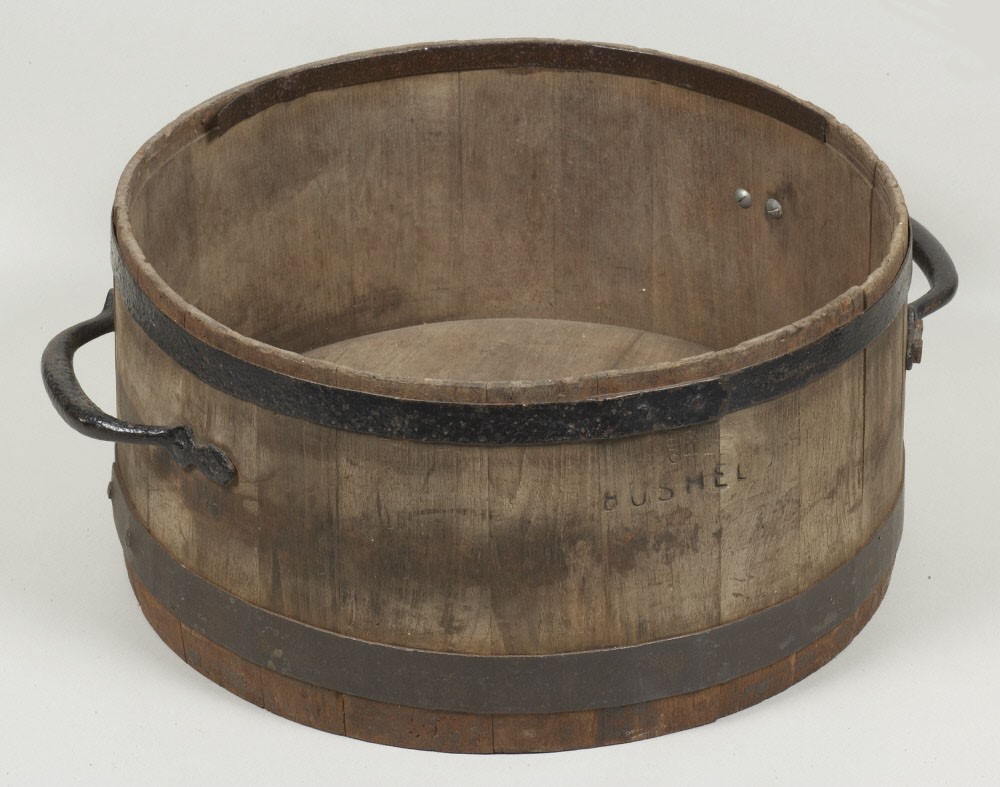
The base floor of the British Bushel was 270 square inches, with walls rising above the base floor a total of 8-inches, for a cubic capacity of 2160 cubic inches.
Note: The Sun spends 2160-years in each house of the Zodiac before moving into a new house during the 25920-year cycle of the Precession of the Equinoxes. At the Vernal Equinox, we are presently in the House of Pisces but will move into the House of Aquarius next.
The increment of 6.18034 X 2 = 12.36068-inches. This value equates to 1.03005666 feet and is assuredly the measurement identified by researcher Gary Anderson as the largest "Fot" utilised by the Vikings.

To make the Tunna tub base, take a large thin slab of flat smooth timber or tightly edge-splice several planks together to form a single piece of sufficient size.
Next take the 1.0300566 foot rule and mark double that length (2.0601132 feet) onto the wooden base as the total diameter.
Now create a circle from the halfway point of 2.0601132 feet diameter.
Because you have used a rule derived directly from the PHI formula, your base is exactly 480 square inches of surface area.
Your formula for determining the square inch area is PI X the radius squared, memorised by every schoolchild in the formative years of their education. So, the diameter of 2.0601132 feet ÷ 2 = 1.0300566 feet = 12.3606792-inches. This value "squared" = 152.7863903 X PI (3.14159) = 480 square inches of base.
The 480 number is a much-used coded value of antiquity and all aspects of ancient tub had to contain recognisable codes in the base surface area, internal side height and cubic capacity to be contained.
Because the tub needs to achieve 10080 cubic inches for this Swedish Tunna vessel, the internal height of the tub, from the top surface of the base to the brim of the side wall is 21-inches. This value (21-inches...sometimes called a Celtic Royal Cubit) is found in the base length of the Great Pyramid, which is 432 X 21-inches in length per side or 1728 X 21-inches for all four sides.
Note: A cubic foot (12 x 12 x 12) is 1728 cubic inches.
Note 2: A length of 100.8’ is one second of arc in the 24883.2 Greek mile (5250’) equatorial circumference of the Earth.

Having built your marketplace Tunna tub properly, you cannot be accused of swindling the public with short measures, thus ending up in the stocks and being bombarded with rotten vegetables by very irate, cheated consumers … or worse! ... (Motto: Don’t irritate a Viking who carries a big battle axe).
Note: It’s evident from Volva-Seidr grave-goods artefacts that a part of Volva-Seidr function focused upon Weights, Measures & Volumes, as well as possible assaying (measuring quantities of precious metals or herbal-medicines, spices, etc.). One researcher writes:
‘In Scandinavia there are female burials with scales and weights. Such weights were used to measure precious metals and spices. The women in these burials could very well have been traders in their own right’. See: https://avaldsnes.info/en/viking/vikingkvinner/
Which poses the question: Were these wise women (carrying calibrated measuring rods, scales and weights), acting in the capacity of marketplace inspectors, weighing batches of precious metal coins to ensure correct grain-weight content for payment? Were they measuring tubs to ascertain whether or not vendors were supplying the buying public with the correct cubic inch volumes? This seems likely.
12.4416”
Again, this measurement is from the hilt-end, resolving on the circle indent on the right-hand side of the Station 4 diamond configuration.
It is coding one half of the 24883.2-mile equatorial circumference of the Earth … 12441.6-miles X 2.
12.6”
This measurement, from the hilt-end to an indented circle sitting just above the right-hand point of the diamond, became the Greek foot.
It is the basis of a whole navigational system using:
12.6”, 2.52” (the Assyrian cubit), 10.5’ … The Hebrew Reed (126”), 525’ (the Greek short stadia), 630’ (the Greek long stadia), 5250’ (the Greek mile).
The Oseberg burial ship’s length would equal 67.5 Greek feet and its beam 16 Greek feet.
The Sutton Hoo burial ship’s length would equal 84.375 Greek feet (84 & 3/8ths) and its beam 13 & 5/7ths) Greek feet.
8.4”
This measurement is from the right-hand tip of the station 3 diamond to the circle indent exterior and below the right-hand tip of the station 4 diamond.
It is simply 2 X 4.2”, which was a base increment of the Greek navigational system ... 42 or (6 X 7).
A mathematical progression based upon 8.4 goes:
8.4, 16.8, 25.2, 33.6, 42, 50.4, 58.8, 67.2, 75.6, 84, 92.4, 100.8 … 126 … 201.6 … 302.4 …604.8 … 630 … 672 … 680.4 … 1050 … 1209.6 … etc.
This progression is largely navigational, homing in on a second, minute & degree of equatorial arc, but also related to the 6804 lunar nutation cycle duration (81 X 84-days).
Note: The ancient Irish mile was 6720-feet.
Note 2: The straight, hollow shaft found in a chest amongst the Oseberg burial ship grave goods, and attributed to possible Volva-Seidr practices, has a measured length of 106.5 centimetres, which converts to 42” to a tolerance of 1/15th of an inch. It might be significant that the Swedish Mil was 35000’of 12-inches and 42” is 3.5’. The sum of 35000’ is 18000 Swedish Rydaholmsalm of 1.944444' each, which is also 36000 Roman feet.
Also, the hollow tube is described as having ‘six 1 cm. wide indentations that encircle the staff at irregular intervals along its length.’ This statement, if accurate, implies an ancient calibration segment undoubtedly measuring .39375”, which was a lesser division leading up to the 196.875 grain count of the Beqa weight adopted by the Egyptians, Greeks and Romans. It was a fraction of both the Roman Silver Uncia @ 437.5 grains and the English Ounce @ 437.5 grains used in European grain-weights systems. There would be 90 -intervals of 3.9375-days (94.5-hours) in the 354.375-day lunar year.
STATION 5

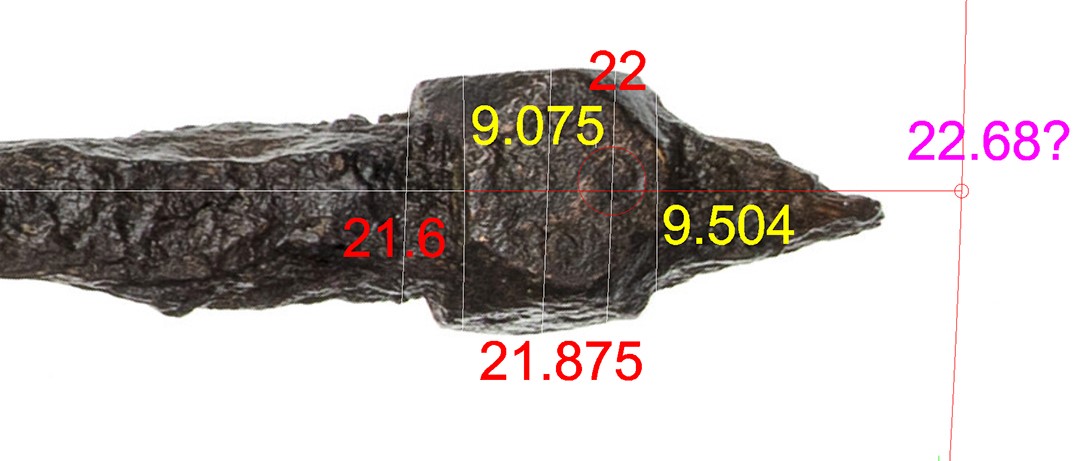
Station 5.
The final bronze knob station. One of its face-circles is clearly visible and others possibly so, but badly corroded.
21.6”
This measured distance is, of course, from the hilt-end and resolves to the left-hand edge of the bronze block. A mathematical progression based upon this value goes:
21.6, 43.2, 64.8, 86.4, 108, 129.6, 151.2, 172.8, 194.4, 216 … 259.2 … 3024 … 345.6 … 453.6 … 518.4 … 583.2 … 691.2 … 756 … 777.6 … 907.2 … 1036.8 … 12096 … 1382.4 … 1555.2 … 1620 … 1900.8 … 2073.6 … 2160 … 25920.
The Precession of the Equinoxes (a slight wobble of the Earth’s axis) takes 25920-years to complete. This throws the day of the equinox off by one day each 72-years and the calendar date has to be changed accordingly to stay abreast of the actual date for the equinoxes and solstices.
In the long-enduring cycle of Precession the Sun spends 2160-years in each House of the Zodiac, before moving into a new house.
In the above line-up is 5184. One 5th part of the cycle of precession is 5184-years. Also, 51.84° is the slope angle of the Great Pyramid, which covers a base area of 5184 square reeds of 10.5’each (72 reeds X 72 reeds). If one sails a leg of 16500’(one English league) and then turns that diameter (scaled down) into a circle on a plotting chart using PI @ 1728/550th (3.141818182) then the circumference achieved is 51840’ (divisible by 360° … 144’per degree of arc).
The value 1036.8 identifies the speed at which the Earth spins in miles per hour. Therefore: 24883.2-miles ÷ 24 (hours) = 1036.8 MPH.
Note: The "Stirling Jug" of Scotland, dating to 1457 AD and possibly much earlier, had a capacity of 103.68 cubic inches, which was the same as the ancient Hebrew liquid volume called the Jerusalem Cab (predating the Babylonian conquest).
Note: The Kilmainham staff, located in Dublin, Ireland, is quite possibly still at its original length, given as 38.5 cm. This converts to 1.263123323' (15.15748") or a mere 1/27th of an inch in excess of 15.12".
This is a dynamic progression, power-packed with many scientific numbers.
21.875
This progression was widely used by ancient assayers from Egypt, Greece, Rome and Britain, as elsewhere across Continental Europe, primarily in the grain counts of their gold and silver coinage, but extending into weights standards in general. It is both lunar cycle coding, as well as navigational coding used by the Romans in their overland Pace, Mile and finalised value for the equatorial circumference of the Earth. The ancient Swedish Mil of 6000 Famm (5.833333’ or 70-inches) = 35000 feet of 12-inches (18000 Aln or Rydaholmsalm of 1.944444’). There were 36000 Roman feet of 11.666666” in a Swedish Mil.
It goes:
21.875, 43.75, 65.625, 87.5, 109.375 …175 … 196.875* … 262.5 … 328.125*… 350 … 393.75* … 437.5* … 525 … 590.625 … 700 … 787.5 … 1050 … 1181.25 … 1312.5 …1771.875 … 2953.125 … 3543.75 …131250000.
*Note: The star-marked numbers were very important to ancient assaying and a length of 39.375 (inches) is only 1/205th of an inch in excess to the modern metre @ 39.3701 (inches). More about the introduction of “metrickery” as we proceed.
In the above line-up is 196.875 (196 & 7/8ths). The ancient Egyptian “Beqa” for gold was a weight of 196.875 grains, and this was adopted by both the Greeks and the Romans, then persisted with other European nations into the AD era.
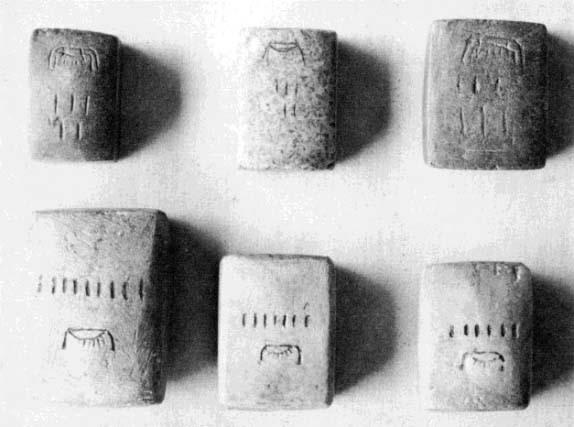
These Egyptian "Beqa" weights are all marked to indicate that they were used for weighing quantities of gold dust, as each bears the "gold" insignia. This, seemingly, complete set was found at Khartoum.

The Hemdrup wooden staff, found to be perfectly preserved in a Danish bog, has an official, published length of 50 centimetres. That equates to 19.6875 inches to a tolerance of 1/408th of an inch shortfall. It was clearly coding 19.6875” (19 & 11/16th). It also displays calibration marks through its length that can, undoubtedly, be deciphered as number codes, extracted by measurement.
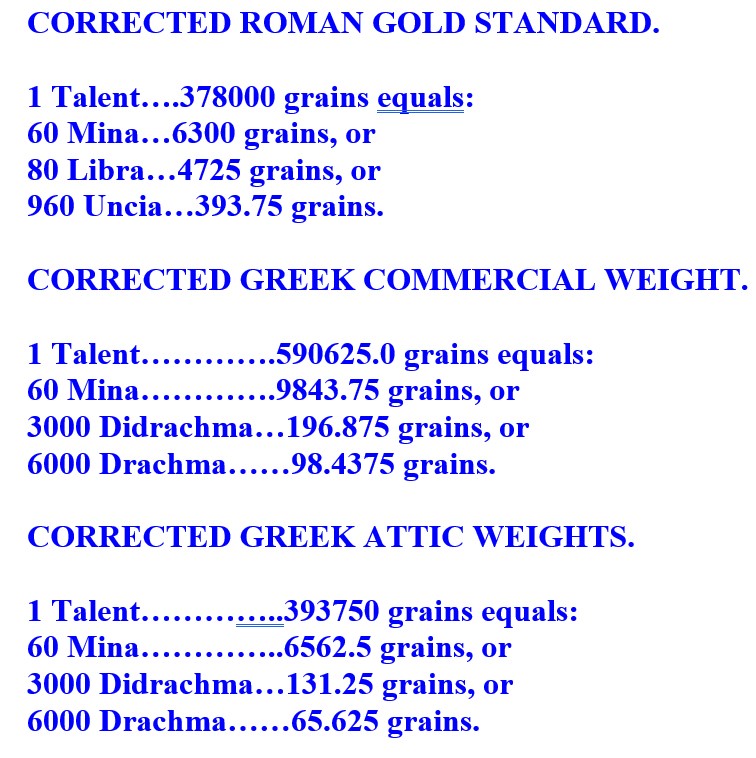 3
3
The Roman gold standard Uncia was 393.75 grains, which was 1/1000th of the Greek Attic Talent @ 393750 grains. The Greek commercial Didrachma @ 196.875 grains was the same as the Egyptian, Greek & Roman Beqa grain weight standard for gold. It can be clearly seen that many of the values in the 21.875 progression interrelate with the standards of other great civilisations.
Again, the value 196.875 is lunar coding and 19.6875-days (472.5-hours) = 1/18th of the lunar year of 354.375-days.
Note: The Khafre Pyramid of Egypt is built as 2 X 3,4,5 triangles connected on the vertical faces to form a pyramid. The base half is 354.375’ (3 X 118.125’), the vertical (base to apex) is 472.5’ (4 X 118.125’) and the diagonal face 590.625’ (5 X 118.125’).
The sum of 118.125-days would be 4 lunar months of 29.53125-days each (which is accurate to under 1-minute). The value 177.1875-days is half a lunar year.

And yet again, the 354.375-day duration of the lunar year appears to be coded into hilt-handle segment of the Klintastaven (staff) found at Borgholm kommun Öland , Sweden. Other segments of the staff measured under a very high-resolution, scaled photo were:
.875 (width of the hilt pommel ... navigation & lunar), 2.25 ... length of the hilt pommel & 360° readings, 3.54375 ... lunar-year readings, 5.5 ... merchant navy fathom readings, 6.6 ...chain & furlong readings, 2.916 ... Roman pace readings, 3.24 ... equatorial circumference of the Earth & Precession of the Equinoxes readings, 1.030056 ... PHI reciprocal and marketplace volume tub fabrication readings, 14.66666 ... speculative and only significant if the rod end is complete. The 14.66666 code is a division within the fathom, chain, rod, furlong, mile & league navigational system.
Another segment below the handle includes, what appears to be, a rim-ring & trough that might code 3.1104 ... equatorial circumference & 3.1416 ... PI. There are "duck-face" features that also represent resolving points for codes.
Note: All of the Volva-Seidr rods that are fully or partially complete must be precisely measured, by state-of-the-art equipment, at the museums where they repose to fully identify any surviving codes of position, station-to-station.
9.075
This measurement runs from the right-hand point of the diamond at station 5 to the vertical edge of the pentagonal geometry on the face of the bronze knob. There are two codes inferred here, 9072 & 9075.
Each of these represents a base increment for a navigational method, i.e., 9072 for the Greek method of navigation (using a mile of 5250-feet of 12-inches) & 9075 for the English method (using a mile of 5280’of 12-inches).
The Great Pyramid @ 756’is 9072” long. If it was elongated only 3-inches to 9075” a whole new, much used, navigational method would come into play.
22”
This measurement runs from the hilt-end to an identifiable circle feature indented into the brass knob face. The 22” mark dissects the centre of the circle. A mathematical progression based upon 22 goes:
22, 44, 66, 88, 110, 132, 154, 176, 198, 220, 242, 264, 286 …330 … 528 … 550 … 594 … 660 … 792 … 990 … 1056 … 1650 … 5280 … 16500 … etc.
Under the “11” system of navigation (increments divisible by 11) we have:
7.92” (link), 3’ (yard of 36”), 5.5’(original fathom or merchant fathom, surviving into the 20th century), 16.5’ (3 fathoms … also called a rod or perch), 66’ (chain), 660’ (furlong or furrowlong), 1760’ (1/3rd of a mile), 5280’(mile), 16500’ (league or 3 & 1/8th miles). An English acre was 1-chain X 1-furlong or 43560 sq.’.
Note: Long-term researcher into ancient Norwegian units of measurement, Gary Anderson, verified that there was an ancient “Fot” of exactly 11-inches.
In the above line-up, 1980-miles was the half-radius of the Earth, for a full diameter of 7920-miles of 5280’. Also, the Scottish mile was 5940’ (1 furlong greater than the English mile).
9.504”
Again, this measurement is from the right-hand point of the diamond on station 5’s bronze knob.
A mathematical progression based upon 9.504 goes:
9.504 19.008, 28.512, 38.016, 47.52 … 237.6 … 712.8 … 28512
This progression was used in the creation of the Egyptian Sepphoris Dry volume, with their Homer achieving 28512 cubic inches.
CORRECTED SEPPHORIS DRY VOLUME.
1 Homer….28512 cubic inches equals
10 Ephah….2851.20 cubic inches., or
30 Seah…..950.40 cubic inches, or
180 Cab….158.4 cubic inches, or
720 Log….39.6 cubic inches.
The Homer value @ 28512 acts as a memory trigger related to the equatorial circumference of the Earth under 3 main navigational systems encoded into the lengths and angles of the Great Pyramid of Egypt. The 28512 memory-trigger would have been extremely helpful in teaching the overall principles of navigation or incremental length values, as well as renditions of PI, that could be pressed into service in ocean traversals and positional plotting.
Let’s see how it could be manipulated:
The memory trigger of 28512 ÷ 9072 = 3.142857142857143 or more simply, 22/7ths as the form of PI used under this navigational system when doing positional plotting (dead reckoning) on the vast, featureless oceans.
There was a formula for creating an Egyptian Royal Cubit, related directly to this navigational method, which was 9072’ ÷ 440 = 20.61818182” (an ERC of this length is housed in the Turin Museum).
This length ERC was then multiplied by 1200 and the result read in miles of 5280’ = 24,741.81818182 X 5280 = 130636800’or 12 X 12 X 12 X12 X 1.2 Greek miles of 5250’or 24883.2 Greek miles for the full equatorial circumference.
The memory trigger 28512 ÷ 9075 = 3.141818181818182, or more simply 1728/550ths. Again, the formula 9075 ÷ 440 was used to create an ERC of 20.625” (20 & 5/8ths) for reading (in miles of 5280’) the equatorial circumference under this navigational method. Therefore: 20.625 X 1200 = 24750-miles or 130680000’.
An ERC of this size was identified by Petrie’s measurements within the King’s Chamber of the Great Pyramid.
A great deal more could be written here about the several navigational and positional plotting methods of the English-Scottish, Greek, Roman & Scandinavians, etc., based upon the commonly shared measurement increments that they used … but this will suffice for identifying some of the attributes of the 28512 progression.
Beyond Station 5 … the end tip of the rod.
22.68
There is a small amount of the end tip of the staff missing, due to over 1000-years of being buried in a grave with its Volva owner. A near, possible code would be 22.68”, but whether or not the staff’'s overall length was set to that code is unknown.
The sum of 2268’was the length of 3-sides of the Great Pyramid @ 756’per side and was both navigational and lunar nutation cycle coding. A length of 2688’would be 1/57600th of the 130636800’equatorial circumference or (3/8ths of 1-minute of arc) and 2268-days would be 1/3rd of the 6804-day lunar nutation cycle.
THE OTHER SIDES OF STAFF BJ-834 ALSO CARRY MEASUREMENT CODES
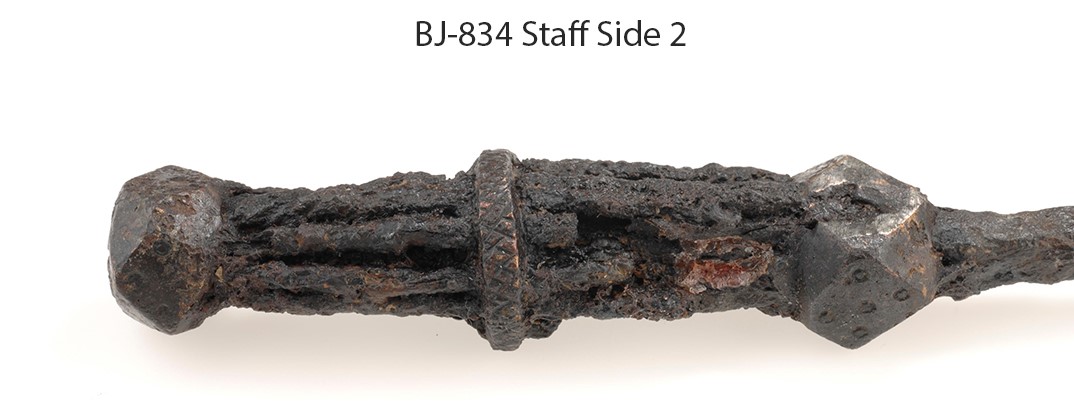
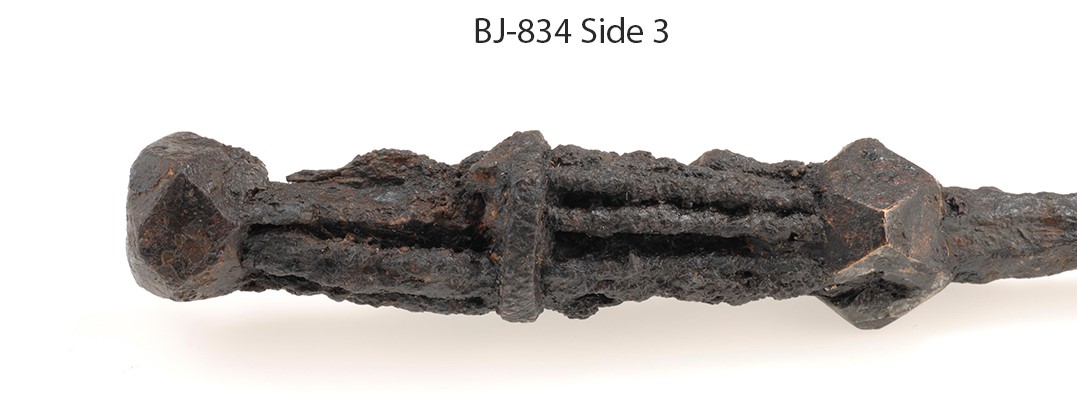
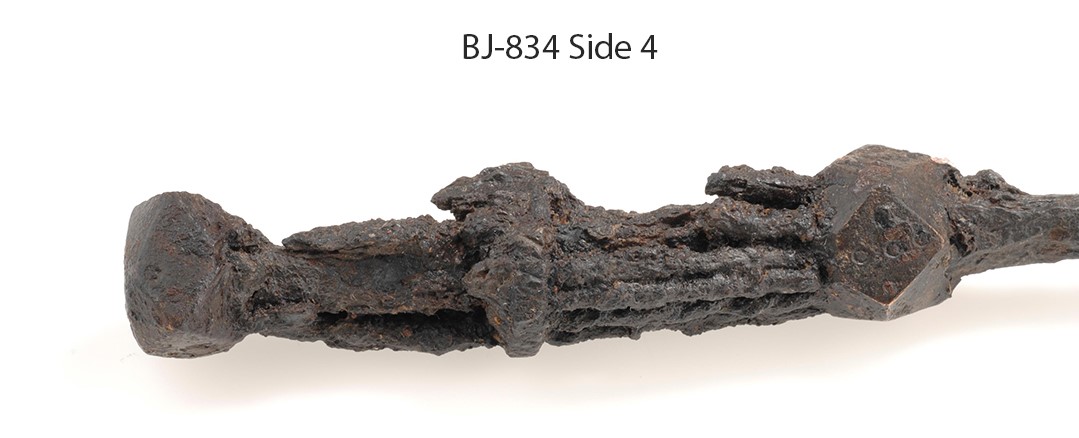
It can be readily seen that we have a long way to go in order to identify whatever measurement codes can still be extracted from these Volva-Seidr staffs. As far as the BJ-834 staff is concerned, we’ve looked at less than 1/4th of what is potentially still available to analyse.
It can be seen that the brass knobs of BJ-834 have pointed centres on some sides, suggesting measurements will exist centre-to-centre. Also, the additional lozenge-diamonds have dot-marks on their faces, providing yet more opportunities to extract significant codes of position, lozenge-to-lozenge or station-to-station.
These staffs/ rods/ wands were very sophisticated mnemonic devices and the evidence shows that those who carried them were fulfilling roles akin to the earlier Druids, who had, unfortunately for all, been murdered en-mass by the invading Romans, firstly in France and 100-years later in England.
Roman propaganda then demonised the Druids and their roles to the populations they served as wise teachers or advisors.
Centuries later, the Roman church, following-in on the heels of the earlier vanquished Roman armies, slowly began wielding increased influence over those they proselytised, eradicating the old ways, traditions and religious beliefs of the nations where they gained a foothold. They would not have tolerated any competition from the travelling, very influential and respected Volva-Seidr advisors & teachers. Thus, these wise-women-savants were, as the years wearied on, stripped of their former prestige, then slandered and demonised as witches dabbling in the dark arts.
The enlightened era of the wise-women was being eclipsed by the backwards, power-mongery of the church fathers, who were winning-over the hearts and minds of gullible people by convincing them that, as sinners, they needed the exclusive brand of salvation that only the church could provide.
By the 13th century the superstitious frenzy-nonsense fomented by the church in demonising all things pagan had given rise to horror stories of witch-hags flying off to Blåkulla to cavort with the devil and perform black sabbath rituals. For hundreds of years, Swedes hid their household brooms from the witches and lit bonfires to keep the ever-dangerous witch-hags at bay.
The Mediaeval dark-ages of superstition and grotesque-ignorance had arrived with a vengeance and the witch trials, accompanied by the cruel torture and murder of many innocent women, followed.
By a proper, in-depth study of the surviving measurements reposing within the Volva staffs (like sentinels guarding profound knowledge from a distant-age), we are poised to radically change our perspective of the Volva women, their true roles, as well as the contributions they made to the societies they served.
There remain many more rods, or sufficiently complete sections thereof, that can yet be analysed to identify inbuilt number codes of position, extractible by careful measurement.
SUPPLEMENTARY NOTES ABOUT THE INTRODUCTION OF THE METRIC SYSTEM (circa 1799 AD).
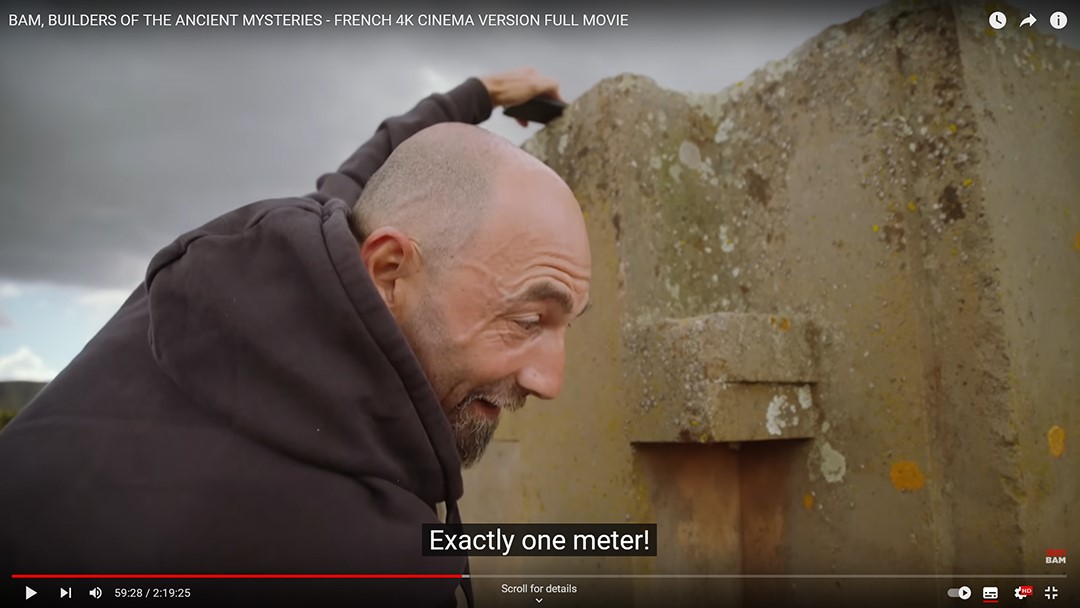
French archaeologists measuring ancient cut stone blocks at Puma Punku, Tiahuanaco, Western Bolivia, were obviously very delighted to find that the height of a block was 1-metre. Measurements over the same cut stone and others adjacent produced excellent sub-divisions of the metre, ranging from 22 cm., 21.9 cm., 30 cm. and 60 cm.
Similar observations that would seem to prove the existence of an ancient use of the metre rule were undertaken in Egypt as well, with convincing results.
Commentary associated with the documentary seemed to laud and applaud the June, 1792 French incentive to create a whole new measurement system. It was to be based upon an increment that was derived from 1/4th of the distance around the Earth ... from the North Pole to the equator, with the meridian line running through France. The metre length was supposed to be 1/10 millionth of the pole-to-equator distance, but the finalised measurement calculated by astronomer-surveyors, Jean Baptiste-Joseph Delambre and François-André Méchain fell short by .02mm.

Delambre & Méchain, who toiled for about 7-years to calculate 1/4th of the Earth’s polar circumference, through the meridian of France.
Delambre who became aware of serious mistakes made in Méchain’s calculations later wrote in a log book: ‘I deposit these notes here to justify my choice of which version of Méchain's data to publish. Because I have not told the public what it does not need to know, I have suppressed all those details which might diminish its confidence in such an important mission.’
Thereafter, the length of the metre was adjusted three times to what it is today.
But what did ancient civilisations already have by way of a measurement increment, based upon the universally-used “inch”, that closely duplicated or mirrored the length of the modern metre?
Under the Roman Gold and Silver “Uncia” weights system the mathematical progression goes:
3.9375 grains (.009 of a Roman Silver Uncia or Ounce), 196.875 grains (1 Beqa or .45 of a Roman Silver Uncia or Ounce), 437.5 grains (1 Roman Silver Uncia or modern English Ounce) … extending to 393750 grains (The Greek Attic Talent weight), etc.
A typical progression listed earlier goes:
21.875, 43.75, 65.625, 87.5, 109.375 …175 … 196.875* … 262.5 … 328.125*… 350* … 393.75* … 437.5* … 525 … 590.625 … 700 … 787.5 … 1050 … 1181.25 … 1312.5 …1771.875 … 2953.125 … 3543.75 …131250000*.
In such a line-up, in either reduced or increased number expressions, 3.28125 (read as feet) or 39.375 (read as inches) would very closely mirror the length of the modern metre (39.3701”) to a tolerance of 1/80th of a millimetre or about 1/205th of an inch.
We know that the Romans had an overland marching foot of 11.66666”and a pace of 58.333333” or 5 Roman feet. We also know that the Swedish had a Rydaholmsalm of 1.944444’or 23.333333” (2 Roman feet).
We know that the Swedes had a Mil of 6000 Famm (fathoms), 18000 Aln (ells) = 35000 feet of 12-inches. This distance would also be 36000 Roman feet.
One of the more ancient concepts that survived into Mediaeval times was that 75-Roman miles was 1-degree of arc in the equatorial circumference of the Earth. Their mile was 5000 Roman feet or 4861.11111 feet of 12-inches X 75 X 360 = 131250000 feet or 125000000 Greek feet or 135000000 Roman feet or 67500000 Swedish Rydaholmsalm or 27000 Roman miles or 3750 Swedish Mil or 25000 Greek miles.
In the 35000’ Swedish Mil there would be 10,666.6666 increments of 3.28125-feet. The French Pied du Roi was 1.066666’ or 12.8”.
In the 131250000’equatorial circumference reading, a length measure of 3.28125-feet (mirroring the modern metre) would be 1/40,000,000th division. A quarter of that Roman value was 1/10,000,000th of the distance, as sought-after by the French government in 1792 for their new metre rule.
As it turns out, the ancient 3.28125’ measurement is more accurate in describing the pole-to-equator division of the Earth than the modern metre @ 3.2808398’.
It seems a little strange that the French authorities proposed having a rule that represented 1/10 millionth of the distance from the North Pole to the equator, when such a measurement had existed from ancient times in the Roman metrology system. Did the authorities not know the length of a Roman foot? That seems very unlikely in Roman Catholic France.
The Roman foot was found to be 11.664 inches by John Greaves, professor of geometry, who in 1639 went to Rome specifically to ascertain the length of an ancient Roman foot. Greaves located a monument of Roman architect, Stalius Asper and measured bas-relief instruments used by him in the first century A. D. Greaves concluded, after careful investigation, that the Roman foot, 'contained 1944 such parts as the English foot contains 2000'. This means a Roman foot of 11.664 inches. See: https://en.wikipedia.org/wiki/John_Greaves
Well yes, it was certainly 11.664” in mathematical progressions tracking lunar cycles or volume capacities, etc., but the simpler value of 11.66666” (11 & 2/3rds) was used for overland distances, with a Pace of 58.333333” (5 Roman feet). The same foot, in doubled values, was used in Sweden for the Rydaholmsalm length (1.94444’).
Professor John Greaves undoubtedly had published his results related to the length of the Roman foot in the interim 150-years before the French authorities hatched their plan for a “Meton”. Surely the French authorities and masonic-guilds of 1792 knew that 5000 Roman feet was a Roman mile and that 75 such miles represented 1-degree of equatorial arc for the Earth. From this they could have easily calculated the Roman figure for the Earth’s circumference and the length of a rule that would be a quartered circumference or 1/10 millionth division under that navigational system.
So, as it turns out, French archaeologists measuring cut stone blocks at Puma Punku, Tiahuanaco, and finding measurements that very closely mirror the metre, to a tolerance beyond what the eye can visually detect, need not get too excited. Such an increment has been a part of the so-called imperial systems of measurement for thousands of years.
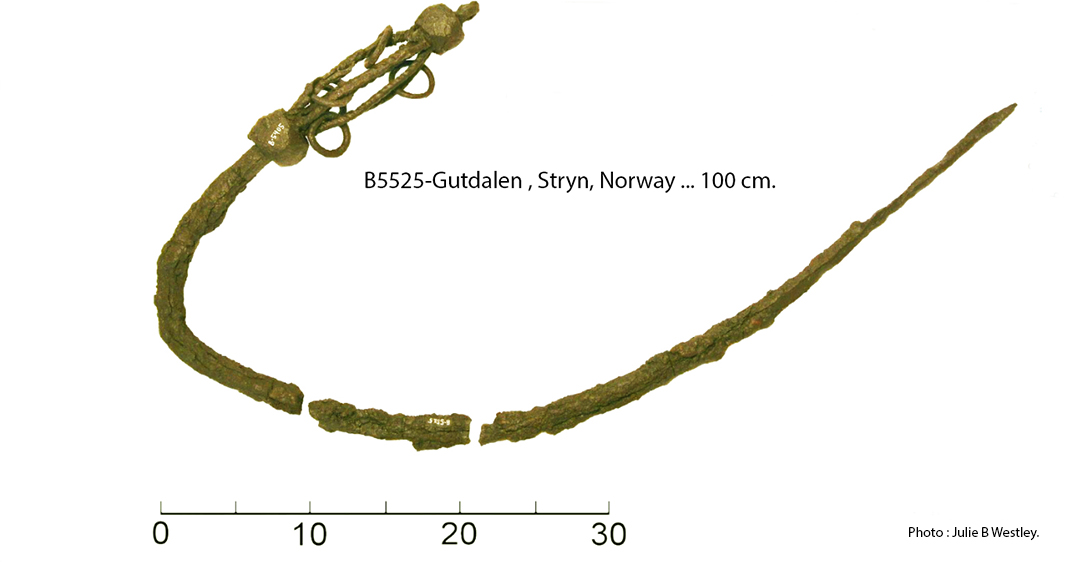
The Volva-Seidr staff / wand exhumed from a Norwegian grave in 1898 is, officially, measured to be 'approximately 100 cm long overall' ...
It's quite evident that this staff was fabricated to encode a measurement of 3.28125' or 39.375" and represents 1/40 millionth of the equatorial circumference of the Earth under the ancient Swedish-Greek-Roman equatorial circumference value of 67500000 Swedish Rydaholmsalm @ 1.944444' each.
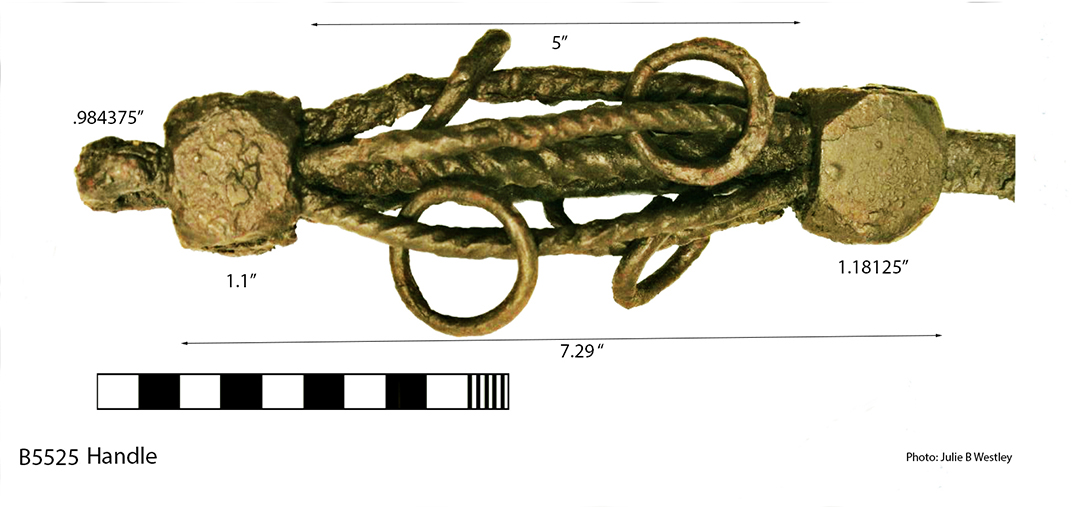
The handle area of B5525 Volva staff seems to comply to the above in-built measurements. Therefore in consideration of the overall length combined with each segment we have:
(1) Overall length = 39.375 " ... The Roman gold standard Uncia (ounce) was 393.75-grains and the Greek Attic Talent weight was 393750-grains.
(2) The iron shaft was intended to be 31.104" ... In the 12 X 12 X 12 X 12 X 1.2-mile equatorial circumference of the Earth, a 1/8th division would be 3110.4-miles.
(3) The overall length of the handle, including the forward and rear bronze knobs seems to comply to a scaled measurement of 7.29". This is 1/8th of a Roman lunar pace of 58.32-inches. It is also the length of the Bush Barrow lozenge artefact.
(4) The forward cubo-octahedral bronze block seems to comply to a measurement of 1.18125". The sum of 118.125-days would be 4-lunar months of 29.53125-days each.
(5) The rear cubo-octahedral bronze block seems to comply to 1.1", in homage to one of the ancient Scandinavian "foot" measurements of 11-inches found by Swedish researcher, Gary Anderson.
(6) The handle distance between the two bronze knobs is 5".
(7) The rear hilt pommel seems to comply to .984375". This is lunar coding and 1/36th of the lunar year would be 9.84375-days. Also, 98.4375-grains would be 1/2 of a gold-standard Beqa of 196.875-grains.
The lineup of segments is therefore: 31.104" + 7.29" + .984375" = 39.378375" or about 1/300th of an inch off our target of 39.375" (the ancient equivalent to the "metre"). I think we can forgive the fabricator of the staff for that visually undetectable overshoot!
See: "Den Sterke Kvinnen": Fra husfrue til volve, https://bora.uib.no/bora-xmlui/bitstream/handle/1956/21267/Den-Sterke-Kvinnen-Masteroppgave--Julie-Westlye.pdf?sequence=1&isAllowed=y
This researcher’s only gripe is that academic measurements of ancient artefacts or structures are hidden behind modern metric units and we must endure the unenviable task of converting everything back into old-measure in order to make any precise sense of what we’re looking at.
The irony in all this is that the "new" metre @ 39.3701-inches, introduced with the sole purpose of offering an improved standard, was so close to the ancient copious use of 39.375-inches or the 393.75 grain Uncia or the 393750 grain Greek Attic Talent, one wonders why they ever bothered. Seasoned researchers of old-measure increments very often detect a close proximity, ancient value when centimetres are converted to inches.
Why is it that an imperial ounce = 28.3495 metric grams ... and the Khafre Pyramid of Egypt has a base perimeter of 2835-feet?
AN IN-DEPTH ANALYSIS OF CODING FOUND ON VOLVA-SEIDR STAFF, BORKO 760

This is an artist's impression of the design features in the handle area of Volva staff BJ-760, while also fairly representing the decrepit state of the much-rusted shaft or somewhat corroded hilt-point.
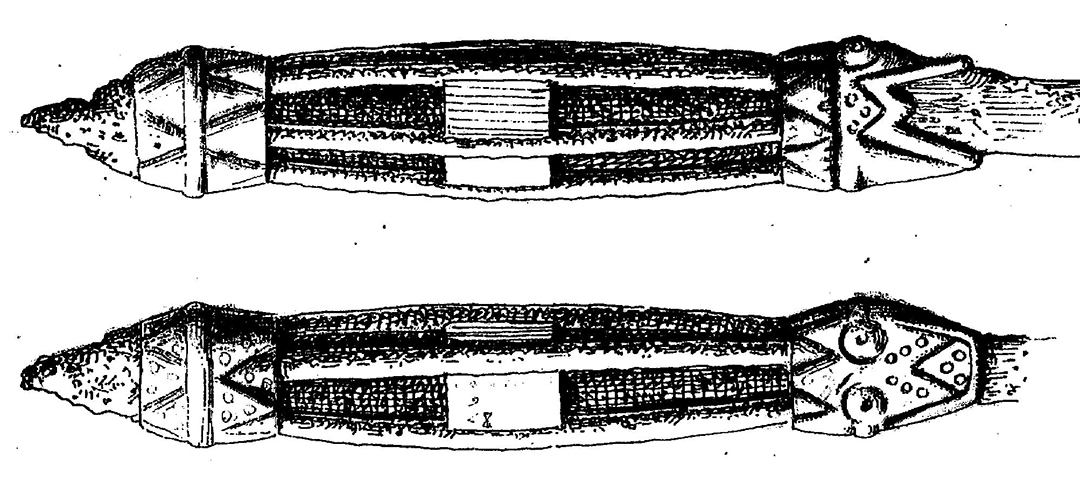
The Volva staff / wand is ornately fashioned, with bronze knobs inserted permanently in place over the central iron shaft. These bronze knobs are in-laid with chevron pattern incising, as well as multiple dot marks, many irregularly distributed. Two large, side-by-side eye features on duck's faces are found on opposite sides of the central bronze knob and these designate the precise fulcrum points from which coded-length measurements are made to the many irregularly distributed dot markers.
The officially measured length of the BJ-760 staff is 45.5 centimetres, although no scale bar appears on the very high resolution photo of the artefact derived from The Statens Historika Museum files. The photo was scaled in AutoCAD to comply to 45.5 centimetres of length from the hilt tip to the irregular end of what has survived of the iron shaft. The artefact, based upon that scaling, was then analysed for codes-of-position.
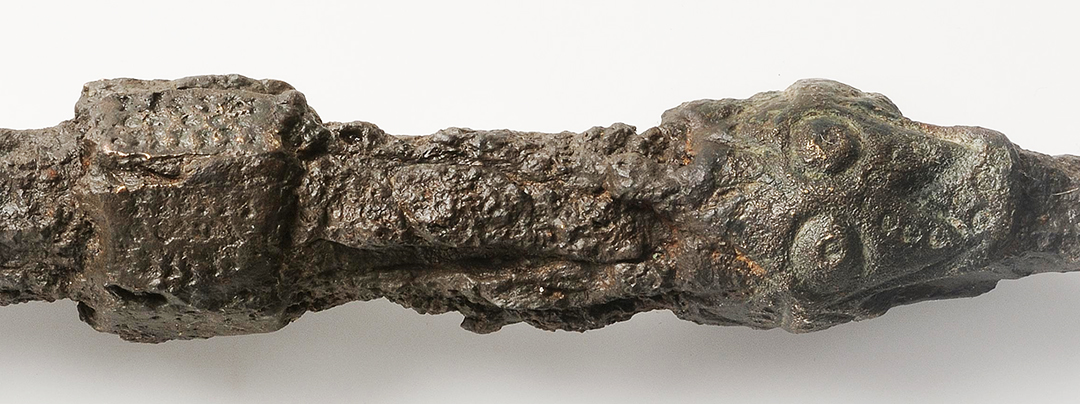
To the right can be seen the "duck's face" feature, cast in bronze. To the left can be seen the adjacent bronze knob that sits at the end of the staff handle. Note how the left-hand knob has very distinctive knop bumps in a perfect line along the top surface, with dot-mark indents between the knops.
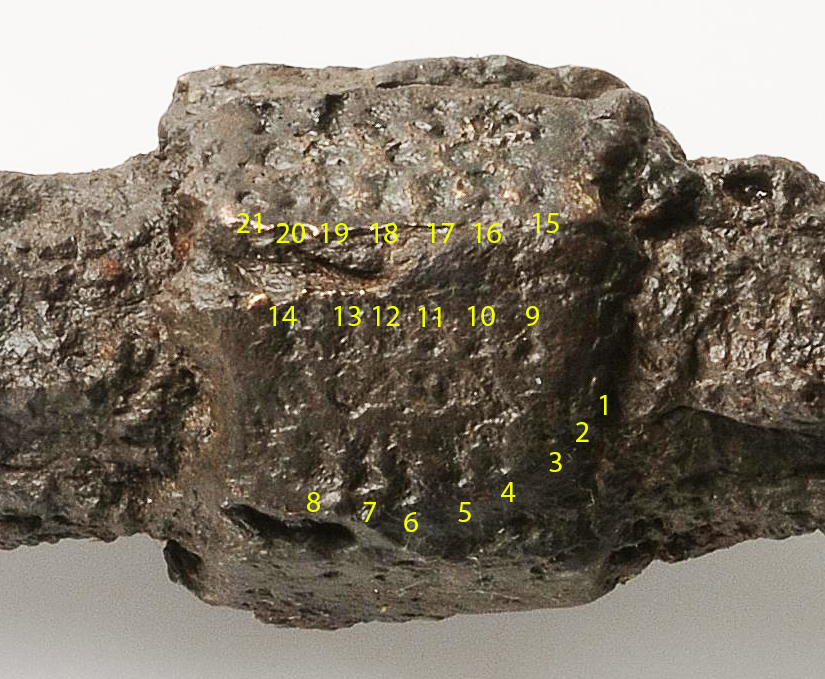
The central-most bronze knob has many bas-relief dot indents at irregular intervals across its side and top faces. Measurements taken from the bottom-most duck eye resolve upon dot-indents 1 to 14. Measurements taken from the topmost duck eye resolve upon dot-indents 15 to 21.
In the future, museum scientists, using state-of-the-art equipment, should be able to identify where all the surviving dot-indents are for all sides of the artefact. By this means many additional codes-of-position can be extracted and deciphered.
It must be remembered that the indent-dot marks were for mnemonic recall of particular numbers from which a mathematical progression could be launched. The precise number had been memorised by rote and repetition in the severe "Schools of Learning" under tutelage of highly trained masters. On the rods themselves, a set of dual legged calipers stretching from the duck-eye position to a dot-indent, with the flared-leg ends then measured against a calibrated rule, would identify the distance with sufficient precision to recall the full number.
Here are the codes of position in relation to the bottom eye centre:
(1). 1.92" (2). 1.96875" (3). 2" (4). 2.0736" (5). 2.16" (6). 2.25" (7). 2.304" (8). 2.4". We then go up a level to : (9). 2.025" (10). 2.112" (11). 2.2" (12). 2.268" (13). 2.3625" (14). 2.43".
Beyond this the top-face dot-indents are measured from the top eye centre:
(15). 2.016" (16). 2.1" (17). 2.178" (18). 2.268" (19). 2.346666" (20). 2.4" (21). 2.475".
It will be observed that on the top surface there are other obvious signs of surviving dot-indents in lines & rows (some looking a little haggard and disheveled). Here are further codes of position:
(22). 2.061818182" (23). 2.3625" (24). 2.24" (25). 2.33333" (26). 2.43" (27). 2.48832". (28). 2.551.5". We'll now go up a level into an area that has some clear markers and others that are quite damaged or obscured:
(29). 2.016" (30). 2.0625" (31). 2.1" (32). 2.16" (33). 2.268" (34). 2.346666" (35). 2.4"... etc.
Researchers wishing to extract the "Real" magic contained within these Volva-Seidr wands are encouraged to place one of the base numbers listed into a calculator, push + + and then = to see the progression grow. The ancient wise-women of Scandinavia, as well as their male counterparts, had to do this from memory ... brilliant, brilliant people!
The numbers listed are part & parcel of the NUMBERS OF CIVILISATION that were once highly revered, but are now largely forgotten.
Anyone wishing to legitimately call themselves a DRUID needs to become intimately acquainted with these number-strings and the meaning inherent in each number, as this knowledge was at the heart or very essence of Druidism.
Conducting daily affairs, based upon these cyclic, calendar or navigational numbers led to a vibrant, organised society, with the very best chance of abundance, happiness, success and survival for countless generations.

Each section of the staff / wand would have been fabricated to carry length and diameter codes extractible by measurement. Because of the very dilapidated state of the ancient artefact, the final estimation related to the segment codes will now have to be undertaken in a laboratory. However, in the wand's present state, the segments appear to comply to the above measurements.
(1). The hilt or pommel end: This measures .55" and the range of numbers generated by this progression relate to navigation using the mile of 5280', as well as all associated increments of length within that system. The progression goes:
.55, 1.1, 1.65, 2.2, 2.75, 3.3, 3.85, 4.4, 4.95, 5.5 ... 6.6 ... 8.25 ...9.9 ...11 ... 13.2 ... 14.85 ... 17.6 ... 19.8 ... 24.75 ... 26.4 ... 27.5 ... 29.7 ... 35.2 ... 55... 59.4 ... 66 ... 89.1 ... 90.75 ... 99 ... 105.6 ... 165 ... 206.25 ... 264 ... 660 ... 5280 ... 5940 ... 7920 ... 16500 ... 24750 ... 130680000.
Derived from the above read-out we have the increments of a link, 7.92" (1/8000th of a mile of 5280'), a fathom @ 5.5' ( 1/960th of a mile), a rod or perch @ 16.5' (3-fathoms & 1/320th of a mile), a chain @ 66' (1/80th of a mile), a furlong or furrowlong of 660' (1/8th of a mile), the mile of 5280' (called the English mile), the mile of 5940' (called the Scottish mile) & the league @ 16500' (3.125 English miles). Under this navigational system, the diameter of the Earth was considered to be 7920-miles and the circumference 24750-miles or 7920 X 3.125 (a rounded variation of PI). In feet of 12" the equatorial circumference was read as 130680000'.
(2). Beyond the hilt or pommel section the bronze knob has a length of .8", divided by a centre ring, and, in conjunction with the hilt length, the distance to the next handle section is 1.35". A progression based upon this number relates to compass, lunar-cycle, Precession of the Equinoxes and navigation readings.
(3). The next segment of the handle appears to be 1.08" in design length. This would make sense in that 1.35" + 1.08" = 2.43" (another very important code). A progression based upon 1.08 goes:
1.08, 2.16, 3.24, 4.32, 5.4, 6.48, 7.56, 8.64, 9.72, 10.8 ... 12.96 ... 15.12, 16.2, 17.28 ... 19.44 ... 22.68 ... 25.92 ... 27 ... 30.24 ... 51.84 ... 60.48 ... 6804 ...69.12 ... 77.76 ... 90.72 ... 130680000
This is a navigational progression, based upon the dimensions of the Great Pyramid and using a mile of 5280', for an equatorial circumference of 24750 English miles or 22000 Scottish miles of 5940'.
Combining the segments, thus far, achieves 2.43", for yet another dynamic code that goes:
2.43, 4.86, 7.29, 9.72, 12.15, 14.58, 17.01, 19.44 ... 29.16 ... 34.02 ... 68.04 ... 77.76 ... 97.2 ... 116.64 ... 155.52. These values can be used in calculations related to the lunar period within the lunar nutation cycle of 6804-days or divisions within the equatorial circumference of the Earth. For example: A distance of 155.52-miles would be 1/160th of the 24883.2-mile equatorial circumference.
(4). The next brass knob is a resolving-target for many dot-marked codes.
(5). The next handle segment is bracketed on each end by brass knobs. It appears strongly to carry a length code based upon the PHI reciprocal of 1" ÷ 1.618034 = .618034" ... (X 2) = 1.236068" for the length of this segment. This is a diminished division (1/10th) of the ancient Swedish-Norwegian measurement found by researcher, Gary Anderson @ 12.36068" or 1.030056'.
Knowing this very important, PHI-related increment was essential for "squaring the circle", when fabricating precise capacity tubs for grain volumes being sold at the marketplace.
MEASUREMENTS FROM THE HILT-END TO MARKED STATIONS ON THE DUCK HEAD

The eyes of the duck head are known to be stations for measurements to the dot-indents on the most central bronze knob. However, they are also used as resolving positions for code-bearing measurements from the extreme hilt-end of the wand.
Likewise, the multiple circle features cast into the duck beak and nostril regions are also resolving areas for coded measurements from the hilt-end. When one of the beak circles has to accommodate more than one coded length, the resolving position will be offset, but still well within the boundaries of the target circle. Here are the codes of position:
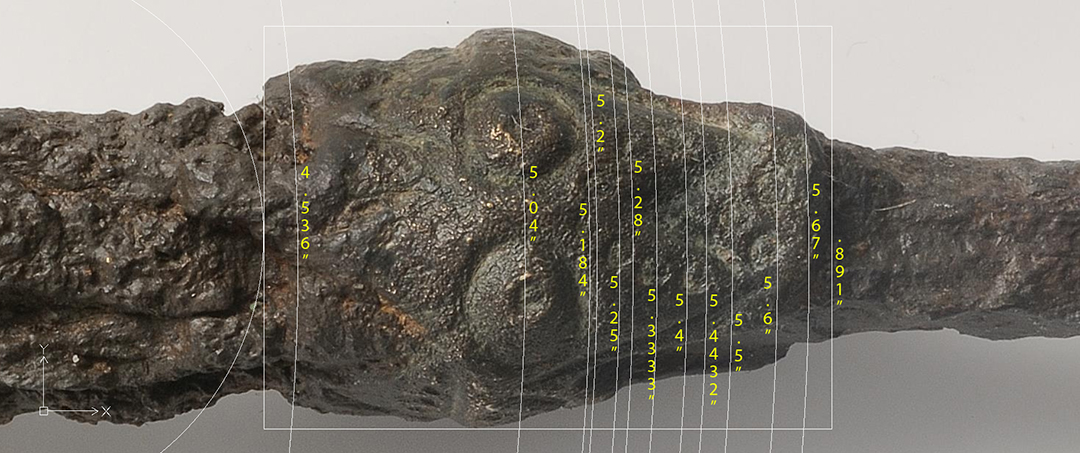
(1). At the rear of the head (upper left) there appears to be a dilapidated dot-marker that codes 4.536" from the hilt. This is speculative. The 453.6' value is found upon the Great Pyramid (navigational coding).
(2). A circle line from the hilt-end crosses perfectly over the two eyes at a distance of 5.04". According to the Great Pyramid's literal navigational system, 1-second of equatorial arc is 100.8' (50.4' X 2).
(3). A circle line from the hilt-end resolves to a cast-circle @ 5.184". This very important number was much used in navigation, the slope angle of the Great Pyramid (51.84-degrees) and 1/5th of the Precession of the Equinoxes duration of 25920-years.
(4). The same resolving cast-circle accommodates a crossing circle radius of 5.2" (lunisolar calendar ... 52 months per annum).
(5). A line crosses over a cast circle set at 5.25" from the hilt (the Greek mile is 5250').
(6). The same cast circle accommodates a line from the hilt-end 5.28" distant (the English mile is 5280').
(7). A crossing line perfectly dissects cast-circles at a distance of 5.33333" from the hilt-end. Note: Le Pied du Roi (Foot of the King) of France was 1.066666' or 2 X .533333' (12.8" ... navigation and 1/64th divisions).
(8). A line crosses a cast-circle at 5.4" from the hilt-end (navigation & lunar count coding).
(9). The same cast circle accommodates a line of 5.4432" (navigational coding for an equatorial circumference set at 130636800' ... 12 X 12 X 12 X 12 X 1.2 Greek miles.
(10). A line from the hilt-end crosses a circle near the nostrils at 5.5" (An English Merchant Navy fathom was 5.5' into the 20th century).
(11). A line crosses two nostril circle at 5.6" (weights standards, navigation).
(12) . A line brushes the very end of the duck's beak at 56.7" (lunar coding within the 6804-day lunar nutation cycle).
STAFF 53865 - HST
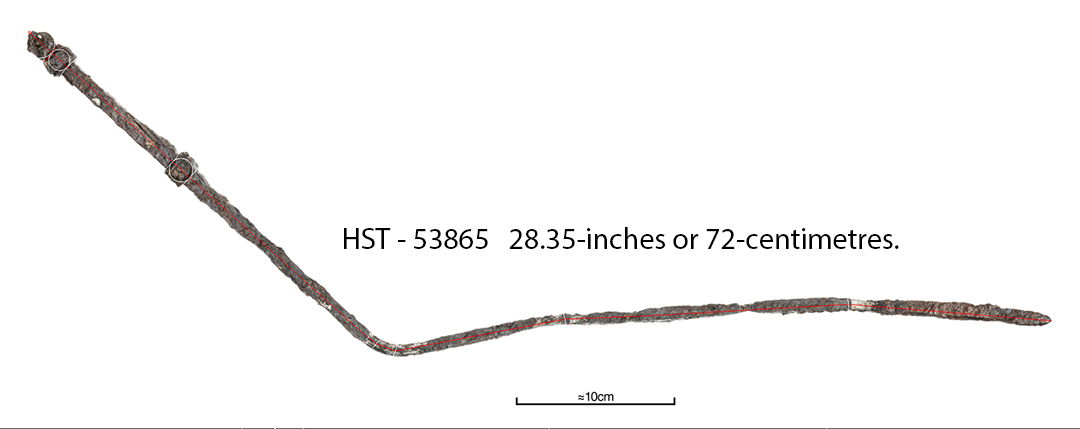
In keeping with tradition, this staff was deliberately bent before placing it in the grave of its Volva-Seidr, wise-woman owner. Despite the quite severe bend in its iron rod section beyond the handle it appears to have survived at its full original length.
The Staten Historika Museum scaled image was taken into AutoCAD, carefully scaled in centimetres (according to the scale bar), then re-scaled into inches in order to identify the intended, number codes built into its various segments by the fabricators. Very careful measurements were done, in stages, down the length of the bent iron rod to ascertain the true length beyond the handle, resulting in a measurement of 22.95-inches.
Next, the section from the end of the hilt-pommel and forward brass knob, through the handle and final knob were also measured. The resultant length of that combination of 4 sections was 5.4-inches, making the overall length of the entire staff 22.95" + 5.4" = 28.35". So, is there any significance in this finalised length?
Well, ... Um ... Errr ... one would be hard-pressed to find a measurement more significant and dynamic than this! Here's why:
The Khafre Pyramid of Egypt has a ground perimeter value of 2835' for one full circumnavigation. This was based upon each side being 708.75' (15/16ths the length of the Great Pyramid) or 2 X 354.375' ... the lunar year is 354.375-days.
The Khafre Pyramid was a pyramid of the Moon.
There are 8 lunar years in 2835-days and, in the 6804-day lunar nutation cycle, there are 2.4 X 2835-days.
This coded length in the staff shows a preoccupation with monitoring the daily position of the Moon around the Earth, as well as the Earth's daily position around the Sun within the lunisolar Sabbatical Calendar count and lunar nutation cycle count.
For Volva wise-women, imparting sound information (sooth) to farmers, related to when the difficult, lean times would occur in the production of crops ... or when growing conditions would markedly improve to relieve famine conditions, this lunar cycle knowledge (and the ability to make long-term weather predictions) was absolutely essential to soothsaying.

A careful measurement of the surviving hilt-pommel and handle components, with known, important code-bearing lengths in mind, seems to strongly suggest that the above numbers were chosen for inclusion. Here are the associated mathematical progressions that are generated from the numbers:
.792, 1.594, 2.376, 3.168, 3.96, 4.572 ... 6.336, 7.128, 7.92 ... 19.008, 19.8 ...23.76 ... 35.64 ... 118.8 ... 130.68 ... 6534 ... 130680000.
This progression relates to the diameter and equatorial circumference of the Earth, based upon using the mile of 5280 feet, for a full equatorial circumference of 24,750-miles. The value, 3960-miles would be the Earth's radius and 7920-miles its diameter. The value 130680000' represents the full circumference under this navigation system.
.525, 1.05, 1.575, 2.1, 2.625, 3.15, 3.675, 4.2, 4.725, 5.25 ... 6.3... 7.875, 8.4 ... 9.45 ... 12.6 ... 13.125 ... 14175 ... 16.8 ... 18.9 ... 25.2 ... 28.35 ... 37.8 ... 630 ... 756 ...5250 ... 130636800
This progression relates to, what became the Greek method of navigation, using a mile of 5250' for an equatorial circumference of 12 X 12 X 12 X 12 X 1.2 Greek miles (24883.2-miles or 130636800 feet of 12").
It should be noted that anytime the 5250'-mile was encoded, the 5280'-mile was inferred for mnemonic recall and vis-versa. This dual encoding is found on megalithic, standing-stone and outlier mound-marker sites away from a hubstone, where the ends of the two types of miles are marked within a short distance of each other (30' difference).
The centre part of the handle (the handle-proper) is 3.5". This is in homage to 35000' or the Swedish Mil (18000 Rydaholmsalm of 1.94444' each or 7200 Roman Paces of 58.3333" each).
The last brass knob is coded to represent .58.32" or .583333" simultaneously, and both forms of the value were used in ancient metrology, one in weights & volumes readings, as well as lunar cycle calculations, etc., whereas the other was used in overland measurements, as well as the Roman value for the Earth's equatorial circumference.
The length of the handle is 5.4" and a progression based upon 5.4 goes:
5.4, 10.8, 16.2, 21.6, 27, 32.4, 37.8, 43.2, 48.6, 54, 59.4, 64.8 ... 75.6, 81, 86.4, 97.2 ... 113.4 ...118.8 ... 129.6 ...135 ... 151.2 ... 172.8 ...194.4 ... 2268 ... 5832 ... 6804 ... 11664 ...25920 ... 130680000.
Again, a dynamic progression containing navigation, lunar-cycle and Precession of the Equinoxes values.
The primary purpose of designing and fabricating this Volva staff was to achieve a full number coded length of 28.35" or 3.54375" X 8 in homage to the lunar year. With the 5.4" handle taken out of the equation, the iron shaft achieved 22.95" of length. It seems apparent that the shaft designers wished to infer 22.9166666" in this length, as it constituted a very important code in navigation. Here's a progression:
22.9166666, 45.833333, 68.75, 91.66666 ... 137.5 ... 206.25 ... 275 ... 343.75 ... 412.5 ... 550 ... 618.75 ... 132000 ... 24750.
This progression is for world navigation using the mile of 5280 . In the line-up, 68.75-miles equates to 1-degree of equatorial arc and the sum of 6187.5-miles would be 1/4th of the Earth's equatorial circumference (24750-miles under this navigational system).
Visually, on the iron rod, the difference between 22.95" and 22.9166666" = 1/30th of an inch ... a very reasonable mnemonic compromise.
Whoever carried this staff / wand really had several systems of navigation in hand, as well as knowledge of what to expect, weather-wise, during the long lunisolar cycle of 6804-days duration.
Yes indeed, amidst a famine and in hard times, I'd definitely be pleading with this wise lady, 'Soothsayer, say me some sooth! ...when will the good-times roll again?'
B2782 - SØRHEIM, LUSTER,

The overall, official length of the Volva-Seidr staff found at SØRHEIM, LUSTER, Norway in 1872 is 92 centimetres (rounded) or about 1/15th of an inch shortfall on 3.024'. There are multiple very important measurement codes in the various component-divisions of this staff or the length overall.
(1). The overall length of 3.024' is for mnemonic recall of the perimeter value of the Great Pyramid of Egypt @ 756' per side or 3024' for one complete circumnavigation. The "inch" value of 3.024' is 36.288" which provides numeric reference to 362880' or 1-degree of equatorial arc under the Great Pyramid's circumference of the Earth reading. A mathematical progression based upon 3024 goes"
3024, 6048, 9072, 12096, 15120, 18144, 21168, 24192, 27216, 30240, 33264, 36288 ... 45360 ... 75600 ... 362880 ... 378000 ... 130636800.
(2). Simultaneously to coding a staff length of 3.024' & 36.882", the overall length also, for mnemonic recall, encodes 3.025' & 36.3". This introduces a second navigational system based upon the symbolic elongation of the pyramid's side length by another 3" to 756.25". Under this navigational system the perimeter value of the pyramid is read as 3025' for half a minute of equatorial arc and 363000' for 1-degree of arc . A mathematical progression based upon 3025 goes:
3025, 6050, 9075, 12100, 15125, 18150, 21175, 24200, 27225, 30250, 33275, 36300 ... 45375 ... 75625 ... 363000 ... 378125 ... 130680000.
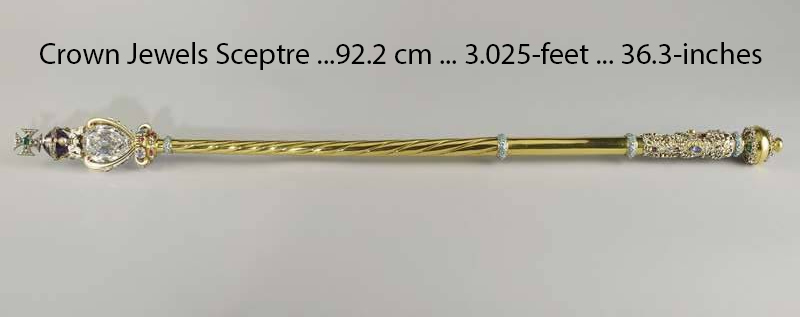
With the passing or Queen Elizabeth II of Britain on September 8th, 2022, Her son Charles will have his coronation as king on May 6th 2023. At this occasion the royal sceptre will feature in the coronation ceremony.The royal sceptre of the crown jewels was first fabricated in 1661 AD and modified in 1911 to incorporate the Cullinan diamond (The Star of Africa).
Knowing the obsessive-compulsive nature of the British to religiously retain adherence to tradition, the modification would need to comply with an existing length within the parcel of ancient measures. At 92.2 centimetres of length it converts to 36.3-inches to a tolerance of 1/1268th of an inch or 1/5th of a millimetre. It therefore codes 3.025' or 36.3" and, under the navigational system that the British adopted using their mile of 5280-feet, the sum of 3025' was half a minute of equatorial arc and a degree of arc was 363000' in a world considered to be 24750-miles in circumference.
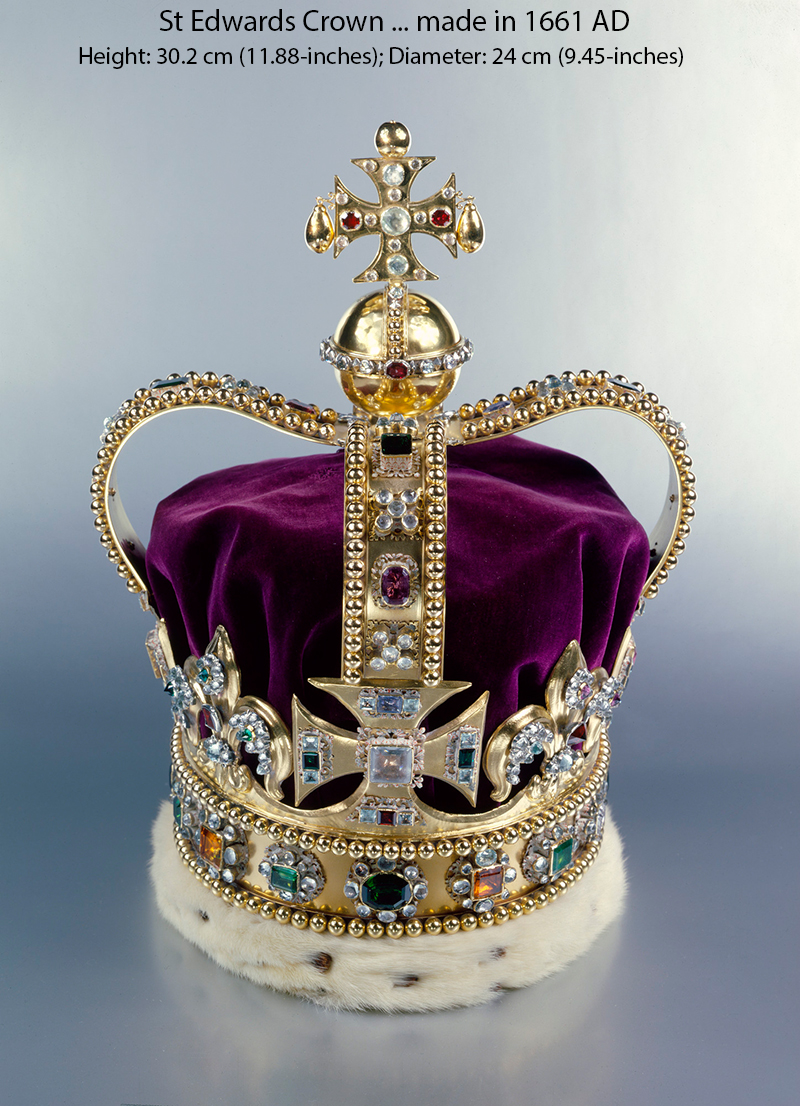
At 24 centimetres width the St Edwards Crown would equate to .7875-feet (63/80ths) to a tolerance of 1/10157th of a foot. Using PI @ 22/7ths this converts to a circumference of 2.475-feet for mnemonic recall of the equatorial circumference of the Earth under the English system of 24750-miles of 5280-feet each. Note: The ancient Hebrew Desert Weight Heavy Talent was 787500 grains.
If the diameter was rendered in inches (9.45"), using PI @ 22/7ths the circumference would read 29.7". Note: the Scottish mile was 5940-feet or 2970' X 2 (1-furlong longer than the English mile). The 24750 English mile equatorial circumference would equate to 22000 Scottish miles. Note: The Jerusalem Heavy Talent was 94500 grains.
The overall height of the crown is officially 30.2 cm, which converts to 11.88-inches to a tolerance of 1/102nd of an inch or .248 of a millemetre. The sum of 11880' would equate to 2 Scottish miles or 1/11000th of the equatorial circumference of the Earth.
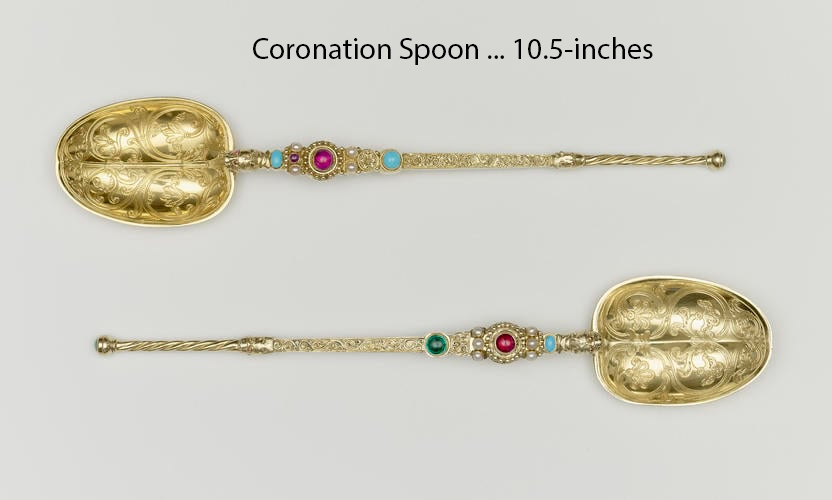
The Coronation Spoon from the British Crown Jewels was fabricated in the 12th century and measures 12.7 centimetres or 10.5-inches to a tolerance of 1/85th of an inch. The Hebrew Reed measurement was 10.5-feet or 10 Greek feet of 12.6-inches each. The length of the Coronation Spoon would be 1/12th of a reed or 1/6000th of a Greek mile. By placing the 10.5 value of the Coronation Spoon, mnemonic device into a mathematical progression, numbers of the Greek navigational system could be generated.
These navigational systems were used by the Viking-era Scandinavians, as evidenced by their Weights, Measures & Volumes standards.
Based upon these numbers generated by the Great Pyramid's perimeter value, it may be timely to introduce weights standards, in use within Scandinavia contemporary to the fabrication of this Volva-Seidr staff.
Archaeologist, Susan E Kruse states: “post-Viking Age sources note that the standard weight unit of Scandinavia was the mark which was divided into “8 ore, each of which consisted of 3 ortugar.” See: Ingots and weight units in Viking Age silver hoards.
The estimated (averaged) weight of an Ore is given as 24.49 grams, which translates to 377.93846 grains.
The grain-weight system is, of course, very ancient and each value chosen in a standard weight division had to be based on a very significant number from within the special parcel of scientific numbers. Whereas the value 377.93846-grains would have no significance whatsoever, the value 378-grains would be highly significant @ 1/17th of a grain more. The Roman gold standard Talent was 37800-grains.
The Great Pyramid is 2 X 378' per side and 378' would be 1/8th of 1-minute of equatorial arc or 3.75-seconds of arc for the world (100.8' per second).
But Dr Kruse also states that the standard weight in Scandinavia was the Mark, which was 8 Ore, each of which consisted of 3 Ortugar. That puts a Mark at a weight of 3024-grains (the number of feet in one complete circumnavigation of the Great Pyramid or half a minute of the Earth's equatorial circumference. By consequence, the Ortugar would be 126-grains. Note: The Greek foot was 12.6" and the Hebrew reed was 126" or 10.5' of 12-inches.
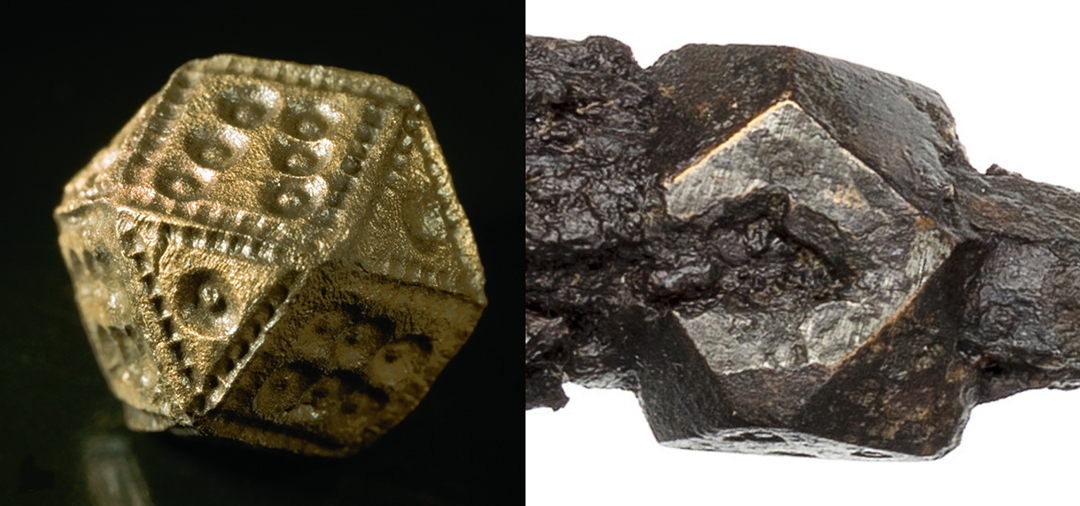
A comparison between a Viking era, dot-stamped, cubo-octahedral weight, used on balancing-scales for weighing out precise quantities of, say, gold, silver or spices, etc., (assaying). The weight is seen alongside the very similar circle-marked bronze knobs affixed to some Volva-Seidr staffs ... an obvious cultural parallel.
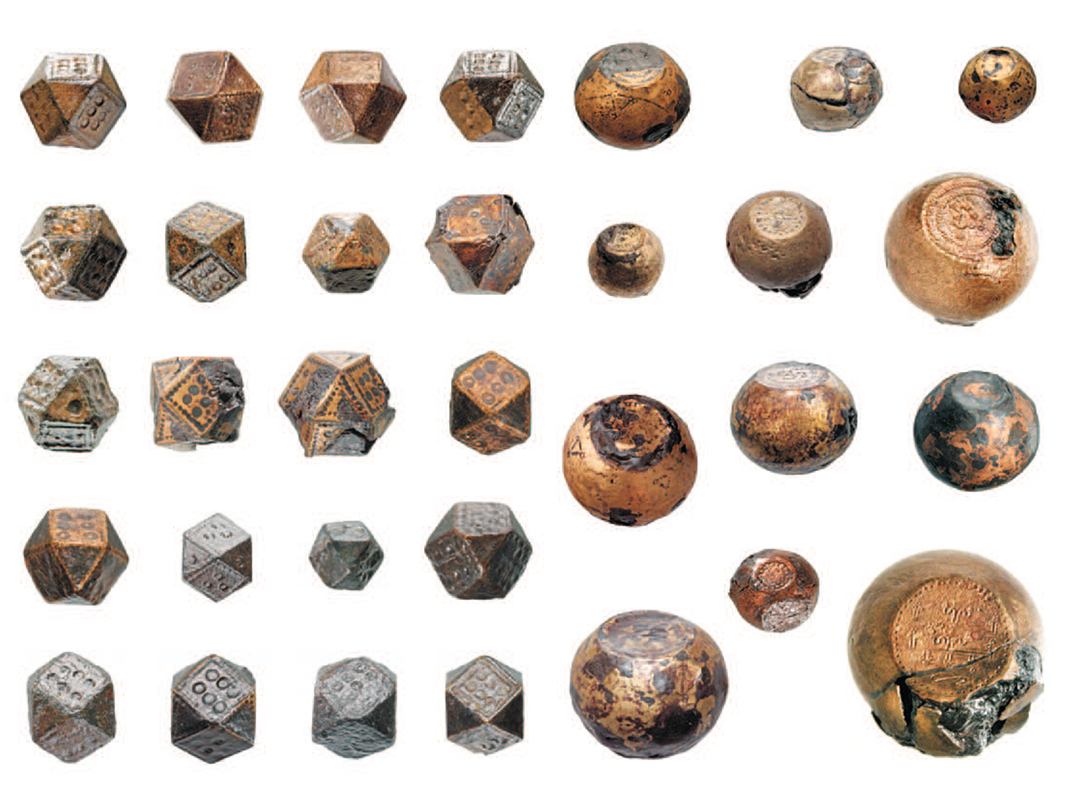
Many high-quality, copper coated iron weights in cubo-octahedral or spherical configurations have survived and show sophistication in doing accurate transactions according to grain-weight standards. Each of the above weights have punched spherical or other marks to indicate the true weight and the general consensus amongst merchants was that such weights were reliable.
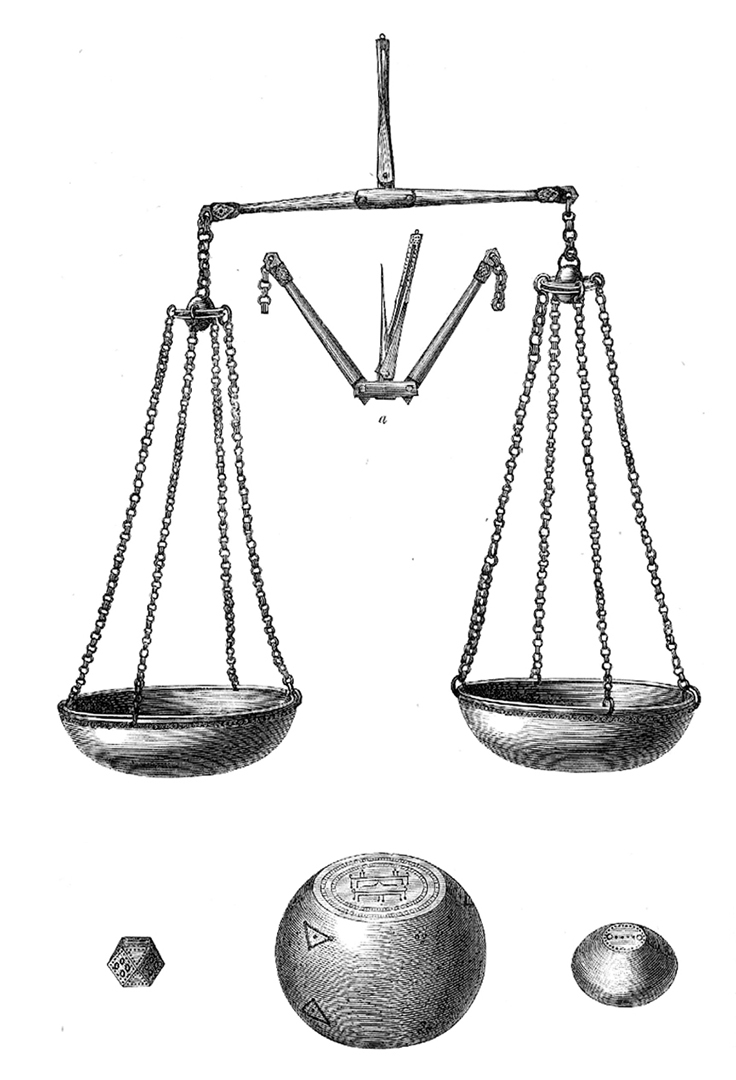
Balancing scales like this were common objects in Scandinavian marketplaces and scale parts have been located amongst the grave-goods of Volva-Seidr practioners, along with weights of various kinds. This show that they were pro-active in measuring out precise quantities of coins, precious metals, jewellery beads, amber or spices, etc.
(3). The length of the iron shaft for Volva-Seidr wand B2782 is 25.6" and a mathematical progression generated by this value goes:
256, 512, 768, 1024, 1280, 1536, 1792, 2048, 2304, 2560 ... 3840 ... 4608 ... 5376 ... 5888 ... 6400 ... 6912 ... 9126 ... 19200 ... 20736 ... 130636800.
Note: the sum of 69.12-miles was 1-degree of equatorial arc in the 24883.2-mile reading.
The 256 value is an expression of: 2, 4, 8, 16, 32, 64, 128, 256, 512, etc., and infers subdivisions within a 320-division circle This is what mariners and others have traditionally done since time immemorial in the reading of degrees within a 360-degree compass environment. We therefore have compass bearings as 180, 90, 45, 22.5, 11.25, etc., or 320th divisions within 360-degrees.
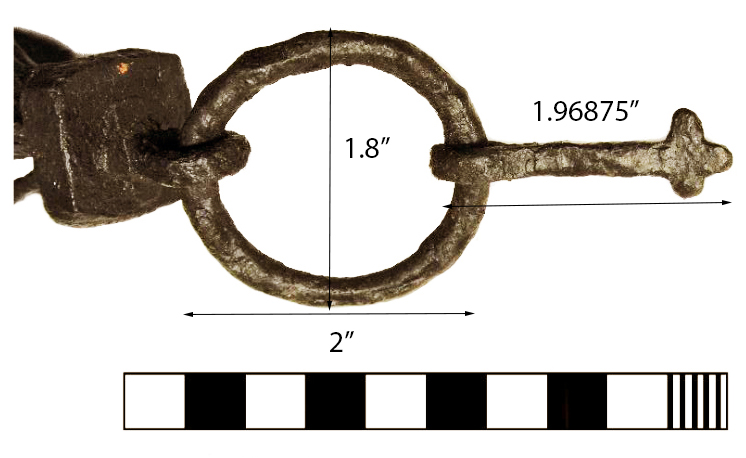
Here are the additional scientific numbers encoded into the staff's attached ring. The value 196.875-grains was the Egyptian, Greek and Roman Beqa for assayers measuring out gold dust. There would be 1.8 periods of 196.875-days in a lunar year of 354.375-days.
(4). The overall handle length of 7.0875" is, of course, just for mnemonic recall of 2-lunar years @ 354.375-days each. The length of the Khafre Pyramid of Egypt was designed to be 708.75' or 15/16ths of the Great Pyramid @ 756'.
(5) The 3.6" ring segment length is for mnemonic recall of the 360-degree compass.
B7066 – HØYHEIM, LUSTER, NORWAY.
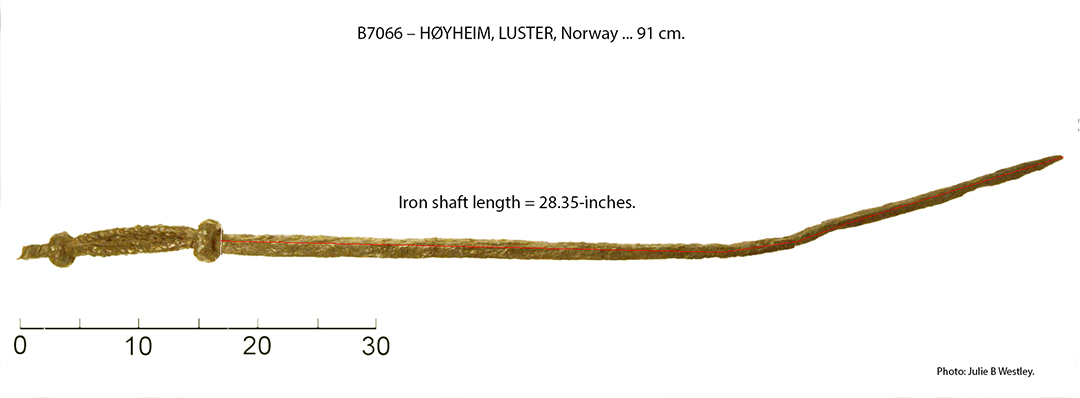
This almost complete Volva-Seidr staff was excavated from a Norwegian gravesite in 1919. The only discrepancy to its present, measured length (91 cm.) is that there is damage to its hilt pommel, resulting in the loss of a short amount of material.
The actual iron rod lengrh, before the handle, codes the perimeter value of Egypt's Khafre Pyramid for all four sides and the sum of 2835-days would equate to 8-lunar years of 354.375-days each. With this iron rod frontal section encoding the value 28.35", it duplicates the overall length code of Volva-Seidr staff HST- 53865 (72 cm.). The sum of 2835-days would equate to 96 lunar months of 29.53125-days (accurate to under 1-minute of the true lunar month duration).
We'll now consider the additional length codes provided by the handle section:
At a measurement of 91centimetres the converted value in feet of 12-inches = 2.985564218', which is tanalisingly close to 2.953125. Because the measured value overshoots 2.953125' we must assume that the design length was slightly larger, unless the 91 cm measurement was "rounded" to the nearest centimetre. However, assuming full accuracy, what is the most plausible estimation of what the true design length was intended to convey?
By the addition of a mere 1/230th of a centimetre of hilt-end material the metric measurement of the entire staff would increase to 0.9144000264810248 and, in inches, achieve a measurement of 36" (3') for the overall length of the staff.
For the Volva-Seidr wise-woman bearer of the staff, was there mnemonic interplay between 3' and 2.953125'? This seems likely for the following reason:
About 900-years before the existence of this Volva-Seidr rod's fabrication, the Druids of France had built the Calendar of Coligny bronze, parapegma plaque which traced the daily positions of both the Sun and the Moon, side-by side, using small pegs in holes. The idea was to always stay abreast of the Moon's oscillating position in relation to the Earth simultaneously to the Earth's position around the Sun ... under the 6804-day lunar nutation cycle.
On the Calendar of Coligny plaque the solar month was 30-days and the lunar month set to 29 full days ... obviously inferring 29.53125 (29 & 17/32nds) ... as it's a bit hard to fit 17/32nds of a peg in a hole.
To read about the workings of the Calendar of Coligny, go to: http://www.celticnz.co.nz/Coligny/ColignyPart1.htm
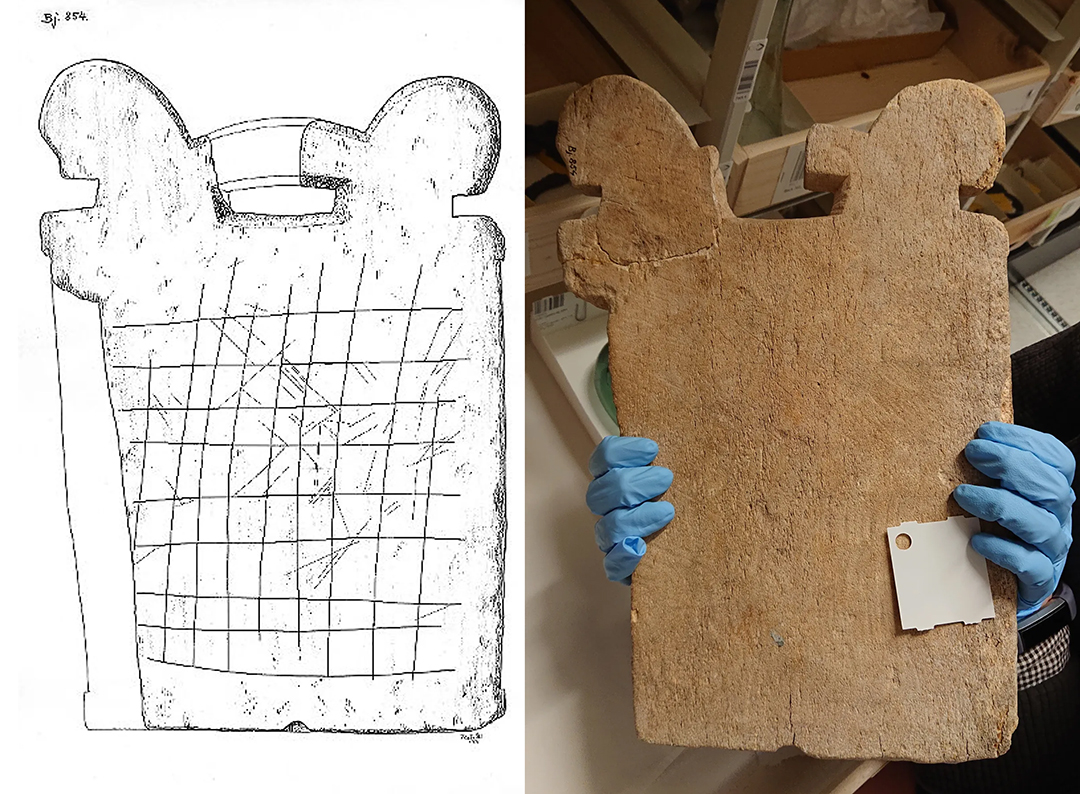
This 64 square matrix board, made of whalebone was located amongst the grave-goods of a woman at BJ-854, Birka, Sweden.
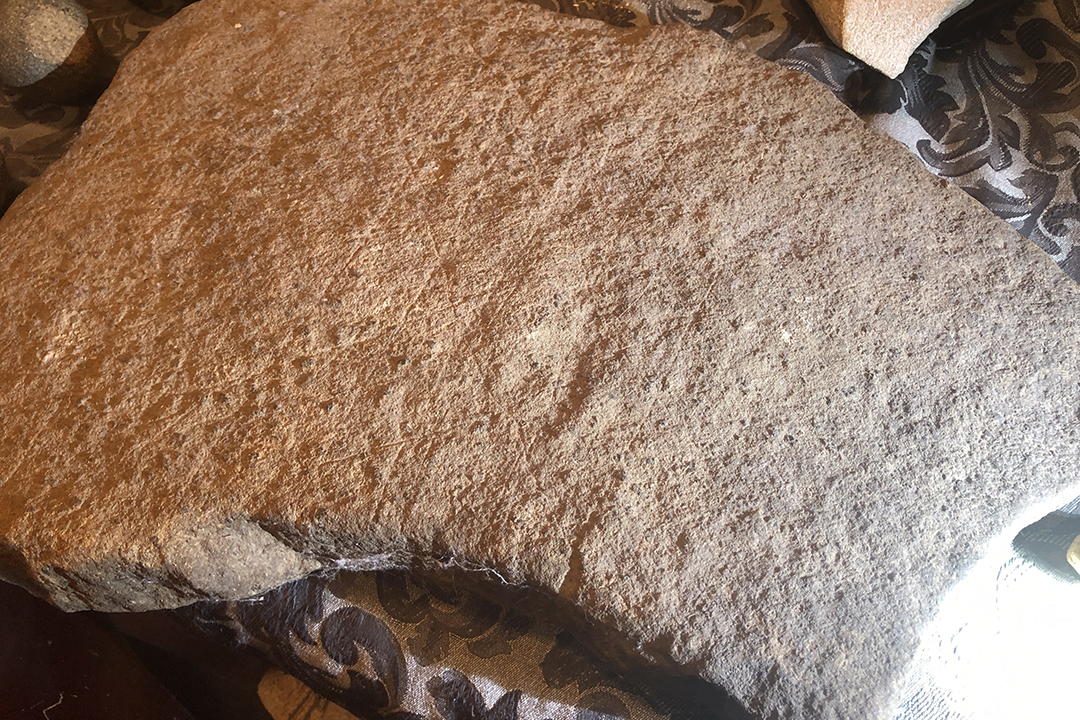
A 64-square matrix stone-slab found at Raglan New Zealand beside a large obelisk that used Mount Karioi as the outer marker for an equinox sunset (solar observatory). Local legends abound with reference to an ancient Viking presence, including a shipwreck. There are many similarly incised stones in the region, including some that seem to be inscribed with rune writing.
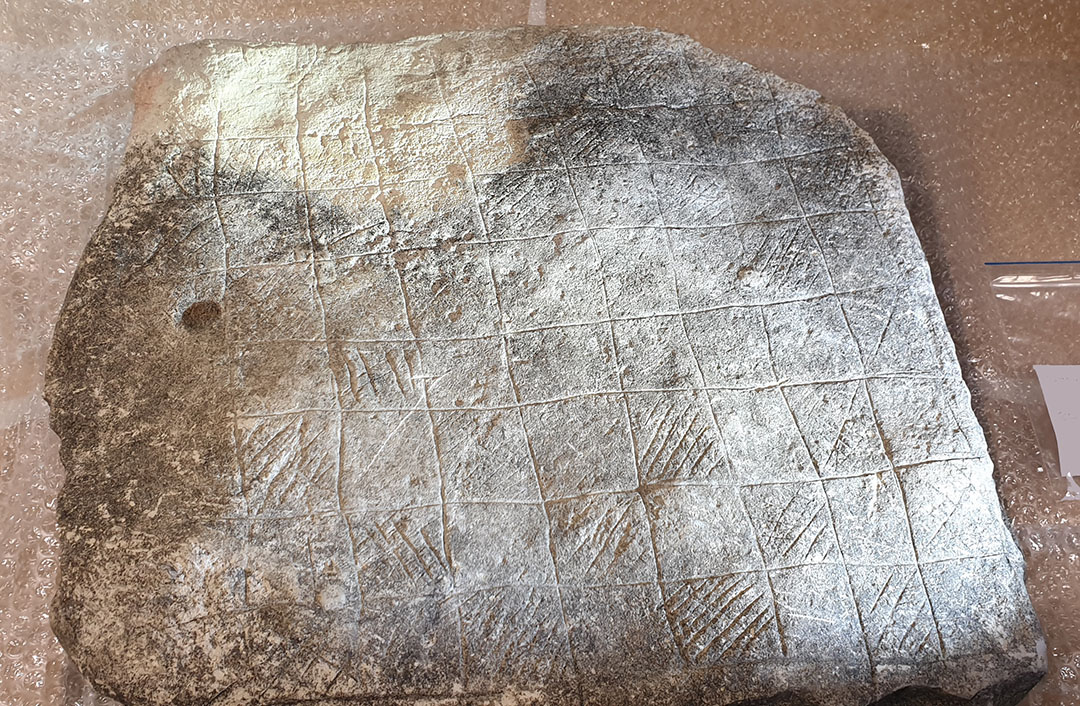
Yet another 64 square matrix stone located at Raglan, New Zealand, this one in the town's museum. Within many of the 64-squares there are differing numbers of diagonal strokes that seem to be related to counting. This matrix appears to have two additional intercalary squares sitting at the top left & outside the 64-squares. The Calendar of Coligny also used two intercalary squares for additional calculations.

The brutalised-smashed Calendar of Coligny. Fortunately, just enough survived to tell us the names of all the sections and how they worked for tracking the daily progress of both the Sun & Moon within 7 solar-years, 7.2 lunar years and throughout the 6804-day lunar nutation cycle.

The Druidic Calendar of Coligny was set out as 64 squares, subdivided into two parts. There were two special "CIALLOS" regions, used for inserting intercalary days as needed. Although little is left of one CIALLOS region, we are still able to see that each represented 30-days (MAT). The fully titled months of the calendar plaque were split into biweekly sections. Six of the months were composed of a total of 30-days (solar months). The other six months were composed of 15-days in the first biweekly section and 14-days in their second biweekly section (meaning 29.53125-days for a lunar month).
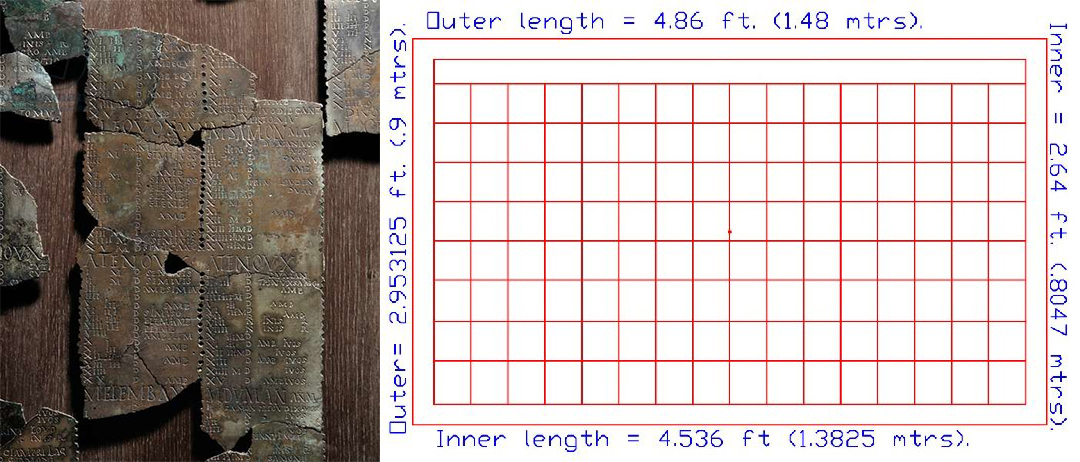
When the Calendar of Coligny plaque was smashed (Romans?, ... Christians?) it tended to fracture / tear along the peg holes ... like a postage stamp. The dimensions of the Calendar of Coligny plaque are very recognisable:
(1) Outer length = 4.86' or 58.32" (1 Roman Pace)... This is 2.5 Swedish Rydaholmsalm (1.944444') using the overland Pace of 58.33333". Note: The 6804-day duration of the lunar nutation cycle = 486 periods of 14-days (2 weeks).
(2) The inner length = 4.536' and there would be 1.5 X 4536-days in the 6804-day lunar nutation cycle. Also the length of the Great Pyramid in inches is 9072" or 4536" X 2 and the vertical height of the Great Pyramid to the flat floor at the top is 453.6' (Note: in all recorded history the Great Pyramid has always had a flat top).
(3) The outer height of the Calendar of Coligny was 2.953125' or 35.4375" and the lunar month is 29.53125-days, whereas the lunar year is 354.375-days.
(4) The 6804-day lunar cycle is 360 X 18.9-days or 3.6 X 1890-days. For remembering the duration of a solar month the formula is 1890 ÷ 63 = 30-days. Alternatively, the formula for remembering the lunar month duration is 1890 ÷ 64 = 29.53125-days. Note: The calendar of Coligny is made up of 64 byweekly squares, two of which can be intercalary sections for other calculation options.
63 squares provide solar readings in months of 30-days while 64 squares provide lunar month readings. For convenient tracking of the solar & lunar periods throughout 6804-days (in a 360-degree circuit), one could move through the entire 64-squares of the bronze plaque 3.6 times marking both the solar and lunar periods with pegs for each day. Note 2: The Great Pyramid @ 756' of length is 189' X 4.
(5) The Calendar of Coligny also catered for the Sabbatical lunisolar Calendar system of 2556.75-days (7 solar years) being read alongside 2551.5-days (7.2 lunar years). The formula for each period was based upon the number 5.25 (half a Hebrew-Greek Reed was 5.25'). Therefore, 5.25-days X 486 = 2551.5-days and 5.25-days X 487 = 2556.75-days.
(5) The inner height of the Calendar of Coligny was 2.64' and 2640' would be 1/2 of a mile @ 5280'. This same inner-frame side length would also have been used to mnemonically encode 2.625' for recall of 2625' or 1/2 of the 5250'mile used in navigation by the Greeks and others, including Scandinavians.
This is the lunisolar Sabbatical Calendar system, utilised by the cousin nations of the Mediterranean Basin, Continental Europe and the British Isles for thousands of years. Not everyone had access to a very sophisticated parapegma plaque like the Calendar of Coligny, but a simple 64-square matrix and a brilliant, highly-trained mind, coupled with a photographic memory would suffice to do accurate, seasonal soothsayer predictions.

This pure-iron artefact, that is impervious to rust, was dug up at an archeological site on Hisar Hill, Leskovac, Serbia in 2002 and is said to be 64.5 centimetres long (rounded?). At 2-millimetres less than that (64.3 cm), the wand-like artefact would equate to the lunar code indicating 1/14th of the 354.375-day lunar year ... or 25.3125-days (607.5-hours).
ESTIMATING THE DESIGN LENGTH OF STAFF B7066.
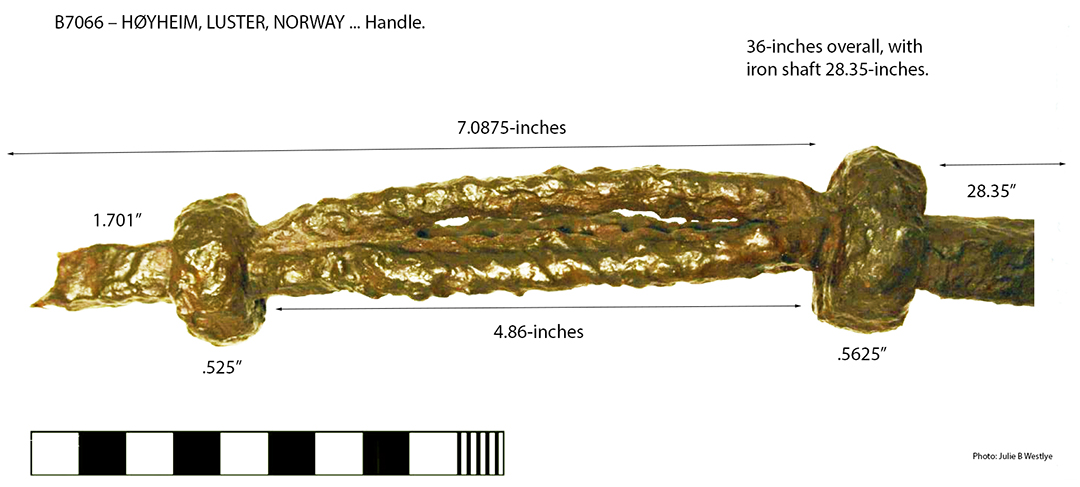
A small section of the hilt-end has corroded so badly, during over a millennium in a damp grave, as to lose some length. However, it seems unlikely that a significant amount was lost and that the overall length of the staff was designed to be 36" or 3'. This would mean that its overall length was 91.440 centimetres rather than the present, official length of 91 centimetres. The difference, .0044 cm is about 1/227th of a centimetre and seemingly beyond what the human eye can detect. It is safe to assume that a rod length of 36" was intended and that the in-built coding catered for readings within the 7-solar year, lunisolar, Sabbatical Calendar system, as well as the 6804-day lunar nutation cycle.
As best as can be determined, using scaled measurements over the corroded and damaged, slightly oblique-view photo of the artefact's handle, that the staff's sections comply to the above measurements. Therefore the bearer and interpreter of the staff would read it as: 28.35" + .5625" + 4.86" + .525" + 1.701" = 36" (35.9985 actual) or 1/667th of an inch shortfall, which is beyond human vision to detect.
(1) In the above line-up the hilt-end code recalls to mind the the number 1701 and this value in days is 1/4th of the 6804 lunar nutation cycle.
(2) The number 5.25 was used in conjunction with 486 to calculate the number of days in 7.2 lunar years, the lunar period monitored alongside 7 solar years during the Sabbatical Calendar count.
(3) The overall length of the handle from the hilt-end to the internal face of the bronze knob at the iron rod end of the handle mnemonically encoded 7.0875" in homage to the708.75' side length of Egypt's Khafre Pyramid (a pyramid of the Moon).
(4) The handle's front bronze knob appears to represent .5625" of width, which is lunar, 360-degree compass, navigation and world equatorial circumference coding that goes:
.5625, 1.125, 1.6875, 2.25, 2.8125, 3.375, 3.9375, 4.5, 5.0625, 5.625, 6.1875, 6.75 ... 7.875 ... 9 ... 11.25 ... 11.8125 ... 18 ... 19.6875 ... 22.5 ... 24.75 ... 27... 31.5 ... 35.4375 ... 36 ... 40.5 ... 45 ... 59.0625 ... 63 ... 70.875, etc.
(5) The pointed iron rod codes 28.35" in homage to the 708.75' X 4 perimeter value of the Khafre Pyramid (34020-inches ... half of 68040-inches & mnemonically recalling the 6804-day lunar nutation cycle),
An adept, highly trained reader of this staff could predict the expected weather for a region of Scandinavia, based upon oral-traditions handed down through countless generations, concerning repetitive weather conditions encountered through each phase of the lunar nutation cycle. An individual allotted three-score-&-ten years of life would experience the cycle 3 & 3/4ths times during their sojourn on Earth, so there'd be generations of experience to draw from.
B-1166 HELLEBUST, GAULAR, Norway ...coding the lunisolar Sabbatical Calendar system.

This Volva-Seidr staff is in very good relative condition, but lacks a traditional handle. Despite speculation that the hand-hold segment might have rusted off, archaeologists are not too sure that is the case and the hand-hold position may well have been forwards of the end-hilt knob. Extending backwards from the hilt-knob is a symmetrical, hook-like feature.
Julie B Westlye, University of Bergen, Norway, in her paper, "Den Sterke Kvinnen": Fra husfrue til volve. En kritisk studie av kjønn, status og magi med utgangspunkt i graver med stav fra yngre jernalder på Vestlandet states the following concerning this staff:
'Staff: indeterminate type.Iron bar with a square cross-section. 81.5 cm total length. This rod is 1 cm wide at the top and tapers down at the pointed end. The upper end terminates in a square iron plate, measuring 3 cm long, 3 cm wide and 1 cm thick, with a small "spike" on top. This staff lacks a handle like the other poles have and it is difficult to decide whether the "spike" on the iron plate is a remnant of an extended handle construction or not. ... Other finds: ... small bronze bowl probably part of a balance scale;'.
So, what was this staff used for and how did the Volva-Seidr wise-woman interpret it or provide tutorials from it?
When called upon to predict future weather conditions with good relative accuracy, the Volva-Seidr practitioners needed to know exactly where the Moon was positioned in relation to the Earth and where the Earth, tilted on its 23.5-degree axis (obliquity to the ecliptic) sat in relation to the Sun. In other words, what season was the Earth entering into in its journey around the Sun and where was the Moon, with its significant gravitational tug on the atmosphere and oceans, placed in its journey around the Earth?
The solar year is 365.25-days and the lunar year is 354.375-days, a difference of 10.875-days (10 & 7/8ths). Because ancient astronomer-scientists wished to create a lunisolar calendar system that daily tracked both the Sun and the Moon simultaneously they had to devise a system to reconcile both periods down to a close tolerance. They came up with the 7-solar year, 7.2 lunar year concept, where the two periods ended within 5.25-days of each other.
Because of this minor discrepancy in the durations of the the two periods, the druids and their forebears would commence the solar count at the Summer Solstice, then wait until the 6th day thereafter to commence the lunar count (5.25-days). At this auspicious occasion, they would cull mistletoe from a venerable oak tree with a golden sickle, dance around the tree singing "Hey-derry-derry-down" and later sacrifice two white bullocks.
The 7-year solar period would run for 2556.75-days or 487 X 5.25-days and the 7.2-lunar year period would run for 2551.5-days or 486 X 5.25-days.
Using the scale bar supplied with the photo of staff B1166 and in consultation with the published length @ 81.5 cm overall it is determined that the iron rod component, terminating against the 3 cm square, 1 cm thick,iron plate, provides a length reading of 2.55625' (2 & 89/160ths) or 30.681".
If the iron rod was set out in calibration marks of .063" (or very visually close to 1/16th of an inch) there would be 487 X .063" for the full length and one increment back from the end tip would be 486 X .063".
Note: Carpenters can handsaw timber to visual tolerances of 1/32nd of an inch or even 1/64th when blessed with excellent eyesight.
Note 2: The way the solar & lunar counts would run at optimal simplicity was in clumps of 5.25-days (126-hours ... the Greek foot was 12.6" or 2 X 6.3"). Also, 5.25' is 63".
So, the iron shaft of the staff was used for mnemonic reference to 2551.5-days (or 486 X 5.25-days ... 7.2-lunar years), simultaneously to remembering 2556.75-days (or 487 X 5.25-days ... 7-solar years).
The overall length of the staff @ 81.5 cm translates to 32-inches.
The 6804-day duration of the lunar nutation cycle divides into 32 convenient periods of which 2551.5-days is the twelfth increment or milestone arrived at. The progression runs as increases of .6 of a lunar year:
212.625 (.6), 425.25 (1.2), 637.875 (1.8), 850.5 (2.4), 1063.125 (3), 1275.75 (3.6), 1488.375 (4.2), 1701 (4.8), 1913.625 (5.4), 2126.25 (6), 2338.875 (6.6), 2551.5 (7.2), 2764.125 (7.8), 2976.75 (8.4), 3189.375 (9), 3402 (9.6), 3614.625 (10.2), 3827.25 (10.8), 4039.875 (11.4), 4252.5 (12), 4465.125 (12.6), 4677.75 (13.2) , 4890.375 (13.8), 5103 (14.4), 5315.625 (15), 5528.25 (15.6), 5740.875 (16.2), 5953.5 (16.8), 6166.125 (17.4), 6378.75 (18), 6591.375 (18.6), 6804 (19.2).
The values: 1701, 3402, 5103 & 6804 represent, in days, 1/4th, 1/2, 3/4ths, & the whole duration of the lunar nutation cycle, respectively.
Remember, the Calendar of Coligny which tracked the daily progress of both the Sun and Moon was a 64-square matrix and 2 X 32 = 64. Also the ancient 360-degree compass is traditionally read in 320-divisions, breaking down from primary points of the compass to secondary, then subdivisions beyond that. The lunar nutation cycle was undoubtedly read on a round, 32-division disk with milestone points arrived at reading as degrees of arc.
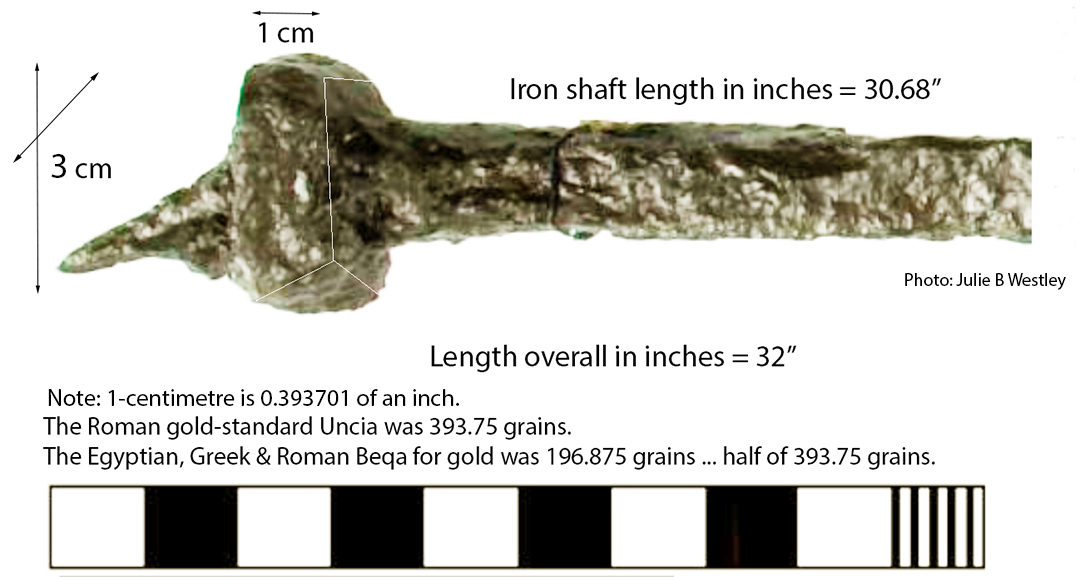
The rather symmetrical looking hook-point extending from the hilt knob may be part of the intended design of this Volva-Seidr staff. In the same grave remnants of balance-scales were also found amongst the grave goods. Is it possible that the staff, with its squared-end knob, was placed upon a table with its curved end-hook facing upwards and extending beyond the table end, then balance-scales hung on the hook for assaying work?
Note: The 3 X 3 X 1 cm square iron plate at the hilt-end of the staff would have been read as 1.18125" X 1.18125" X .39375". The sum of 118.125-days would be 4-lunar months of 29.53125-days. The sum of 39.375-days would be 1/9th of a lunar year.
B-4511 HOPPERSTAD, VIK, Norway ...The almost perfect specimen for study.
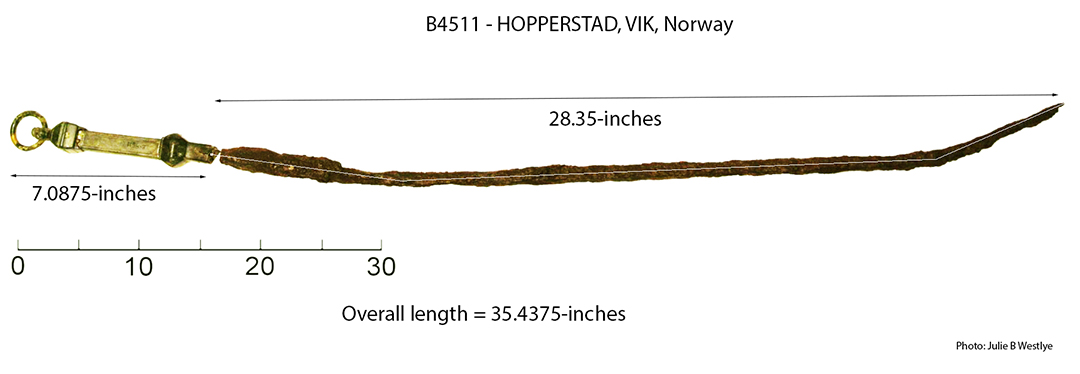
The bronze handle of Volva-Seidr staff B-4511 is in pristine condition and easily measured, even though its iron rod shaft is very corroded and broken away from the handle at the position where the brass meets the ferrous metal.
With regards to the official length of this staff, the published literature provides variable estimates, ranging from 83 cm to 90 cm. Within the exacting environment of AutoCAD however, with the artefact sized to the scale bar adjacent, the overall measurement is 88.798 cm.
The corroded, broken off ferrous metal rod, measured around its bends, accounts for 70.798 cm (70.8) and the fully bronze section of the handle adds 18 additional cm for a total length of 88.798 cm (88.8) Then, of course, this has to be converted into "old measure" and 88.8 cm becomes 34.96-inches.
The handle itself is positively 7.0875" long, so the residue measurement is 27.8725" ... which doesn't translate to a meaningful number from the ancient parcel, suggests that there's been a small amount of ferrous metal loss from the very corroded and broken iron rod ... but how much was lost?
If however the rod was 28.35" that would be truly dynamic. The required extra length would be less than half an inch and it can be seen that both the broken end of the rod and its point have suffered some loss. Moreover, 28.35" + 7.0875" = 35.4375" ... coding the length of a lunar year at 354.375-days. Also, this overall length @ 35.4375" is also 2.953125' ... to encode the lunar month @ 29.53125-days.
It seems obligatory that on such an exquisitely fashioned staff the astronomer-artisan would have wanted to incorporate such clever coding and this fact is borne out within the measurements of the handle.
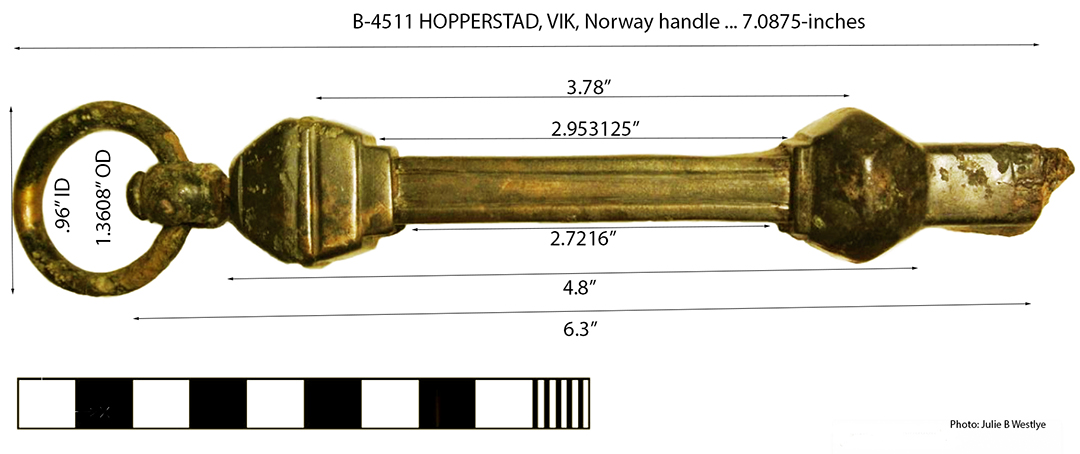
The pristine condition bronze handle was taken into AutoCAD and carefully scaled for readings in inches, with the above results. The museum repository of this artefact has the opportunity to physically subject the handle to even more exacting analysis and test for codes within each division. This one surviving piece, with its inbuilt design features still fully intact, has the potential to deliver-up profound scientific knowledge. It is layered with number progressions that could be interpreted by the wise staff-bearer in their daily, very positive and helpful interactions with society.
Here are the dimensions to consider:
(1) The cast bronze handle extends past the central hand-grasp and its forwards knob to its frontal housing for the iron rod insert. This squared-off forwards section, extending to the rear of the hilt-end ring measures 7.0875" and, of course, this is for mnemonic recall of the 708.75' side length of the Khafre Pyramid of Egypt, as well as two lunar years @ 354.375-days duration each.
(2) From the tops of the the knob ridges, the length is 3.78" in homage to the half length of the Great Pyramid (378') and 1/16th of 1-minute of the world's equatorial arc (also 3.75 seconds of arc).
(3) The next section down on the hand-grasp is between recessed sections of the opposing knobs and the distance between measures 2.953125" ... for recall of the lunar month of 29.53125-days (29 & 17/32nds).
(4) Next is the hand-grasp section itself, measuring 2.7216". A mathematical progression based on this goes:
2.7216, 5.4432 ...13.608 ... 65.3184, 68.04 ... 130.6368 ... 3402 ... 6804 ... 130636800 (this progression produces values related to the lunar nutation cycle and the equatorial circumference of the Earth).
(5) From the outer edges of each bronze knob the distance is 4.8". A mathematical progression based upon this goes:
4.8, 9.6, 14.4, 19.2, 24, 28.8, 33.6, 38.4, 43.2, 48, 52.8, 57.6 ... 67.2, 72 ... 100.8 ... 115.2 ... etc. It produces values used in divisions of the Earth.
(6) From the squared off front of the bronze housing for the ferrous metal rod to the rear housing for the ring is 6.30". This recalls increments of length within the system of navigation adopted by the Greeks with a foot of 12.6", a Reed of 10.5' (126"), a short stadia (stadium) of 525', a long stadia of 630' and a mile of 5250'. This is the literal navigational system encoded into the base dimensions of the Great Pyramid: 12 X 12 X 12 X 12 X 1.2 Greek miles of 5250' = 24883.2 Greek miles or 130636800-feet of 12-inches.
(7) The ring has an internal diameter of .96" and an outer diameter of 1.3608". The two bronze knobs measure out at 1.08" deep. A mathematical progression based upon 1.08 goes:
1.08, 2.16, 3.24, 4.32, 5.4, 6.48, 7.56, 8.64, 9.72, 10.8 ... 12.96 ... 17.28 ... 6048 ... 130680000 (The navigational system using the mile of 5280' = 24750-miles of equatorial circumference or 130680000').
So, to reiterate, this is very clever coding ... 28.35" + 7.0875" = 35.4375" = 2.953125'.
B-5717 HILDA, INNVIK, Norway
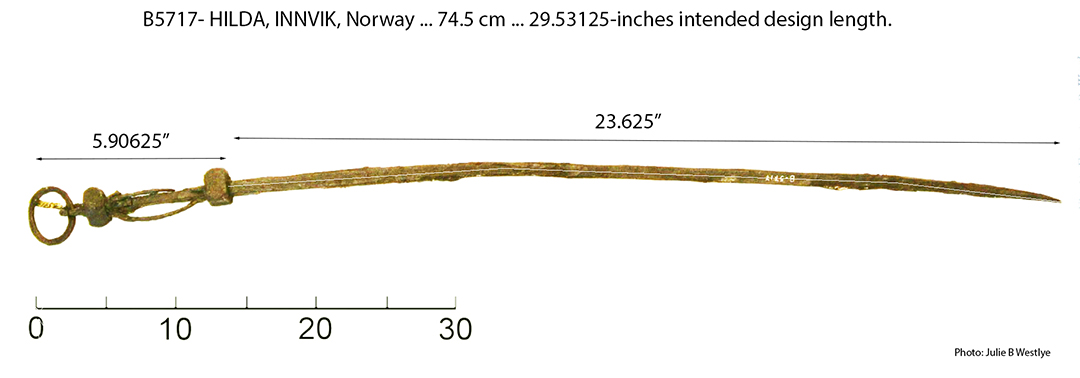
The published length of Volva-Seidr rod B-5717 is rounded to 74.5 cm, which converts to 29.331-inches. This is tantilisingly close to the very common, repetitive lunar-month encoding of 29.53125-days, rendered in inches.
The shortfall over the entire rod's length amounts to .2 of an inch (1/5th of an inch or 5 mm).
This could infer the loss of some metal through corrosion or rounding out of the official measurement. One aspect that may have contributed to this shortfall is that the end ring is angled in a downwards position to the surface upon which the artefact and its accompanied scale bar was measured.
Whatever the reason for the minor shortfall, the evidence of a series of code-bearing increments, culminating in the lunar code of 5.90625" through the handle segments, suggests that a lot of forethought went into the overall design ... 23.625" (the iron rod) + 5.90625" (the handle) = 29.53125" (the overall length).
There seems to be no academic acceptance or recognition that significant code-bearing measurements may exist within the dimensions of these staffs or segments thereof. Therefore, a more relaxed approach seems to prevail where "rounded", close-proximity measurements are considered sufficient to describe these curiosities, viewed only as paraphernalia related to office or status. But, in reality, nothing could be further from the truth, as there are scientific instruments of precision.
The iron rod was designed to encode 23.625" and a mathematical progression based upon this goes:
23.625, 47.25, 708.75, 94.5, 118.125, 141.75, 165.375, 189, 212.625, 236.25, 259.875, 283.5 ... 354.375, 378 ... 425.25 ... 567, 590.625... 756 ... 850.5 ... 1134 ... 2268 ... 2551.5 ... 2953.125 ... 3024 ... 6804.
It can be readily seen that the progression is strongly lunar and provides all the periods leading up to the 2551.5-days (7.2 lunar years) monitored within the Sabbatical Calendar system, all the way to the end of the 6804-day lunar nutation cycle. Also, navigational numbers associated with the base dimensions of the Great Pyramid are represented, including a minute, degree of arc and all the way up to the equatorial circumference of the Earth @ 130636800'.

The handle, when measured within the scaled environment of AutoCAD seems, convincingly to comply to .72" + 2.88"= 3.36" + .6" = 4.2" + .66" = 4.86" + 1.05" = 59.1 (read as 59.0625 by the staff-bearer).
Therefore: 23.625" (the iron rod) + 5.90625"(the handle) = 29.53125".
The Volva-Seidr owner of this staff would have been an expert in predicting upcoming weather conditions within the 6804-day lunar nutation cycle or when to plant, harvest or catch fish by a lunar calendar.
Numbers generated by the lineup of handle segments are all beginning values in very important mathematical progressions ... again, very clever, well thought out coding.
GAYLE, GASTRIKLAND, SWEDEN
It could easily be accepted that the best, most complete overall, Volva-Seidr staff is the one that was exhumed from a grave at Gayle, Gastrikland, Sweden, however it is unknown if it was associated with a female burial.
Although substantially complete, it's obvious that the hilt pommel had been brutalised, cracked and severely corroded, resulting in the loss of a small amount of its outer surface coating (see fig.1 below).
The official, "rounded" measurement from the tip of the hilt pommel to the flared end of the iron rod (see fig. 3d) is given as 42.5 cm, which converts to 16.73228298-inches. This value is without any significance within the parcel of special numbers used by the Druids, their forebears or the assayers within the great civilisations of antiquity in their Weights, Measures & Volumes standards or incorporated into the grain-weights of their coinage.
If, however, the intended design for the formerly pristine staff equated to 16.8-inches for this section (an increase of 1/15th of an inch ... or 1.72 millimetres), then the rod in its entirety would make perfect sense as a repository of dynamic measurement codes.


The staff lying with the bronze "duck-face" at the rod-end of the handle gazing upwards. The overall configuration of the "duck-head", front and rear (see figs 2a & 2b above), produced differing number codes in measurements to other stations. For this code-bearing deciphering exercise we'll use a high resolution image where design aspects of the duck-head can be seen from both front & rear.

This is a very scientifically advanced rod, inasmuch as it is cleverly encoding both the PHI ratio, as well as the PHI reciprocal. It works like this:
(1). The pommel section was intended to be .62", but also, for mnemonic recall, inferred .618034". The PHI reciprocal value, used in the fabrication of the Swedish Tunnah volume tub for dry goods (grain), was 6.18034-inches and 4 such increments provided the diameter for the circular base (2.47216-feet). With barrel sides extending 1-Celtic cubit (21-inches) above the base floor, the exact capacity of the Tunnah measure was 10080 cubic inches ... Note: 1-second of equatorial arc (as encoded into the base length of the Great Pyramid) is 100.8-feet. To produce the PHI reciprocal value used in marketplace tub fabrication, the formula was 10" ÷ 1.618034 = 6.18034".
(2). The overall length of the actual staff, minus the ring and pendant section, was 16.8-inches. Therefore: 16.8" - .62" (the hilt pommel) = 16.180-inches ... (the PHI ratio is 1.618034 to 1). For mnemonic recall this is PHI refined to the 3rd decimal point, but the staff-bearer would know the simple formula to calculate PHI to whatever degree of refinement she or he considered necessary.
(3). The overall length, pommel to rod end, was 16.8" and this provides the following mathematical progression related to navigation, the lunar nutation cycle, etc.:
16.8, 33.6, 50.4, 67.2, 84, 100.8, 117.6, 134.4, 151.2, 168 ... 201.6 ... 252 ... 268.8 ... 302.4 ...403.2 ... 453.6 ... 604.8 ... 1260 ... 1360.8 ... 6804 ... 130636800.
THE HANDLE & THE RYDAHOLMSALM MEASUREMENT
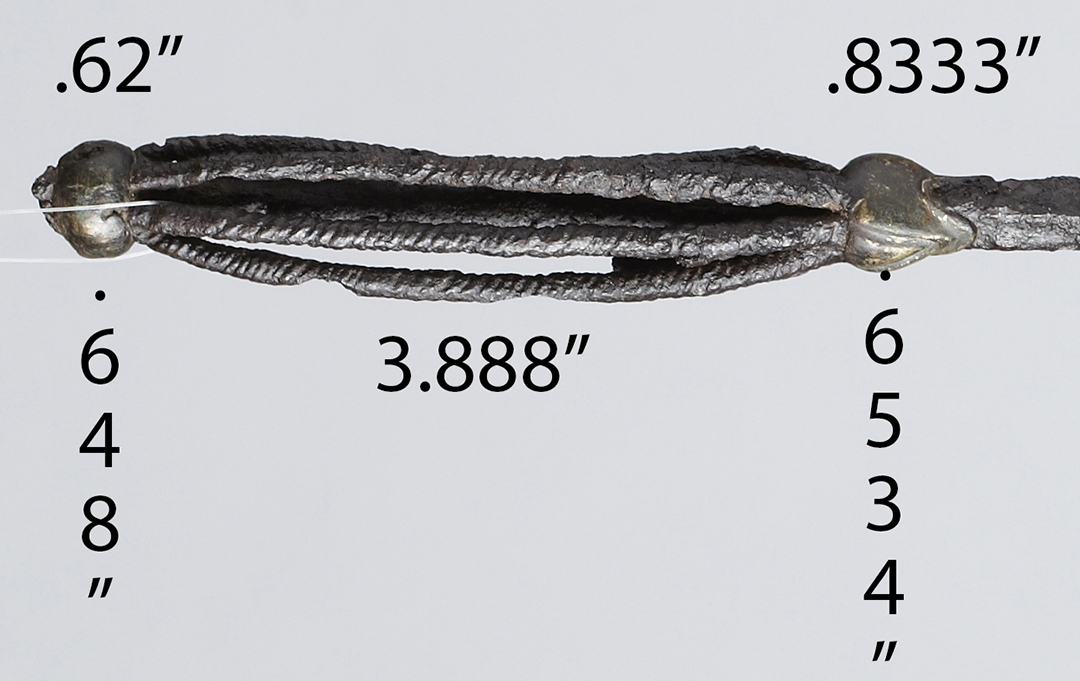
The central handle section, between the hilt-end bronze pommel and the bronze duck head measures 3.888" (also read as 3.8888888).
(1). In the equatorial circumference of the Earth navigational system, coded as 12 X 12 X 12 X 12 X 1.2 Greek miles of 5250' each (24883.2-miles) the sum of 388.8-miles would be 1/64th division.
(2). But the Swedish Rydaholmsalm measurement was 1.944444-feet and 2 Rydaholmsalm = 3.888888-feet. The handle section encodes both 3.888 & 3.88888, as both expressions were used copiously by ancient civilisations.
Here are some examples:
The Roman foot could be read as either 11.664-inches (in volume calculations) of 11.666666-inches for overland measurement. Therefore, their Pace measurement could be rendered as 58.32" (useful in lunar calculations) or 58.333333" (overland marching).
The ancient Gallo-Celtic League was 7466.666666-feet. Author Graham Robb comments how the invading Romans benefited greatly by the wonderful roading systems of Gaul during the Gallic War.
'Yet Caesar found roads and bridges already in place wherever he went. Otherwise one would have to believe the Gauls gave the name 'briva' to about thirty different towns (Brienne, Brioude, Brive, etc.) and then waited for the Romans to come and build the eponymous bridges. In Gaul, the marching speed of the legions was always well above the average for the Roman empire. An army of several thousand Roman soldiers marched from Sens to Orléans in four days, arriving in time to pitch camp and set fire to the city (twenty Roman miles a day) Caesar himself reached Belgic Gaul from somewhere south of the Alps in about fifteen days - (at least twenty-six miles a day). The Gauls were even faster: a battle weary army of a hundred and thirty thousand marched from Bibracte to the territory of the Lingones in just four days (thirty miles a day) which gives some idea of the resilience of the road surface.
In the Asterix cartoons, road-signs indicating a certain number of leagues to the nearest town are supposed to be humorous anachronisms, yet they certainly existed. In seven years of campaigning Caesar always knew he was entering or leaving a tribal territory, and - most telling of all - he always knew the exact distances to be covered. Distances in Gaul were so accurately measured and so comprehensively plotted that even after the conquest, the Romans continued to use a standardised Gaulish league instead of the Roman mile.' (See: The Ancient Paths, pp 28-29, by Graham Robb, 2013, ISBN 978-1-4472-2976-6 TPB).
The Gallo-Celtic league @ 7466.66666-feet of 12-inches equates to:
(1). 3840 Rydaholmsalm of 1.9444444-feet.
(2). 1.536 Roman overland miles of 5000 Roman feet each (11.666666").
(3). 1.422222 Greek miles.
(4). There would be 4.6875 (4 & 11/16ths) Gallo-Celtic leagues in a Swedish Mil of 35000-feet.
(5). There would be 7000 Pied Du Roi of 1.0666666-feet in a Gallo-Celtic league
(6). There would be 328125 Pied Du Roi in a Swedish Mil of 35000-feet (18000 Rydaholmsalm). Oops! ... that pesky ancient metre again @ 3.28125-feet (39.375-inches).
MORE ABOUT THE HILT POMMEL
The hilt pommel seems to code a depth measurement of .648". If this proves to be the true design measurement, then it also has mnemonic significance to both the PHI ratio and the Swedish Rydaholmsalm.
A mathematical progression based upon .648 goes:
.648, 1.296, 1.944, 2.592, 3.24, 3.888, 4.536, 5.184, 5.835, 6.48, 7.128, 7.776, 8.424, 9.072, 9.72, 10.368 ... 11.664 ... 16.2 ... 19.44.
The side length of the Great Pyramid @ 756 = 46.6666666' X 16.2.
(1). The copious use of 1.62, 16.2, 162, etc., as incremental values within ancient edifices suggests a "rounded" form of PHI @ 1.618034. This preoccupation of using "rounded" expressions of both PHI & PI within ancient metrology systems seems to have been a common practice. Here are some examples:
The inner rim of the Sarsen Circle at Stonehenge has a diameter of 100.8-feet one way and 100-feet @ 90-degrees opposed. A 100' diameter circle would, of course, generate a PI related circumference of 314.6-feet. This could represent half a Greek stadia or stadium of 315-feet (1 stadia = 630'). The Roman rendition of PI was 25/8ths or 3.125. This shows up again in the ratio between an ancient English mile (5280') and league (16500'...or 3.125-miles).
Other ancient forms of PI were 1728/550ths (encoded into the 90-degrees opposed, elliptical base diameters of manmade Silbury Hill), where one cross measure is 550-feet, while the circumference is 1728-feet. The other cross measure is 525-feet (a Greek short stadia) and the circumference generated was considered to be 1650' (100 rods or perches) ... 1650/525ths = 22/7ths.
These forms of PI were used with various number families to generate perfect number circumferences used in navigation. Thus, 1-Greek* mile leg of travel at sea (5250') @ 22/7ths = 16500 (an English league of circumference) or 550-inches per degree of arc. If voyaging at sea according to English leagues of 16500-feet, then 1728/550ths was used. Therefore 16500' X (3.141818182) = 51840' or 144' per degree of arc.
*Note: These very ancient measurements existed at Avebury Henge in Britain or other Megalithic Age sites for thousands of years before there was a "Greek" civilisation. Greek & Roman metrology systems were adopted from much older civilisatons.
THE BRONZE DUCK HEAD.
This appears to be .833333" long and .6543" deep. A mathematical progression based upon .833333 goes:
.83333, 1.6666, 2.5, 3.3333, 4.16666, 5, 5.83333, 6.6666, 7.5, 8.3333, 9.16666, 10 ... 11.6666.
A mathematical progression based upon .6534 goes:
.6534, 1.3068 ... 130680000 (the equatorial circumference of the Earth under the 24750-miles system of 5280-feet each).
There are several stations on the duck's head, front and rear, from which code-bearing measurements are extracted. These include:
Front: from the top of the head; from the eyes; from the base of the beak.
Rear: where the skull base meets the knap of the neck; stations at points of a chevron "V" casting.

From the base of the duck's skull at the rear to the oblong ferrous metal station on the rod shaft. The length codes are:
(1). 9.72" ... also read as 9.72222. This is half of 19.4444" and the Swedish Rydaholmsalm was 1.944444-feet. The sum of 97.2-miles would be 1/256th of the 24883.2-mile equatorial circumference.
(2). 9.9" to the centre of the oblong. There would be 1.5 chains of 66' in 99'. The sum of 99' would be 18 Merchant Navy fathoms of 5.5'.
(3). The next measurement extends to the far side of the oblong. A distance of 100.8'would equate to 1-second of equatorial arc in a world of 24883.2-miles of 5250' (Greek miles).

Although the duck eyes can't be seen in this picture, their position was measured from the base of the beak and the location is marked by the yellow circle. From the eyes to the end of the rod, not counting the pendants, is 11.88-inches.
The ancient Scottish mile was 5940' and 2-Scottish miles = 11880-feet. There would be 11000 X 11880-feet (2 scottish-miles) in the 24750-English mile equatorial circumference (130680000-feet or 22000 Scottish miles).
From the base of the duck's beak to the end of the rod is 11.45833333" (11 & 11/24ths). A mathematical progression based upon this value goes:
11.4583333, 22.916666, 34.375, 45.83333, 57.2916666, 68.75 ... 137.5 ... 206.25 ... 275 ... 24750.
The sum of 68.75-miles is 1-degree of equatorial arc in the 24750-mile (of 5280') circumference of the world and 11.4583333-miles is 1/6th of 1-degree (60500') or 10-minutes of equatorial arc. The sum of 11.4583333-miles is 1/ 2160th of the equatorial circumference under that navigational system.
THE RING PENDANT

The National Museum of Denmark, where the Gayle, Gastrikland staff is housed, give the dimensions of the ring attachment as 3.9 cm outer diameter and 3 cm inner diameter. This would translate to 1.536" OD and 1.18125" ID.
A mathematical progression based upon 1.536 goes
1.536, 3.072, 4.608, 6.144, 7.68, 92.16 ... 230.4 ... 384 ... 414.72 ... 460.8 ... 691.2 ... 1152 ... 12441.6 ... 24883.2.
The sum of 153.6 miles would equate to 1/162nd of the Earth's equatorial circumference under the 24883.2-mile (of 5280') assignment. Under this navigational system 1-degree of equatorial arc would be 69.12-miles of which 1.536-miles would be 1/45th division.
The inner diameter of the ring equates to 1.18125" and this is lunar coding. A mathematical progression based upon 1.18125 goes:
1.18125, 2.3625, 3.54375, 4.725, 5.90625, 7.0875 ... 9.45 ... 11.8125 ... 14.175 ... 18.9 ... 28.35 ... 29.53125 ... 354.375 ... 378 ... 756 ... etc.
The sum of 118.125-days is 4 lunar months of 29.53125-days ... or 1/12th of 354.375-days (the lunar year).
MORE PENDANTS
Each of the pendants, like every other station through segments of the staff, will contain measurement codes. Based upon the high resolution photos supplied, here is an estimate of the intended, inbuilt measurements of two pendants attached to the Gayle staff. The finalised determinations will, however, need to be done at the museum where the artefact is housed.
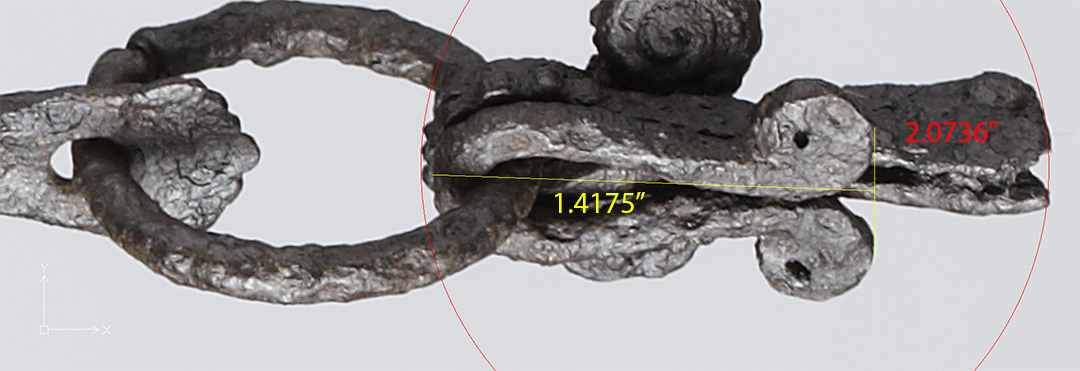
A scaled red line encircles the straight pendant and seems to resolve to 2.0736". The largest Egyptian Royal Cubit found by Petrie was 1.728' or 20.736". A mathematical progression based upon 2.0736 goes:
2.0736, 4.1472, 6.2208, 8.2944, 10.368*, 12.4416 .... 24883.2. *Note: The Earth @ a circumference of 24883.2-miles would spin at 1036.8 MPH in 24-hours.
This progression encodes divisions of the equatorial circumference of the Earth and 24883.2-miles ÷ 20.376 = 1200. In other words, the cubit @ 20.736" was a memory device for recalling the equatorial size of the Earth.
The torque pendant on the same ring seems to measure 1.4175" and a mathematical progression based on this goes:
1.4175, 2.835, 4.2525, 5.67, 7.0875, 8.505 ... 11.34 ...17.01 ... 22.68 ... 25.515 ... 34.02 ... 354.375 ... 6804.
This progression provides all the essential lunar cycle information for a lunisolar Sabbatical Calendar system, including tracking the duration of the 6804-day lunar nutation cycle.
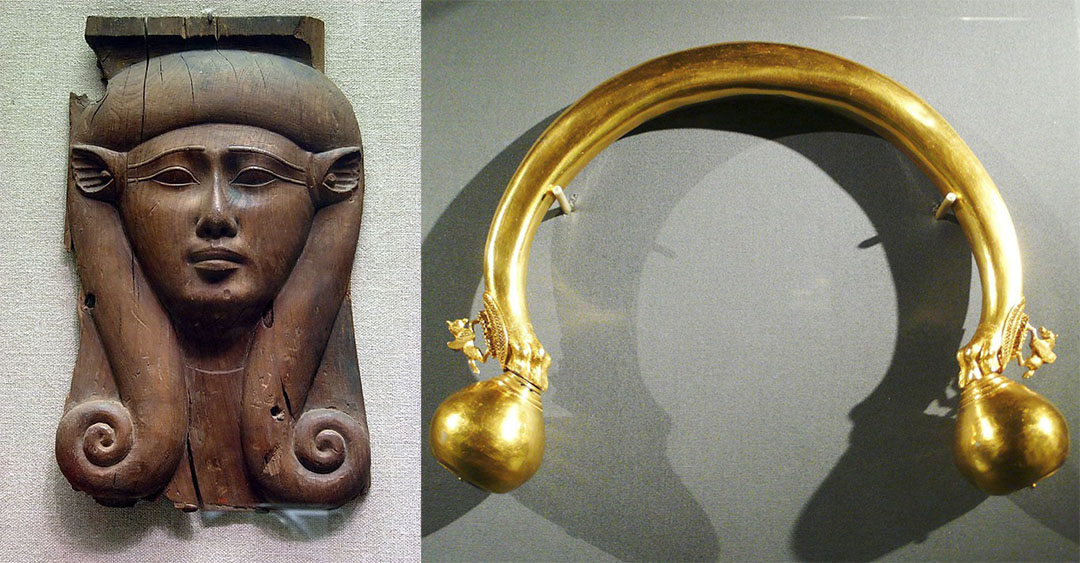
The torque pendant is reminiscent of the goddess Hathor of Egypt with her styilised hair design. The spiral curled ends represent winter and summer solstice positions of the sun, with the nose-bridge and centre forehead representing the equinox position ... in the never ending journey of RA the sun god.
Similarly, the Celtic torque from the grave of the Princess of Vix, Gaul, shows the Pegasus horses of the sun-god Helios flying from the solstice positions to the equinox at the centre top of the torque.
The same cultural symbolism can apply to the lunar cycle, which in a 6804-day cycle, goes from lunar major standstill to lunar minor standstill, then back again.
JULIUS CAESAR HIMSELF VERIFIED THAT ALL THE ABOVE WAS BEING TAUGHT WITHIN THE GREAT DRUIDIC SCHOOLS
He wrote the following regarding the late era Druids of his time (circa 55 BC) and tutorials within their many universities.
'They also lecture on the stars in their motion, the magnitude of the Earth and its divisions ...' (see De Ballo Gallico, VII, 15, 16.).
Historian, Isabel Hill Elder further writes,
'The students at these colleges numbered at times sixty thousand of the youth and young nobility of Britain and Gaul. Caesar comments on the fact that the Gauls sent their youth to Britain to be educated .. .It required twenty years to master the complete circle of Druidic knowledge. Natural philosophy, astronomy, mathematics, geometry, medicine, jurisprudence, poetry and oratory were all proposed and taught - natural philosophy and astronomy with severe exactitude' (Elder refers to Strabo I IV, page 197. Caesars Comm. Lib V. Sueotonius, V Calegula. E. Campion, Accounts of Ireland, pg. 18.).
SO, WHAT'S THE SIGNIFICANCE OF ALL THE "DUCK-HEAD" RELATED IMAGERY ADORNING SEVERAL VOLVA-SEIDR STAFFS?

(1). Staff located at Borgholm, Oland and called the Klintstaven staff. It has 6-duck heads circumnavigating the rod end of the handle, which gaze back towards the hilt.
(2). Staff called Borko 760. It has a duck head on each side of the handle that gaze down the length of the ferrous metal rod to the point.
(3). Staff found at Gayle Gastrikland. Like Borko 760, it has a single duck head with features extending to each side, from which code-bearing measurements are made. The eyes of the duck gaze towards the end of the ferrous metal rod.
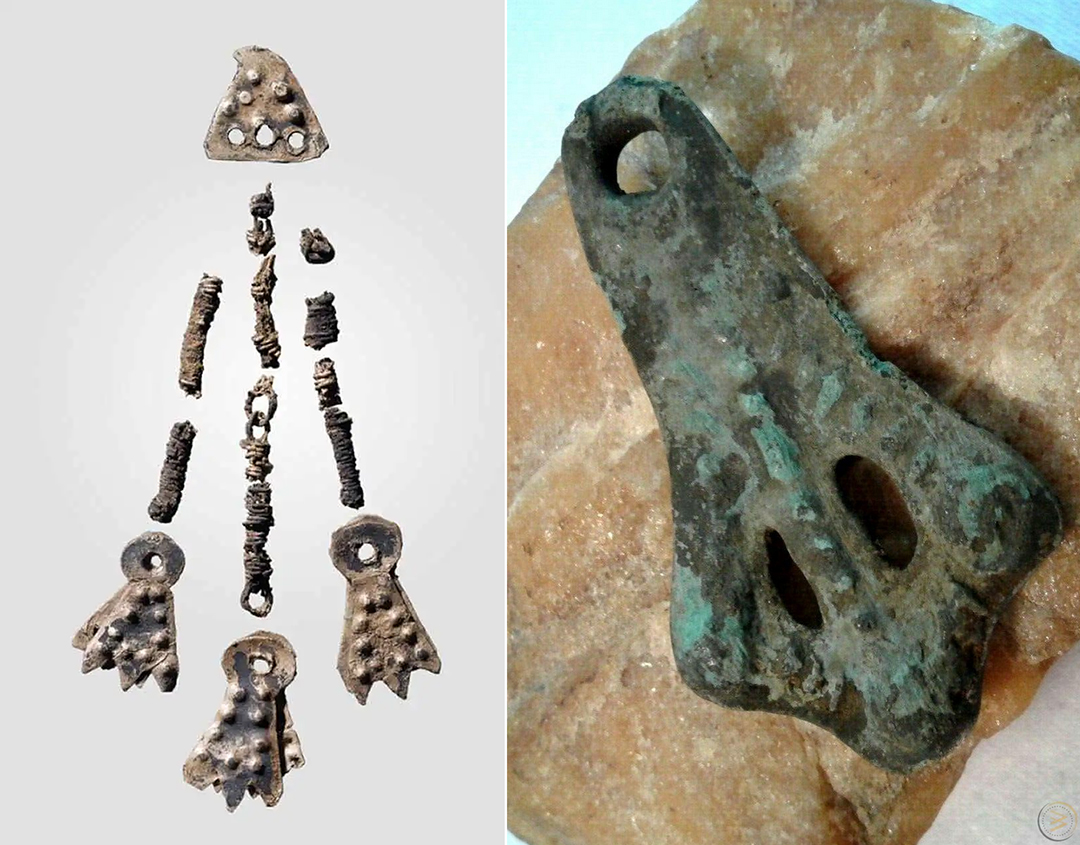
These images of ancient Scandinavian pendants representing duck's feet infer that the duck was a revered bird. The pendant to the left was found amidst the grave-goods associated with a Volva-Seidr seeress at Fyrtak, Denmark. The one on the right is "Viking-Age" and quite typical of similar finds in northeastern Russia.
FRIGGA THE MOTHER GODDESS.
In many respects the attributes of the Volva-Seidr, wise-women mirror the attributes of the Scandinavian goddess Frigga, wife of Odin and they appear to have modeled themselves on Frigga in terms of their daily roles and responsibilities in serving the public-good.
The Volva-Seidr staffs are often compared with "spinning-staffs" and have, in times past, been categorised as such, until it was realised that they could not function in that capacity of spinning raw clumps of fleece into thread for garments. However, in a symbolic or spiritual sense the Volva-Seidr practitioners were seen as oracles from which the soothing threads of truth, healing and prophecy could be sourced, in order to weave a successful outcome in life for those who adhered to their counsel.
Some present views, that place negative connotations over Seidr practices and label these wise-women as witches, infer that the Volva-Seidr were "weaving the fates of mortals". However, the very positive encoding of profound & helpful sciences within the wands attests to the fact that Seidr functions were clearly benign and friendly.
The goddess Frigga was strongly associated with spinning and weaving, foresight and protection, especially for babies, children and mothers .... and like Frigga, Seidr practioners were accompanied by an entourage of handmaid helpers.
'She is a goddess of atmospheric, life-giving moisture, whether the clouds in the sky, or the mists that rise off the waters. Her sacred places are wetlands, marshes, swamps, ponds and other cradles of life, places associated with motherly, fertile energy. Her otherworldly hall, Fensalir, is said to be in the fens of Ásgard. All water fowl are hers, including herons, cranes, osprey, ducks, swans, and especially geese'.
(See: http://ydalir.ca/norsegods/frigga/ )
It would not be out of character for vicarious representatives of Frigga to use Duck or Goose symbolism on their memory-device, number-encoding wands, which contained the essential scientific information needed for abundant-living, survival and the best chance possible to get through hard times.
From a purely spiritual perspective, based upon old Norse religious beliefs, the duck could be said to inhabit 3-worlds:
(1). The underworld, is the location of Valhalla or Hel, where the dead reside, engaged in the same activities as they enjoyed in life. In many pre-Christian cultures the after-life was entered by diving under a lake or the sea. Ducks, of course, spend much of their time diving below the pond or lake waters to forage.
(2). The mortal world or terra-firma, where ducks nest, lay their eggs and live out their days. Here, their conditions are akin to those of mankind.
(3). The upper world, beyond the reach of mankind, where ducks could soar and navigate to new climes seasonally, free from the shackles and limitations of earthbound humans.
It seems that "ducks", in some respects, epitomised or personified the identity of Frigga ... and Volva-Seidr women then adopted that cultural-religious symbolism to show that they acted in the capacities and roles of Frigga.
To be continued.
Martin Doutré, January 1st, 2023 ©